| Information |  | |
Derechos | Equipo Nizkor
| ||
| Information |  | |
Derechos | Equipo Nizkor
| ||
09Mar16
Final report of the Panel of Experts on Libya regarding the implementation of the measures related to the arms embargo, the assets freeze and the travel ban
Back to topUnited Nations
Security CouncilS/2016/209
Distr.: General
9 March 2016
Original: EnglishLetter dated 4 March 2016 from the Panel of Experts on Libya established pursuant to resolution 1973 (2011) addressed to the President of the Security Council
The Panel of Experts on Libya established pursuant to Security Council resolution 1973 (2011) has the honour to transmit herewith, in accordance with paragraph 24 (d) of resolution 2213 (2015), the final report on its work.
The report was provided to the Security Council Committee established pursuant to resolution 1970 (2011) concerning Libya on 29 January and was considered by the Committee on 3 March 2016.
The Panel would appreciate it if the present letter and the report were brought to the attention of the members of the Security Council and issued as a document of the Council.
(Signed) Savannah de Tessières
Coordinator
Panel of Experts on Libya established pursuant to resolution 1973 (2011)(Signed) Naji Abou-Khalil
Expert(Signed) Jan Barend Coetzee
Expert(Signed) Simon Dilloway
Expert(Signed) Juan Alberto Pintos Servia
Expert(Signed) Steven Spittaels
Expert
Final report of the Panel of Experts on Libya established pursuant to resolution 1973 (2011)
Summary Five weeks after the signing of the Libyan Political Agreement on 17 December 2015, uncertainty remains around the endorsement of the Government of National Accord by the House of Representatives and its establishment in Tripoli, highlighting the divisions that have threatened the United Nations-brokered political dialogue throughout 2015.
In support of the Government of National Accord, the Security Council adopted resolution 2259 (2015), by which it explicitly delegitimized all parallel institutions falling outside the Libyan Political Agreement, thereby providing the Panel of Experts on Libya with a clearer benchmark against which to report on acts undermining the political transition. The Panel has identified groups and individuals having consistently refused to engage in the political dialogue in 2015. While the leadership of the General National Congress boycotted several meetings of the political dialogue and prevented any vote on it from being held, the leadership of the House of Representatives has played an increasingly negative role since October 2015.
Meanwhile, armed conflict persists, resulting in a dire humanitarian situation. In Tripoli, clashes between armed groups have been occurring on an almost weekly basis, especially in the second half of 2015. Whereas initially clashes continued between the two major military alliances in Libya, the Libyan National Army and Operation Fajr, most of the fighting later became a mix of revenge attacks, banditry and infighting within Operation Fajr. The number of combat incidents in the east remains very high. In Benghazi, the Libyan National Army has continued its operations against the Benghazi Revolutionaries Shura Council and affiliated groups, which include United Nations-listed terrorist entities. Fighting has spread to new cities, including Kufrah in July 2015 and Ajdabiya in December 2015. Local conflicts in the south have been further exacerbated by regional interference and competition between the two Governments to build alliances with local groups and recruit foreign combatants.
The political and security vacuum has been further exploited by Islamic State in Iraq and the Levant (ISIL), which has significantly expanded its control over territory. In Sirte, ISIL successfully recruited from among communities marginalized since the ousting of the Qadhafi regime. In Tripoli and Sabratah, it increased its operational capacity through local recruitment and reinforcements with foreign fighters. While ISIL does not currently generate direct revenue from the exploitation of oil in Libya, its attacks against oil installations seriously compromise the country's economic stability. Libyans have increasingly fallen victim to the terrorist group's brutalities, culminating in several mass killings.
Violators of human rights and other criminals continue to act with total impunity, especially in the absence of a formal security sector and in the light of international hesitancy to intervene, as shown by the lack of new investigations by the International Criminal Court or of any new sanctions designations since 2011. Various armed actors are de facto filling some of the vacuum, resulting in arbitrary detention and severe abuses in prisons throughout Libya.
The continuation of armed clashes and the expansion of ISIL have led to an increase in demand for military materiel. Illicit transfers to State and non-State armed actors continue, including with the support of some Member States, mirroring regional rivalries that have been fuelling the instability.
The Libyan market remains attractive to brokering companies that do not appear to be deterred by the arms embargo. Most negotiations concern surplus stocks, i.e. materiel that is readily available from wholesalers in Eastern Europe.
The continuous violations of the arms embargo are having a negative impact on the security situation in Libya and its political transition: better-equipped armed actors may be less inclined to agree to ceasefires or to accept the authority of the future Government of National Accord and its security arrangements.
The risk of diversion and misuse of materiel will remain very high, regardless of the formation of the Government of National Accord. The current arms embargo provisions, which allow exemptions for the Government, should remain in place and be enforced, so as to prevent non-State actors from procuring materiel. The future Government of National Accord should have a single procurement channel accompanied by substantive and verifiable arms control measures to avoid diversions inside and outside the country. Libya remains a source of logistical support and arms for armed groups, including terrorist groups, in the region.
Regarding the financing of Libyan armed groups, government salaries are continuing to be paid to enlisted combatants, regardless of their human rights record or their ties with spoilers or terrorist groups. Armed groups and criminal networks have further diversified their sources of financing, including through kidnapping and the smuggling of migrants, oil derivatives and subsidized goods, as well as profits from foreign currency exchange schemes.
The Libyan financial system has been weakened by the competition between the two rival Governments over the control of State financial institutions. The policies of the Central Bank in 2015 reflected its physical proximity to Operation Fajr and the General National Congress, showing a more lenient attitude towards the priorities of Tripoli. Subsequently, the interim Government stepped up its attempts to gain control of the financial system, further undermining the unity of the institution. The current state of the financial system is no longer tenable and it urgently needs oversight from, and protection by, the Government of National Accord.
While the duplication of the National Oil Corporation and the control of oil facilities by armed groups have had a significant impact on the country's primary source of revenue, no illicit export of crude oil has ever been reported by the Libyan authorities to the Security Council Committee established pursuant to resolution 1970 (2011) concerning Libya, nor has any evidence of such exports been provided to the Panel. The risk of illicit exports and of misappropriation of Libyan oil revenue persists, however, and the provisions of resolution 2146 (2014) are not implementable.
Lastly, sanctions adopted in 2011 against individuals from the Qadhafi regime continue to be breached. Large amounts of hidden assets remain unfrozen and the travel ban has repeatedly been violated, indicating that the measure continues to be ignored by some Member States and listed individuals. With regard to the assets of designated Libyan entities, while they should remain frozen, their value should be protected against deterioration.
Contents
A. Mandate and appointment
B. Methodology
C. Cooperation with stakeholders and organizations
D. Administrative support and reporting scheduleII. Political developments and related criteria
A. Political dialogue
B. Regional actors and impact
C. Acts that obstruct or undermine the successful completion of the political transitionIII. Security developments and related criteria
A. Events in the west
B. Events in the east
C. Events in Sirte and the central region
D. Events in the south
E. Security-related designation criteriaA. Arbitrary detention and torture
B. Mass killings
C. Obstruction of the delivery of humanitarian aid
D. Kidnappings, bombings and extrajudicial killingsV. Implementation of the arms embargo
A. Overview
B. Transfers of materiel to Libya during the revolution (February-September 2011)
C. Transfers of materiel after the revolution (September 2011-August 2014)
D. Transfers or potential transfers of materiel to Libya since the strengthening of the arms embargo (August 2014)
E. Transfers of materiel from LibyaA. Central Bank
B. Libyan Investment Authority
C. National Oil Corporation and implementation of measures on crude oil
D. Other State institutionsVIII. Implementation of the asset freeze
A. Stolen assets
B. Frozen assets of designated entities
C. Implementation challenges: implementation assistance notice
D. Exemptions to the asset freeze
E. Request for guidance
F. Current investigations
G. Forged Committee letterIX. Implementation of the travel ban
A. Current investigations into violations of the travel ban
X. Recommendations
B. Exemption and delisting requests
C. Implementation assistance notice
I. Background1. An overview of the evolution of the Libya sanctions regime can be found in annex 2.
A. Mandate and appointment
2. Details on the mandate and appointment of the Panel of Experts on Libya can be found in annex 3.
B. Methodology
3. The Panel is determined to ensure compliance with the standards recommended by the Informal Working Group of the Security Council on General Issues of Sanctions in its report (S/2006/997, annex). Those standards call for reliance on verified, genuine documents and concrete evidence and on-site observations by the experts, including taking photographs, wherever possible. When physical inspection is not possible, the Panel seeks to corroborate information using multiple, independent sources to appropriately meet the highest achievable standard, placing a higher value on statements by principal actors and first-hand witnesses to events. While the Panel wishes to be as transparent as possible, in situations in which identifying sources would expose them or others to unacceptable safety risks, the Panel will withhold identifying information and place the relevant evidence in secure United Nations archives.
4. The Panel is committed to impartiality in investigating incidents of non-compliance by any party.
5. The Panel is equally committed to the highest degree of fairness and will endeavour to make available to parties, where appropriate and possible, any information available in the report for which those parties may be cited in relation to incidents of violations or non-compliance, for their review, comment and response within a specified deadline.
6. The Panel safeguards the independence of its work against any efforts to undermine its impartiality and to create a perception of bias.
C. Cooperation with stakeholders and organizations
1. Member States
7. Since the publication of its previous final report (S/2015/128), in February 2015, the Panel has undertaken visits to meet national authorities and/or other relevant actors in Belgium, Egypt, France, Greece, Israel, Italy, Jordan, Lebanon, Libya, Malta, the Niger, Qatar, Tunisia, Turkey, Uganda, the United Arab Emirates, the United Kingdom of Great Britain and Northern Ireland, the United Republic of Tanzania and the United States of America. For a list of entities and officials consulted during the visits, see annex 4.
8. The very limited access to Libya notwithstanding, the Panel was able to meet Libyan stakeholders during its visits to the region, especially in Istanbul, Turkey, to which the Panel travelled twice, Cairo (three times) and Tunis (five times).
9. The Panel has faced difficulties in gaining access to some countries that hold critical information relating to the implementation of the measures, including Algeria, Chad and the Sudan.
10. The Panel has sent 147 official communications since the submission of its previous report (see annex 5), which were responded to with varying degrees of cooperation by Member States, with some not replying at all (see annex 6).
2. Libya
11. The Panel made continuous efforts to travel to Libya during its current mandate, but managed to do so only once. Having been unable to travel to Libya since the evacuation of the United Nations Support Mission in Libya (UNSMIL) in July 2014, the Panel eventually visited Tubruq in July 2015. There, the Panel met representatives of the House of Representatives, the interim Government, the Chief of Staff and other senior military officials and representatives of the National Oil Corporation, the Central Bank and the Civil Aviation Authority. With the support of the Secretariat, UNSMIL and the Department of Safety and Security, the Panel organized three other visits to cities in the west and east of Libya and travelled to Tunis on three separate occasions for that purpose. The Panel was, however, forced to cancel its travel on each occasion at the last minute owing to security or political difficulties. On 18 September 2015, a trip to Misratah was cancelled because the authorities in Tripoli did not authorize the Civil Aviation Authority to clear the Panel's flight, while on 4 November the Department of Safety and Security decided to cancel the mission because of fighting on the ground. Lastly, the Panel was due to travel to Libya on 1 December, but, owing to logistical issues, including the implementation of Umoja at Headquarters, the visit could not proceed.
12. Following the duplication of the country's institutions, the Panel has made a point of interacting with parties from all sides. Following its visit to Tubruq, it met representatives of the General National Congress and of the Office of the Prime Minister of the National Salvation Government, Khalifah Ghwel, outside Libya. The Panel also met representatives of the Central Bank and the National Oil Corporation based in Tripoli and Bayda. At the military level, it met and interviewed representatives of the Libyan National Army (LNA) and representatives and members of armed groups from Awbari, Benghazi, Kufrah, Misratah, Sabha, Sabratah, Tripoli and Zintan.
3. United Nations and other entities
13. The Panel met the Special Representative of the Secretary-General and Head of UNSMIL, Martin Kobler, in December and had regular exchanges with key sections of UNSMIL during its mandate. The Panel's visit to Tubruq was essential to its work, and it is grateful for the logistical support provided by the Secretariat, UNSMIL and the Department of Safety and Security. The Panel hopes that access to Libya will become easier in the near future and will continue to seek assistance from UNSMIL in that regard.
14. Regarding cooperation and interaction with other United Nations bodies, the Panel has exchanged views with the Analytical Support and Sanctions Monitoring Team established pursuant to resolution 1526 (2004), in particular regarding its report prepared in accordance with paragraph 13 of resolution 2214 (2015) (S/2015/891). The Panel is also in regular contact with other United Nations sanctions monitoring teams, in particular those working in Africa.
15. During its most recent visit to Tunis, the Panel met members of the investigation of the Office of the United Nations High Commissioner for Human Rights on Libya. The Panel also met representatives of the International Maritime Organization (IMO), the International Organization for Migration, the Office of the United Nations High Commissioner for Refugees, the International Monetary Fund (IMF) and the World Bank. The Panel also contacted representatives of the International Criminal Court (ICC).
D. Administrative support and reporting schedule
16. The Panel's work was severely hampered by the implementation at Headquarters of Umoja, which led to the cancellation of four fact-finding missions. Three months after its implementation, Umoja is still having a negative impact, including in terms of salary and expense arrears and difficulties in arranging travel.
17. Furthermore, owing to the increased demand on the Secretariat, the Panel had no dedicated support staff for nine months, resulting in reduced efficiency until December 2015. The environment of budgetary austerity notwithstanding, the Secretariat needs to be adequately resourced to ensure that the Panel receives appropriate support to conduct its mission.
18. Notwithstanding the Panel's frequent travel to high-risk environments in which it conducts sensitive investigations under a mandate from the Security Council, its members continue to lack adequate diplomatic protection and provisions for risk mitigation. This extends to insufficient protection of confidential information gathered by the Panel in the course of its travels and investigations (see recommendation 26).
19. Effectively, the experts' 12-month contracts allowed for only 7 months of investigations, owing to the onboarding process, the induction process, the lead time required to issue tickets and the time required for the translation of the Panel's two reports. This significantly reduced the time available for the Panel to perform its work. To afford the Panel adequate time, it suggests an 18-month mandate (see recommendation 22).
II. Political developments and related criteria
A. Political dialogue
20. Throughout 2015, UNSMIL continued to mediate between the main political and military alliances in Libya in an attempt to restart the political transition. After February, the negotiations were mainly held in Skhirat, Morocco, and the process was generally referred to as "the political dialogue". A second track, focusing on security arrangements, was also initiated, but many challenges remained as at early January 2016, when the present report was drafted.
21. Details of how the political transition was to be revived were revealed in late April 2015 when the United Nations mediation team presented a third draft political agreement. The text was immediately and widely rejected by politicians affiliated with Operation Fajr. The House of Representatives declared on social media its "preliminary" approval, pending certain "amendments". A fourth draft, released on 8 June, resulted in about the opposite situation. Reservations on the part of members of the General National Congress were overshadowed by an overwhelmingly negative response from the House.
22. On 11 July 2015, at the signing ceremony for the fifth draft, presented as a preliminary framework agreement, all the dialogue participants signed, apart from the representatives of the General National Congress. The participation of representatives of the Congress, which had already been irregular, further decreased after the resignation of the delegation leader, Saleh Makhzoum, and a reshuffle of the negotiation team in August.
23. The preliminary framework agreement evolved into a final version that was transmitted by UNSMIL to the main stakeholders for endorsement on 11 October 2015. Annex 1 to the text included six names of appointees for a transitional nine-member presidency council, including the Prime Minister, Fayiz al-Sarraj. Subsequently, the heads of the House of Representatives and the General National Congress prevented any vote on the text in their assemblies. Meanwhile, confusion over the legitimate Government increased when the House extended its own mandate beyond 20 October, a move that did not elicit a clear reaction from the international community.
24. In November 2015, the General National Congress sought to reset the entire negotiation process. When Bernardino Leon was due to be replaced as Special Representative of the Secretary-General and Head of UNSMIL, it was indicated in a series of seemingly coordinated international press articles that he had a conflict of interest and was potentially biased. |1| Subsequently, members of the Congress demanded clarification, together with changes in the UNSMIL composition. In addition, the Congress leaders launched a new dialogue initiative in Tunis in coordination with members of the House of Representatives. However, Martin Kobler, who assumed the leadership of UNSMIL on 17 November, refused to change the text of 11 October (and the Presidency Council nominees) and only "took note" of the parallel talks. |2|
25. The Libyan Political Agreement was signed on 17 December 2015 in Morocco. It mandated a presidency council to lead a government of national accord, to be presented to the House of Representatives in 30 days and endorsed 10 days later. The Government of National Accord will function under two legislative assemblies: the House of Representatives and a "State council" mainly composed of members of the General National Congress. The Libyan Political Agreement received immediate and strong international support through the adoption by the Security Council of resolution 2259 (2015) on 23 December 2015. However, five weeks after the signing of the Libyan Political Agreement, when the present report was finalized, significant uncertainties remained regarding the endorsement of the Government of National Accord by the House and its establishment in Libya.
B. Regional actors and impact
26. The holding of a ministerial meeting for Libya in Rome on 13 December 2015 and the adoption of Security Council resolution 2259 (2015) have shown that there is unanimous support for the Libyan Political Agreement among regional and international actors.
27. Nevertheless, throughout most of 2015, conflicting regional interests further polarized the political scene. Support and statements by regional Powers exacerbated the security situation. The political divide mirrored the two regional alliances. On the one hand, Egypt and the United Arab Emirates mainly supported the House of Representatives and its allies. Chad, mostly preoccupied by spillover insecurity, reinforced its ties with them. On the other hand, Qatar and Turkey maintained political relations with the General National Congress. Algeria, the Niger and the Sudan also maintained good relations with the Congress, but remained relatively uncommitted. Tunisia, fearing the security repercussions of breaking ties with the authorities in Tripoli, stayed on good terms with both Tripoli and Tubruq.
28. Libya has become increasingly attractive to foreign fighters. They mainly used the Sudan, Tunisia and Turkey as transit countries when travelling to Libya in 2014 and 2015. According to Panel interviews with the Tunisian security authorities in December 2015, Tunisian and European fighters travelled to Libya from Tunisia. Extremists from Africa have transited through the Sudan to join Islamic State in Iraq and the Levant (ISIL) in Sirte and Benghazi. |3|
29. High-profile personalities in Tripoli and Misratah, including officials, have assisted in the arrival of extremist fighters in Libya. The fighters have been hosted in farms and camps in the Tripoli suburbs of Ayn Zarah and Qarahbulli, as well as in other western cities. Some were sent to fight in Benghazi.
30. On the side of LNA, General Khalifah Haftar threatened tribes of eastern Libya that he would replace them with African fighters (i.e. mercenaries) if they did not comply with his request to provide more fighters. |4| Darfuri interviewees indicated that that might have happened. A significant number of Sudan Liberation Army/Minni Minawi combatants were reported to be fighting around Kufrah (see annex 7). |5| The Panel has also received strong evidence that other Darfur-based armed groups have been approached by officials in Tripoli to reinforce Operation Fajr forces.
31. The rise of ISIL in Libya is likely to increase the level of international and regional interference, which could provoke further polarization if not coordinated. In anticipation, ISIL has been spreading a nationalistic narrative, portraying itself as the most important bulwark against foreign intervention. |6|
C. Acts that obstruct or undermine the successful completion of the political transition
32. The Panel interviewed politicians based in Tubruq/Bayda and in Tripoli, other Libyan political figures and diplomats from a wide range of countries closely following the political dialogue.
33. After the total breakdown of the political transition in 2014, the signing of the Libyan Political Agreement has made significant progress towards restoring it. By its resolution 2259 (2015), the Security Council explicitly delegitimized all parallel institutions falling outside the Libyan Political Agreement, thereby providing the Panel with a clearer benchmark against which to report on acts undermining the transition. Previously, it was sometimes difficult to distinguish between what could be considered an acceptable defence of a negotiating position and deliberate spoiler action. Nevertheless, the Panel has identified groups and individuals having consistently refused to seriously engage in the political dialogue, thereby preventing the much-needed restoration of the political transition.
34. The negative impact of the leadership of the General National Congress has been apparent on several occasions. The leaders have boycotted numerous meetings of the political dialogue since its creation; they have authorized or approved controversial military operations, especially in 2014 and early 2015; they have prevented any vote by members on any of the proposed drafts; and they have rejected the Libyan Political Agreement, embarking on a parallel process involving repeated attempts to discredit UNSMIL efforts (see annex 8).
35. The leadership of the House of Representatives has played an increasingly negative role since October 2015, preventing a vote on the Libyan Political Agreement and embarking on a parallel negotiation process (see ibid.).
III. Security developments and related criteria
36. Direct clashes between the two major military alliances in Libya, LNA and Operation Fajr, continued into early 2015, but had stopped by the end of April. The Operation Fajr offensive in the oil crescent against Petroleum Facilities Guard and LNA forces continued until March, after which Operation Fajr disengaged. In Tripoli, the western region of LNA ceased its attempts to "liberate the capital" at the end of April and signed ceasefire agreements with some Operation Fajr components. Nevertheless, widespread insecurity was continuing in the west, east and south as at early January 2016, when the present report was drafted.
A. Events in the west
1. Tripoli
37. In Tripoli, clashes between armed groups have been occurring on an almost weekly basis, especially in the second half of 2015. Whereas initially some of the fighting was linked to the wider conflict between Operation Fajr and LNA, such as the operation against the 101st Battalion, in Tajura', on 16 April, which was endorsed by the General National Congress, it later became a mix of revenge attacks, banditry and infighting within Operation Fajr. |7| Incidents have included the use of heavy artillery and the targeting of public infrastructure, such as the Congress building, the Office of the Prime Minister of the National Salvation Government, the Ministry of Planning, the Ministry of Islamic Affairs and several prisons.
38. Security in Tripoli is linked to evolving alliances among armed groups and their stance vis-a-vis the United Nations-sponsored dialogue. Rifts in the Operation Fajr alliance became apparent on 16 June with the creation of the Sumud ("Steadfastness") Front, a smaller coalition of armed groups refusing any compromise resulting from political negotiations, under the command of Salah Badi.
39. Early in 2016, the division ran along three lines. The first was composed of groups from outside Tripoli, mainly from Misratah, such as the Mahjub and Halbus brigades. They are supportive of the Libyan Political Agreement. The second was composed of Tripoli-based groups that are thought to be in favour of the political dialogue, but have not yet all publicly announced their position on the Libyan Political Agreement. Examples include the Special Deterrence Force, the Nawasi brigade, the Abu Salim brigade and Fursan Janzur. The third was a mix of armed groups from Tripoli and other western cities, composed of hard-line revolutionaries or Islamist militants, which had constituted the core of the Sumud Front earlier in 2015, such as Salah Badi's force, the Buni brigade and other Tajura' -based brigades. They continue to be strongly opposed to the dialogue and the Libyan Political Agreement. Some armed groups, such as the Tawhid brigade, suspected of assisting ISIL in Tripoli, are part of this category. Since the Special Representative of the Secretary-General presented the final text of the Libyan Political Agreement in October, several clashes have occurred between the groups, driving the Operation Fajr coalition further apart.
40. Many civilians have fallen victim to the armed groups' rule. There have been widespread and continuous reports of killings, extortion and, in particular, abductions of politicians, businesspeople, journalists and activists.
41. ISIL has a limited presence in Tripoli, but with a growing capacity to conduct small-scale and improvised explosive device attacks. This is illustrated by incidents such as its raid on 18 September on the prison in Mitiga and the bombing of an oil company headquarters three weeks earlier. Especially worrying is that ISIL can recruit with relative ease in Tripoli, as reported by the Special Deterrence Force. |8| The ISIL modus operandi in Tripoli relies on small (sleeper) cells that often include foreigners. Some of them are infiltrated into established armed groups.
42. The ISIL operational radius extends towards Misratah. A bombing of a coastguard training centre in Zlitan in January 2016 caused more than 80 deaths. In May 2015, ISIL bombed the Dafniyah checkpoint, a few kilometres to the west of Zlitan. |9|
2. Zawiyah and Warshafanah
43. The area immediately west of Tripoli remained restive throughout 2015 and on several occasions the risk arose of a new escalation of fighting between Operation Fajr and LNA (affiliated) forces. Critical incidents included the downing of a helicopter transporting high-ranking military commanders from the National Salvation Government on 27 October 2015. |10| Tensions were repeatedly overcome through local mediation between tribes, sometimes including the participation of representatives from Misratah.
3. Sabratah
44. The western cities of Sabratah, Zaltan and 'Ujaylat are well -known locations for training and transit camps for foreign fighters, whether going to or coming from Libya. Tunisian investigators explained to the Panel that the perpetrators of terrorist attacks in Tunisia in 2015 had all transited at one stage through training camps in Sabratah and 'Ujaylat (see annex 4, para. 36).
45. An ISIL assault on the centre of Sabratah on 10 December 2015 raised fears that another Libyan city could fall under the group's control. An agreement was reached between the municipal council and ISIL, by which the latter committed itself to removing any overt presence from Sabratah and to declaring the presence of any foreigners. It remains to be seen, however, whether the agreement will prevent the growth of ISIL. The bombing of the local General Intelligence branch on 19 December 2015 was, for example, attributed to the group. |11|
46. ISIL cells benefit from their local ties. Foreign fighters are hosted in private residences. They constitute small and mobile groups, mostly concentrated outside urban zones. ISIL has established links with smuggling networks, which helps it to smuggle fighters and arms across the Tunisian-Libyan border.
B. Events in the east
47. Throughout 2015, insecurity in the east remained very high, with large-scale fighting or repeated security incidents in most major towns. Such insecurity threatens the wider region.
1. Benghazi
48. In Benghazi, LNA continued its operations against neighbourhoods controlled by the Benghazi Revolutionaries Shura Council and affiliated groups. The stalemate from late 2014 largely persisted, notwithstanding the announcement by General Haftar of a new operation, Hatf ("Doom"), on 19 September 2015. From September, LNA launched air strikes on Benghazi (and other towns) on an almost daily basis. Its air force also continued to target vessels suspected of transporting arms off the eastern coast (see annex 9).
49. Within Benghazi, LNA attacks targeted the areas of Laythi, Sabri, Suq al-Hut, Gwarsha and Bu Atni and included the use of heavy artillery in an urban setting.
50. The Benghazi Revolutionaries Shura Council and affiliated groups focused their attacks on the same front lines, together with Bu Hadimah and Benina airport. They continued their systematic use of improvised explosive devices and landmines, claiming military and civilian lives, including during demining operations. The Shura Council continued its use of heavy artillery in an urban setting. The mortar shelling of a peaceful protest in Kish Square from territory controlled by the Shura Council left nine people dead and dozens wounded. |12|
51. ISIL has an operational presence in Benghazi, as shown by a series of claims, through its media outlets, of attacks, often in the form of suicide improvised explosive devices, against LNA (see annex 10).
2. Darnah
52. In Darnah, clashes continued between ISIL and other extremist groups. The Darnah Mujahideen Shura Council and ISIL coexisted in Darnah without overt animosity until May 2015, |13| but in June the Shura Council drove ISIL out of the town centre in less than a week. While some groups of the ISIL rank and file defected to the Shura Council, others fled west to Sirte or east to the neighbouring area of Fata'ih. ISIL has retained a presence on the eastern outskirts of Darnah.
53. Meanwhile, LNA operations around Darnah sharply decreased and appear to have been limited to sporadic aerial bombardments of ISIL positions.
3. Ajdabiya
54. On 15 December 2015, LNA and the security directorate in Ajdabiya initiated a military operation against the Ajdabiya Revolutionaries Shura Council. LNA launched air strikes against Shura Council positions, including the strategic checkpoint 60, to the south of the city, which is controlled by a unit from the Zway tribe. The events triggered deadly clashes between local armed groups, which risk degenerating into a long-term tribal conflict. The Shura Council and ISIL-affiliated groups are said to be responsible for an unprecedented wave of assassinations of military officers, Salafist sheikhs and journalists in Ajdabiya in 2015.
4. Regional impact
55. The region witnessed three widely reported and acknowledged international interventions in 2015. In February, Egypt conducted air strikes against ISIL in Darnah after the group executed 21 of its citizens. |14| On 13 June, the United States launched an air strike against a farm near Ajdabiya, the suspected location of a United Nations-listed individual, Mokhtar Belmokhtar (QDi.136). |15| On 13 November, the United States launched an air strike targeting an ISIL commander, Wisam al-Zubaydi (also known as Abu Nabil al-Anbari). |16| In January 2016, several air strikes by unidentified aeroplanes targeted ISIL positions in Sirte and a convoy in Bin Jawwad. |17|
56. Several Egyptian extremists have found refuge in eastern Libya, such as Hisham al-Ashmawi, the founder of Al Mourabitoun in the Sinai, a group responsible for several terrorist attacks in Cairo and the Sinai. |18|
C. Events in Sirte and the central region
57. The rise of ISIL in Sirte has been significant in 2015. The group has achieved decisive military victories against forces from Misratah, the Awlad Sulayman and Furjan tribes, and wiped out Ansar al-Sharia in Sirte. ISIL is currently the most significant political and military actor in the region. A senior member of the Qadhadhfa tribe explained that tribes were cautious to preserve their remaining military arsenals and were favouring diplomacy towards ISIL, while ISIL was skilfully using its image of terror and power. The killing of more than 50 members of the Furjan tribe in August, and the subsequent killings and kidnappings of members of other tribes, have dissuaded local tribes from revolting. ISIL has recruited young men, in particular from the Qadhadhfa and Magharba tribes, and offered them protection and material benefits. It has also recruited military officers from the former regime.
58. ISIL has consolidated its position. Buildings and individual houses with basements have been commandeered for storage, new tunnels constructed and pharmacy stocks appropriated. Significant numbers of foreign fighters arrived in Sirte in late 2015.
59. Apart from foreign fighters, ISIL in Sirte consists of an alliance between former members of Ansar al-Sharia and former Qadhafi security personnel. This heterogeneous alliance allows the group to reach out to various sections of Libyan society, thereby increasing its mobilization and recruitment capacity. ISIL has launched several attacks against oil facilities in the oil crescent since January 2015, including in Sidrah and Ra's Lanuf in January 2016.
60. The absence of State authority in territory considered to have been loyal to the former regime has generated a political and security vacuum, facilitating the establishment of extremist groups. Successive Governments have systematically marginalized and neglected large segments of the population whom they considered to have supported the former regime.
D. Events in the south
61. Local conflicts that erupted in the Fazzan region and Kufrah immediately after the Libyan revolution have persisted. Military authority lies mainly with tribal, criminal and extremist groups. In addition, the absence of State authority has created an opportunity for regional interference. Competing authorities in Tubruq and Tripoli have increased existing tensions by building alliances with local groups.
1. Kufrah
62. In an attempt to increase its political influence, the Tebu community has provided military assistance and human resources to LNA. For example, the Ahmad al-Sharif brigade has fought alongside Operation Karamah in Benghazi. On the other hand, the authorities in Tripoli, such as the General National Congress-affiliated Chief of Staff, have made inflammatory declarations in support of the Zway community in Kufrah against what they described as a "foreign invasion" (see annex 11). The Panel also received reports that Tripoli was supporting Islamist armed groups operating in Kufrah.
63. Notwithstanding an agreement signed on 11 October, the situation remains volatile. Since 25 July 2015, more than 100 civilians have been killed, many from indiscriminate artillery attacks (see annex 12). The minority Tebu population, besieged in the civilian neighbourhoods of Gadarfai and Shura, has been particularly vulnerable to tank attacks, mortar fire and snipers from Zway-controlled territory.
64. Zway and Tebu groups control various stretches of the road between Kufrah and Ajdabiya. Three checkpoints, one Tebu-controlled and two Zway-controlled, have been obstructing the delivery of humanitarian aid.
2. Awbari
65. The dynamics in Awbari, where Tebu and Tuareg groups oppose each other, are similar to those in Kufrah. Operation Fajr-affiliated forces have recruited Tuareg fighters. In 2015, a prominent Operation Fajr commander explained to the Panel that Tuareg recruits received 1,500 Libyan dinars per month and a rifle. Operation Fajr and Tuareg forces also collaborated in the attack on the Shararah oil field. The Tebu fight alongside Tubruq-affiliated forces, while benefiting from political and military support from the House of Representatives camp and their allies in Zintan (see annex 13).
66. The repeated reconciliation efforts notwithstanding, fighting since September 2014 has left more than 300 people dead and 2,000 injured, with hundreds of families displaced. The agreement signed in Doha on 26 November 2015 was violated the next day by missile attacks from Tebu-affiliated armed groups on Tuareg positions in Awbari. |19|
3. Regional impact
67. Countries in the region have been providing (at least) political support to various groups, further fuelling continuing conflicts. Tuareg sources claimed that rivalry between Chad and Qatar was a decisive factor in the swift breakdown of the ceasefire agreement of 26 November 2015. Such rivalry is clearly reflected in the public discourse of key political figures in Chad and Qatar. |20|
68. The presence of foreign fighters in southern Libya is symptomatic of the regional dimension of the conflict. The Panel received strong evidence of the involvement of Darfuri armed groups in Awbari and, in particular, Kufrah. Darfuri interviewees reported the presence of individual combatants from the Justice and Equality Movement, the Sudan Liberation Army faction led by Ali Kerubino and entire Sudan Liberation Army/Minni Minawi units alongside LNA. Weakened Darfuri armed groups have been seeking safe haven and purpose abroad and have also been approached by the Government in Tripoli.
69. The position of the Sudan has been ambiguous. Notwithstanding the persisting reports that it has been providing military support to its allies in Kufrah and Tripoli (see para. 160), it has also sought to maintain good relations with the authorities in the east.
E. Security-related designation criteria
1. Attacks against any port in Libya or against a State institution or installation
70. ISIL attacked several oil fields in Libya during the reporting period. On 3 February 2015, it attacked the Mabruk oil field, kidnapping some workers and killing 11. It attacked the same facility and the Bahi oil field on 13 February. It attacked the Ghani oil field on 6 March, killing nine people and kidnapping foreign workers. It renewed its attacks against oil installations on 6 January 2016, using improvised explosive devices and commando attacks in Sidrah and Ra's Lanuf.
2. Acts threatening peace
71. Unlike in 2014, Libya saw no new major military actions in 2015 that could have further escalated the precarious security situation.
3. Attacks on foreign missions
72. In 2015, attacks against foreign missions continued. The Panel received reports of 10 incidents. In some cases, Member States could not identify the perpetrators. In others, members of armed groups from Sabratah or Tripoli were suspected. Lastly, some were claimed by ISIL (see annex 14).
4. Acting for or on behalf of or at the direction of a listed individual or entity
73. The composition, affiliation and alliances of Islamist-leaning armed groups in both Benghazi and Darnah remain an issue of concern.
74. Concerning Benghazi, it appears from social media and Panel interviews that the United Nations-listed Ansar al Charia Benghazi (QDe.146), although weakened, remains a part of the Benghazi Revolutionaries Shura Council coalition. The Shura Council leadership remains largely unchanged. It continues to be reported that Muhammad al-Darsi has replaced Muhammad al-Zahawi as the head of Ansar al Charia Benghazi. Two Shura Council commanders, Wisam bin Hamid and Jalal Makhzum, have previously made high-profile appearances on media productions published by Ansar al-Sharia.
75. The Panel has collected evidence that the Benghazi Revolutionaries Shura Council and ISIL cooperate against LNA. |21| From interviews, social media and the ISIL publication, Dabiq, |22| it is clear that ISIL has launched operations in the Sabri and Laythi districts. Contrary to, and despite, its overt hostility towards the Darnah Mujahideen Shura Council, ISIL and the Benghazi Revolutionaries Shura Council operate in the same areas, indicating a coordination of military efforts (see annex 15). |23| To safeguard the cooperation, the Shura Council published a communiqué in which it explicitly sought reconciliation with ISIL (see annex 16).
76. In Darnah, the Darnah Mujahideen Shura Council, an extremist coalition, openly fights ISIL. Its relationship with another United Nations-listed entity, the fragmented Ansar al Charia Derna (QDe.145), is less clear, however. At least a faction of Ansar al Charia Derna joined the Shura Council. |24| Moreover, it continued to publish photographs of promotional activities after the Shura Council had ousted ISIL from Darnah, indicating that it can operate freely in the Shura Council-controlled town (see annex 17).
77. Given the inclusion of, and/or collaboration with, United Nations -listed entities by the Benghazi Revolutionaries Shura Council (and to a lesser extent the Darnah Mujahideen Shura Council), continuous support for both coalitions from cities in western Libya is equally problematic. Financial and material support from within Tripoli and Misratah has been confirmed by Libyan and international sources, who consistently mention the same names of individuals and locations involved.
78. At the political level, there is high-level and public support for the Benghazi Revolutionaries Shura Council and, in particular, the Darnah Mujahideen Shura Council. For example, throughout the Darnah operations against ISIL, the Darnah Mujahideen Shura Council received strong oral support from several authority figures in Tripoli (see annex 18).
79. Such support is not limited to eastern armed groups linked to listed entities. The Tawhid brigade in Tripoli, linked to the ISIL attack against Mitiga, received public support from the Libyan mufti (see annex 19).
IV. Acts that violate applicable international human rights law or international humanitarian law or acts that constitute human rights abuses
80. In the vacuum that has developed, violators of human rights and other criminals act with total impunity, given that armed groups control the security sector and the judiciary barely functions. ICC has expressed its readiness to open new investigations, but its efforts appear to be hampered by security and budgetary constraints (see recommendation 21). |25| Furthermore, the Security Council has adopted no new targeted sanctions since 2011 (see recommendation 17).
A. Arbitrary detention and torture
81. The Panel continued its investigations into armed group control over detention facilities. Abuses are widespread in Libyan prisons, mirroring former regime practices, combined with a lack of resources and professionalism and a vindictive attitude on the part of the guards. Incidents include beatings, torture, lack of access to basic sanitation, overpopulation and the denial of family visits. Cases of unlawful detention are rife. Most detainees have not been brought before a judge; others have remained in detention even after receiving a release order. |26| A significant percentage have been detained since 2011. The main reasons for their detention appear to be extortion, revenge and forced confession.
82. The abusive behaviour of armed groups and security forces in control of detention centres should be addressed as a matter of priority by the Government of National Accord through reforms that include vetting of guards (see recommendation 15).
83. The Panel has received a wide range of testimony from victims, their relatives, human rights activists and government officials, together with video and photographic evidence. Unless otherwise stated, such information served as the basis for the findings below.
1. Western Libya
84. Abdulaziz al-Bakshi of the Ayn Zarah prison is involved in cases of torture, including of female detainees. Muhammad al-Na'ami has been in charge of the prison for four years. Severe ill-treatment continues. Similar human rights violations have also been perpetrated in the Ruwaymi prison in Ayn Zarah.
85. Haytham al-Tajuri created a private detention centre in Tajura', Mazara'at al-Na'am, where he detained former regime officials and sympathizers. He extorted large sums of money from visitors. During Operation Fajr operations in July 2014, 12 former regime officials disappeared from his facility. His claim that he had handed them over to their families was denied to government sources. His camp was bombed by the air force in April 2015. |27|
86. An armed group commander, Abdulghani Kikli, controls a detention facility in the Abu Salim area of Tripoli. A specific room is used for torture. Several so-called "inmates" have ended up in nearby hospitals with severe injuries.
87. There have been several reports of torture at the Daman and Hufrah prisons in Tajura'. The latter was controlled by a local militia leader allied to LNA, Abdullah al-Sassi, who was killed in late 2014.
88. The family-run Taminah facility remains the most infamous prison in Misratah. The head of the family, Isa Ben Isa Lasfar al-Sarkasi, was repeatedly reported as being responsible for torture and other abuses. The case of Jawiyyah in Misratah is also of concern; ill-treatment and physical punishment are condoned by the prison administration.
89. In Zawiyah, repeated cases of torture and extortion were reported in the prisons of Selaa, Jazeera and Jadayam.
90. The Hadbah prison is where the flawed trial of 37 prominent supporters of the former regime was held. The verdict of 28 July 2015, in which nine of the defendants were sentenced to death, met with international condemnation. The prison is relatively well equipped, but serious abuses occur, as confirmed by video footage released on 2 August 2015 showing supervision by the prison manager, Salih Hadiyah Abdulsalam al-Daiki, of the torture of inmates, including Saadi Qadhafi (LYi.015). |28|
91. There are also abuses at the Mitiga prison, which is controlled by the Special Deterrence Force of Abdulra'uf Kara. In one case, a former prisoner reported systematic beatings and extortion of detainees under the supervision of the commander, Abdulsalam Ben Sha'ban.
92. Ill-treatment of migrants was widely reported in several locations, including official detention centres, notably in western Libya. Migrants interviewed by the Panel also reported having been tortured and extorted by armed groups that they were unable to identify.
2. Eastern Libya
93. According to government sources, Kuwayfiah was the only official prison in Benghazi in October 2015. Its control was divided between the judicial police (Ministry of Justice), the military police (LNA) and the Criminal Investigation Department (Ministry of the Interior). Incidents of torture have been reported in the part of the prison controlled by the Department. Apparently, no prisoner lists are maintained.
94. In addition, armed groups affiliated to LNA and the Ministry of the Interior run several unofficial prisons in Benghazi in which the Criminal Investigation Department, the Investigation Department of the Special Forces and the Anti-Terrorist Unit hold arbitrarily arrested individuals. Cases of torture have been widely reported by local and international human rights non-governmental organizations |29|.
95. The influence of the Ministry of Justice, which has sought to improve detention conditions throughout the east, is limited to a wing of the Garnadah prison in Bayda. The rest of the prison is controlled by LNA. In October 2015, the LNA wing held 320 (suspected) ISIL members, mostly foreigners. |29| Concerns have been raised to the Panel regarding interrogations by the military police.
96. The interim Government of Libya, and specifically the former Minister of the Interior, Umar al-Sinki, bear responsibility for the above. The repeated reports of torture at an unofficial detention facility in Barsis notwithstanding, Mr. Al-Sinki nominated the prison's commander, Faraj Muhammad Mansur (also known as Al-Abdali), as the head of his special missions force (see annex 20). While the prison in Barsis is now closed, reports of torture by units operating under the interim Government or the Libyan National Army persist. When interviewed by the Panel, Mr. Al-Abdali denied torture practices in Barsis and being in charge of any prison in Benghazi in August 2015. Those claims have since been refuted by several people and through open-source information collected by the Panel. Continuous torture and arbitrary detentions continue to be reported, notably in Mr. Al-Abdali's headquarters in Bu Jazirah.
97. ISIL remains the most significant perpetrator of mass killings in Libya. On 20 February 2015, it killed more than 40 people in an improvised explosive device attack in Qubbah. Also in February, it released a video of its summary execution of 21 Egyptians, as part of its media strategy to promote its Libyan branch to an international audience. In April, it released similar footage of two separate mass executions of Ethiopians.
98. One of the most brutal incidents was the massacre of local tribes by ISIL in Sirte in mid-August 2015. According to local sources, at least 50 people were killed, most from the Furjan tribe.
99. In 2016, an ISIL improvised explosive device attack killed more than 80 people at a coastguard training centre in Zlitan.
100. Furthermore, the shelling of a peaceful protest in Benghazi on 23 October 2015 killed at least nine civilians. Mortar shells were most likely fired from territory controlled by the Benghazi Revolutionaries Shura Council. |30|
101. Lastly, the Panel has collected evidence of the involvement of units from Misratah in the Gharghur massacre of 15 November 2013, in which more than 40 civilians were killed. The event contributed to a significant deterioration of the security situation (see annex 21). Some of the individuals involved were officials of the State security services. |31|
C. Obstruction of the delivery of humanitarian aid
102. Armed groups have obstructed deliveries of humanitarian aid as a tool to exert control over civilians in Awbari and Kufrah. Both cities rely on deliveries of food and medical supplies from northern cities. The Ahmad al-Sharif brigade in control of Sarir, the military and the municipal councils in Kufrah and Tebu-affiliated brigades in charge of checkpoint 17 to the south of Sabha have blocked deliveries of humanitarian aid on at least one occasion each (see annex 22). |32|
D. Kidnappings, bombings and extrajudicial killings
103. In the west, kidnappings remain a cause of concern, occurring on virtually a daily basis. Often, hostages, in particular foreigners from countries in which Libyans have been arrested, are used as bargaining chips. High-profile cases include the kidnappings of Tunisians in exchange for Walid Leglayeb (August 2015) and Husayn al-Dhaouadi (October 2015).
104. Regarding the east, the Panel received strong evidence of the involvement of Libya Shield 2 forces, including the direct responsibility of Muhammad al-Uraybi (also known as Boka) and his lieutenant, Walid al-Masri, in the bombing of a Libyan special forces camp and attacks against the police in Benghazi in 2013. |33|
105. The Panel has also received strong evidence of how members of Libya Shield 1, under the command of Wisam bin Hamid, organized assassinations of activists and bombings in Benghazi, recruiting operatives from among foreign workers. In addition, in November 2015 LNA published a video that revealed the direct involvement of Wisam bin Hamid in an attempt to assassinate an LNA colonel, Al-Mahdi al-Barghathi. |34| The assassinations contributed to a sharp deterioration in the security situation in Benghazi and the launch of Operation Karamah in May 2014.
106. In the south, many civilians were kidnapped or killed at checkpoints, often selected by tribal affiliation. Several cases reported to the Panel involved armed groups from the Tebu and Zway tribes, from Warshafanah and Zawiyah. Examples include checkpoint 60, which is controlled by Zway Ajdabiya Revolutionaries Shura Council elements, and a checkpoint controlled by the Ahmad al-Sharif brigade (Tebu) on the road between Kufrah and Ajdabiya.
V. Implementation of the arms embargo
107. The adoption of a comprehensive two-way arms embargo in 2011 notwithstanding, arms have been illicitly transferred to and from Libya on a regular basis. During the revolution, intensive arms trafficking into Libya was recorded, followed in the aftermath by the proliferation of materiel from Libya throughout the region and the consolidation of stockpiles by Libyan militias with the support of patrons within government institutions.
108. Since the launch of Operation Karamah and Operation Fajr in 2014, the resumption of serious fighting in various parts of the country and the rise of ISIL, there has been a clear increase in demand for materiel in Libya and a revival of external support. Trafficking networks, including Libyan nationals and foreign brokering companies, are actively seeking to secure arms deals on behalf of various State and non-State parties. The proliferation of arms and ammunition from Libya continues, fuelling insecurity in the immediate region.
109. Establishing the Government of National Accord will be a step towards reconstructing the security forces, but the arms embargo provisions and the exemption procedure must remain in place and be enforced, so as to prevent actors from outside the Government from procuring materiel.
110. While no cases of arms embargo violations involving non-conventional weapons were reported during its current mandate, the Panel is concerned about remaining stocks of chemical weapons, which must be secured and destroyed as a matter of urgency.
B. Transfers of materiel to Libya during the revolution (February-September 2011)
111. Significant deliveries of weapons and ammunition were made during the revolution, mainly to those fighting the Qadhafi forces, including State-sponsored transfers (see S/2013/99 and S/2015/128).
112. The Panel has continued to investigate potential breaches of the arms embargo in 2011 involving two arms brokering companies registered in the United States. Marc Turi and the Turi Defense Group stand accused of having violated United States arms export legislation in relation to a scheme to transfer materiel to Libya while requesting licensed exports for Qatar and the United Arab Emirates. The defence argues that the broker was acting at the behest of the United States authorities. Details of the case can be found in annex 23.
113. One of the requests for approval, submitted to the United States authorities by Mr. Turi at the time, specifies Dolarian Capital Inc. as a partner. The company has been of interest to the Panel since 2011, when it sought to export materiel from Libya. Details of the Panel's findings to date are contained in annex 24.
C. Transfers of materiel after the revolution (September 2011-August 2014)
114. In the immediate aftermath of the revolution, numerous armed brigades filled the security vacuum in Libya, consolidating their roles and control over territory. They have strengthened their military capabilities by procuring materiel inside or outside Libya, either through diversions of notified transfers or in violation of the arms embargo. The Panel has previously reported on this (see S/2015/128, paras. 115 ff).
1. Updates on deliveries of notified materiel
115. From September 2011 (resolution 2009 (2011)) to August 2014 (resolution 2174 (2014)), the Government of Libya was able to procure materiel for security assistance if the Security Council Committee established pursuant to resolution 1970 (2011) concerning Libya were notified in advance. The shortcomings in the procedure were significant, given that it did not address the fact that there were competing channels of procurement with no oversight, a lack of clarity about actual end users and an absence of any monitoring of transfers.
116. To help to monitor transfers of notified arms, ammunition and potential diversions, the Panel contacted several Member States that had notified the Committee of the export of materiel before the adoption of resolution 2174 (2014) and requested an update on the status of that materiel. Bulgaria, Serbia and Turkey provided detailed information (see annex 25).
2. Transfers of non-notified materiel
Non-notified transfers from the United Arab Emirates
117. The Panel previously reported several violations of the arms embargo by the United Arab Emirates, including transfers of materiel to the revolutionaries in 2011 (see S/2013/99, paras. 74 ff) and of arms to the Supreme Security Committee in 2013 (see S/2015/128, paras. 125 ff). The Panel has investigated additional transfers from the United Arab Emirates in violation of the arms embargo.
118. Armoured personnel carriers. In August 2012, the United Arab Emirates approved the export to Tripoli of armoured personnel carriers produced by Streit Group, without prior notification to the Committee, |35| listing the "Libyan Ministry of Interior" as the end user. Annex 27 contains details of the case.
119. Support to Zintani armed groups. Since the revolution, the United Arab Emirates has provided political and military support to Zintani groups. In 2013, the Sawa'iq brigade from Zintan, led by Imad Trabulsi, received materiel, including Nimr armoured personnel carriers, AR-M9F assault rifles and uniforms (see fig. I). Annex 27 provides details of the Panel's investigation.
Figure I
Sawa'iq brigade members posing with their new uniforms, rifles and armoured personnel carriersSource: Sawa'iq brigade social media page, photographs posted in August 2013.
D. Transfers or potential transfers of materiel to Libya since the strengthening of the arms embargo (August 2014)
120. Following the acute deterioration of the security situation in mid-2014, the Security Council strengthened the arms embargo by replacing the notification procedure with an exemption procedure for transfers of lethal equipment to the Government (see resolution 2174 (2014)). For an overview of the current arms embargo measures, see Implementation Assistance Notice No. 2. |36|
121. Nevertheless, arms and ammunition are continuing to be transferred to various parties in Libya, with the involvement of Member States and complex networks of brokering companies that do not appear to be deterred by the arms embargo. The Panel had, for example, already reported the involvement of Temax Corporation in a violation of the arms embargo in 2013 (see S/2015/128, para. 126) and believes that the company is part of a wider trafficking network. The Panel has provided information about several networks separately to the Committee.
122. The Panel obtained many commercial documents relating to arms transactions with Libyan actors (end-user certificates, orders, lists of materiel), from brokering agents, transport companies and Member States. A wide range of armed Libyan actors have been issuing end-user certificates, including representatives of LNA, the National Salvation Government and armed groups such as the Al-Qa'qa' brigade (documentation provided separately to the Committee).
123. The documentation indicates that armed entities are seeking to procure a range of materiel, including man-portable air defence systems and, in particular, ammunition for small arms and light weapons. Most negotiations concern surplus stocks, i.e. materiel that is readily available. The Panel also notes that sniper rifles and helicopters are in high demand.
124. The frequent violations of the arms embargo notwithstanding, the Panel notes that many companies and Member States have been complying with the measures.
125. The Panel has found no evidence of direct arms transfers to terrorist entities in Libya in violation of the arms embargo. It exchanged views with several experts who reached the same conclusion: currently, terrorist groups operating in Libya are using the same type of materiel as non-terrorist militias and are procuring it within Libya. While in Tubruq, the Panel met the head of the Darnah special forces, who explained that terrorist groups were using new materiel, including sniper rifles and anti-tank guided missiles. The Panel requested further details, but has received none to date. The Panel has noted the increased use of improvised explosive devices in the country. While component parts for such devices are in large supply in Libya, the increasing sophistication of techniques indicates that the skills required to manufacture some of the devices have been imported.
126. Lastly, the Panel received information about the presence of foreign militaries supporting efforts to combat ISIL in several locations in Libya. The Committee has received no exemption requests in this regard and the Panel is investigating.
1. Transfers and potential transfers of materiel to the interim Government and affiliates
127. On 2 March 2015, the interim Government of Libya submitted to the Committee a request for an exemption to the arms embargo |37| for a very significant quantity of small, light and heavy materiel. The request was put on hold.
128. By its resolution 2214 (2015), the Security Council called upon the Committee to expeditiously consider exemption requests for the use of the Libyan armed forces to combat terrorism. No new request was submitted to the Committee, however, and the above-mentioned request remains on hold.
129. The Panel discussed these concerns with the Chief of Staff and other military representatives during its visit to Tubruq in July 2015. They insisted on their need for materiel to combat terrorism, assured the Panel that appropriate safeguards were in place and invited it to observe their management mechanisms on site in the future. Responding to complaints about the lack of access of the interim Government to materiel, the Panel recalled the relevant exemption request procedure.
130. Libyan and international officials confirmed that LNA and its affiliates had been receiving materiel from abroad, both through their own procurement operations and from countries supporting them. The commanders-in-chief of LNA are responsible for organizing the procurement of weapons in violation of the arms embargo. This was confirmed in a video statement by the Chief of Staff of the air force, Saqr Jarushi, in January 2016, |38| in which he acknowledged that General Haftar was "importing ammunition from secret partners and foreign States" and had assigned his sons responsibility for purchasing weapons. This has prompted allegations from within LNA of diversion of funds and materiel, which the head of the House of Representatives has asked to be investigated.
131. Set out below are the results of the Panel's investigations as at January 2016.
Transfers and potential transfers to the air force
132. Information in the present section was obtained by monitoring the social media pages of the air force and corroborated by on-site observations by the Panel and/or by information provided by Member States and other sources.
133. After the revolution, the air force fleet was largely depleted, and efforts have been made by the Chief of Staff of the air force, Saqr Jarushi, to restore it, both in compliance with, and in violation of, the arms embargo. The Panel reported several previous non-notified transfers, including of helicopters to the east of the country from the Sudan in 2012 (see S/2014/106, paras. 85 ff) and from Egypt in 2014 (see S/2015/128, paras. 167 ff).
134. The air force has obtained additional Mi-8 helicopters, including at least one (tail No. 1464) that is consistent with Egyptian Mi-8 helicopters that the Panel believes was transferred recently (see fig. II and table 1, a comparison between an Egyptian Mi-8 helicopter bearing tail number ١٤٦٤ (1464) documented in 2014, an Mi-8 helicopter documented in Libya in 2015 with its tail number partly painted over but ending in ٦٤ (64) |39| and an Mi-8 helicopter documented in Libya several months later with tail No. 1464). |40| The Panel requested Egypt to confirm whether an Mi-8 helicopter with a tail number ending in ٦٤ was or had ever been part of the Egyptian fleet. A response is pending.
Figure II
Helicopter comparisonSource: Panel.
Table 1
Visible distinguishing features found on the three helicopters
A "DANGER" sign similar in all three instances B Egyptian air force flag visible in (a), signs of removal in (b) C "1464" in Indian numerals applied to the helicopter in Egyptian air force service (a), "64" in Indian numerals applied to the helicopter observed in Libya in the spring of 2015 with clear signs of the first two digits removed (b), "1464" applied in handwritten arabic numerals on the helicopter in October 2015 (c) D Similar camouflage pattern applied in all three instances: overall sand-coloured fuselage with light grey undersurface E Egyptian air force roundel applied to (a), signs of removal in (b) F Similar solid black soot mask rectangle applied in all three instances G Similar 2 x 2 weapon racks applied in all three instances H "1464" in Indian numerals applied to the helicopter in Egyptian air force service (a), "64" in Indian numerals applied to the helicopter observed in Libya in the spring of 2015 with clear signs of the first two digits removed (b), "1464" applied in handwritten arabic numerals on the helicopter in October 2015 (c) 135. The Panel is investigating the recent transfer of MiG-21F jets to Tubruq (see fig. III), which appear to be consistent with those owned by Egypt. Information and pictures published on the official Facebook page of the Egyptian air force tend to confirm the transfer (see annex 28). The Panel provided Egypt with the serial numbers of some of the aircraft, but no response to the tracing request has been received to date.
136. The Panel provided the same manufacturer's serial numbers to the manufacturing State and requested information about the original end users. A response is awaited.
137. The Panel contacted Egypt to obtain further information on the above-mentioned transfers and to provide an opportunity to rebut the allegations. Egypt responded that the Panel's information regarding the transfers was incorrect and that it was fully committed to the implementation of resolution 1970 (2011) and subsequent relevant resolutions.
Figure III
MiG-21F jets recently transferred to the Libyan air forceSource: Confidential, Tubruq, 2015.
138. The Panel also noted the recent delivery of several Mi-24 helicopters to the air force. It is investigating the chain of transfers and has requested the support of a Member State in that regard.
139. Lastly, the Panel has noted the refurbishment of several types of aircraft in eastern Libya, which indicates that the air force may have received spare parts and technical support from abroad. Its enquiries continue.
Investigation into allegations of transfers from the United Arab Emirates
140. The Panel interviewed several materiel producers, brokers and transport companies working in the United Arab Emirates and in Libya. They all alleged that the United Arab Emirates was overseeing the transfers of materiel to Libya, including Bayda, Tubruq and Zintan, with great scrutiny. According to them, the United Arab Emirates would not issue licences to export any type of materiel to Tripoli or Misratah. They also mentioned the role of the Ambassador of Libya to the United Arab Emirates in clearing transfers and channelling requests from Tubruq.
141. The Panel has been investigating flights operated by Veteran Avia from the Minhad airbase in the United Arab Emirates to Libya via Jordan in October 2014. It contacted both Member States. The United Arab Emirates did not respond, while Jordan said that it had not detected the entry of any flights from the United Arab Emirates to Jordan bound for Libya. Air traffic data, however, indicate that the flights did take place. Nevertheless, Jordan maintains its position. In January 2016, Armenia, the country in which Veteran Avia is registered, confirmed the flights from the United Arab Emirates to Libya and the stopover in Jordan, stating that they were transporting humanitarian aid. The Panel's enquiries are continuing.
142. The Panel is investigating transfers of armoured personnel carriers to Libya, most of which originated from the United Arab Emirates (see annex 29). Since the adoption of resolution 2095 (2013), non-lethal materiel to the Government are no longer subject to the arms embargo. Given the lack of clarity of the organizational structure of the Libyan armed forces, however, the Panel has difficulties confirming that the end users of some armoured personnel carriers and other materiel can be considered part of the Government (see recommendation 1).
143. Lastly, the Panel has obtained copies of e-mails that appear to be internal communications of the Government of the United Arab Emirates about how to interact with the Panel. The chain of e-mails (see annex 30) includes one from the Coordinator of the Panel, thereby confirming the leak of internal documents from the authorities of the United Arab Emirates, together with e-mails apparently sent in relation to that message indicating that, given that the United Arab Emirates was violating the arms embargo, it had to be careful about the way in which it dealt with the Panel. The Panel contacted the United Arab Emirates for clarification, but no rebuttals or comments were forthcoming.
International trafficking network brokering materiel for the Libyan National Army and allies in Zintan
144. In November 2014, a Libyan national, Abdurraouf Eshati, was arrested in Dover, United Kingdom of Great Britain and Northern Ireland, when attempting to leave the country in the back of a truck. |41| Some documents and information found on his mobile phone were related to an ammunition transaction in the amount of $28.5 million with Zintani individuals close to the Sawa'iq and Al -Qa'qa' brigades. The documents also included information about the chartering of an aeroplane to transport the ammunition. In November 2015, he pleaded guilty to two counts, including possession for terrorist purposes, and was sentenced to six years' imprisonment.
145. The investigation exposed a complex network involving Egyptians, Libyans and Italians. According to the indictment, Mr. Eshati was involved in the translation of documents for the main Libyan protagonist, Ibrahim al-Tumi. The latter was using documents signed by the Chief of Staff of LNA, General Nadhouri.
146. The main brokering agent was an Italian, Franco Giorgi, who received a first instalment from his Libyan clients for the transfers. The money was, however, apparently stolen from him in Italy, and he travelled to Libya in March 2015, probably to discuss the issue with his clients. Since then, he has been held in Libya. |42|
2. Transfers to armed groups
147. The Panel has been consistently receiving information about transfers of arms to armed groups, in particular in Tripoli and Misratah, and is continuing to investigate. The present section represents its findings as at January 2016.
148. During its meeting with representatives of the General National Congress and the National Salvation Government in August 2015, the Panel was informed that the Ministry of Defence in Tripoli had a procurement department. The representatives immediately added that it dealt only with non-lethal equipment because arms and ammunition were forbidden. That statement further demonstrates the lack of understanding of the provisions of the embargo concerning non-lethal equipment, transfers of which, in this case, would represent a violation of the embargo given that only the interim Government can receive non-lethal materiel without a prior exemption.
149. The Panel has obtained documentation indicating that the Ministry of Defence in Tripoli has been issuing end-user certificates to secure arms transactions (see annexes 31 and 33).
150. Information recently provided to the Panel indicates that foreign companies may currently provide security training to some militias in Tripoli, which would constitute a violation of the arms embargo. The Panel's enquiries are continuing.
Investigations of allegations of transfers from Turkey
151. Updates regarding previously reported investigations can be found in annex 32. End-user certificate relating to a transaction with a company registered in Turkey
152. In 2015, the Panel was provided with an end-user certificate from the Ministry of Defence of the National Salvation Government, which mentioned the Prime Minister of the National Salvation Government, Khalifah Ghwel, for a significant quantity of small arms, light weapons and related ammunition (see annex 33). According to the document, the ammunition was to be supplied by a company based in Turkey. The Panel contacted Turkey, which responded that the certificate was "questionable" and that it had contacted the representative of the company. The representative had explained that some individuals, who had introduced themselves as representatives of the "Libyan Government", had approached his company to propose deals in Libya. The Panel contacted the representative of the company and is continuing its investigations.
Seizure of arms and ammunition aboard the Haddad 1 destined for Misratah
153. In September 2015, the media reported that arms and ammunition had been seized in Crete, Greece, aboard the Haddad 1 (IMO No. 74113921) en route to Misratah from Turkey. |43| Turkey subsequently contacted the Panel, explaining that there had been some confusion in the media and that the arms had been destined for Lebanon and the ammunition for the Sudanese police.
154. In December 2015, the Panel travelled to Crete to inspect the seizure, which included two containers transporting 5,000 weapons produced by Torun Arms and 500,000 rounds of ammunition produced by Yavasçalar, concealed behind ordinary goods (see figs. IV and V). Both producers are registered in Turkey. |44| The Panel examined evidence found aboard the vessel, including the nautical chart from the bridge and the cargo manifest. While the manifest indicates that the containers were intended to be unloaded in Misratah, it mentions only "plastic mats" and "household goods" (see annex 34). The ammunition was found behind plastic mats and the arms behind household furniture. Information provided by crew members during their preliminary interrogation confirmed that the containers were supposed to be delivered to Misratah. There is no mention of Lebanon or the Sudan in any documents or information collected by the Panel in Greece.
Figure IV
9 x 19 mm ammunition produced by YavaşçalarSource: Panel, Heraklion, Greece, December 2015.
Figure V
Types of 12-gauge shotguns, including pump-action shotgunsSource: Panel, Heraklion, December 2015.
155. Turkey provided copies of documents that support the information reported in September, including a cargo manifest that appears very similar to that provided by the captain, but that contains a different page (see annex 34).
156. While the container identification numbers are the same, the document provided by Turkey states that the containers were to be delivered to Beirut and that the consignees were a company in Lebanon and the Sudanese police force. The Panel asked Lebanon and the Sudan to confirm the information; they have not responded to date.
157. While the Panel will continue its investigations, it notes that the materiel was obviously concealed, both in the containers and on the cargo manifest provided by the captain. If the transfer of arms and ammunition was legal, the Panel sees no need to conceal the shipment.
158. The Panel has already documented the presence of Yavasçalar ammunition and Torun Arms shotguns in seizures of materiel leaving Libya, indicating that materiel produced by those companies was previously shipped to Libya in violation of the arms embargo. Turkey confirmed that information and provided data (see annex 35).
159. Lastly, the Haddad 1 has already been involved in an illicit shipment of arms and ammunition to Libya. During the Panel's visit to Tubruq in July 2015, the authorities reported the recent seizure of four containers of arms and ammunition destined for Misratah that had been found aboard the vessel. According to maritime data, the Haddad 1 sailed to Tubruq in June 2015.
Non-notified transfers of materiel from the Sudan
160. According to information provided by two Member States, and by Libyan and Sudanese representatives of armed groups, the Sudan has continued to transfer materiel to Libya in violation of the arms embargo, some by road, but mainly by air.
161. The Panel has previously reported several violations of the arms embargo by the Sudan, including during the revolution (see S/2015/128, para. 175), the supply of combat helicopters to the Libyan air force (see S/2014/106, para. 85), the use of Sudanese-produced ammunition by armed groups in Tripoli (see ibid., para. 82) and the transfer of materiel by aeroplane to Kufrah in 2014 (see S/2015/128, paras. 178180).
162. In its previous final report, the Panel also reported details of regular flights of Sudanese military cargo aircraft to the airport in Mitiga (see fig. VI), controlled by groups linked to Operation Fajr, including between July and October 2014 (S/2015/128, para. 175 and annex 25). The Panel secured additional evidence of the flights delivering materiel to Mitiga, but was unable to ascertain the exact nature of the cargo. The Panel contacted the Sudan about the issue, but received no response.
Figure VI
Sudanese air force C130 aircraft, Mitiga airport, 1 October 2014Source: Confidential.
163. In July 2015, a research organization monitoring the movement of illicit arms and ammunition, Conflict Armament Research, |45| documented post-embargo Sudanese-produced ammunition in Sabha, part of a batch of materiel that was seized or bought back by the Misratah Third Force. The ammunition was commandeered from other armed actors after an engagement, during searches at checkpoints or purchased locally as part of a buy-back scheme. Several types of ammunition recovered during the seizures are consistent with materiel produced by the Sudanese State-owned Military Industry Corporation |46| (see table 2).
Table 2
Post-embargo Sudanese-produced 7.62 x 39 mm ammunition documented in Libya
Ammunition Markings Year of production Documented 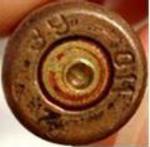
Source: Panel
2 39 011 2011 Tripoli, 2013 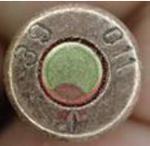
Source: Conflict Armament Research.
1 39 011 2011 Sabha, 2015 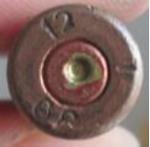
Source: Panel
1 39 12 2012 Tripoli, 2013 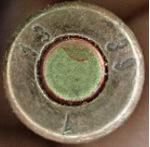
Source: Conflict Armament Research.
1 13 39 2013 Sabha, 2015 Other post-embargo produced materiel documented in Sabha
164. Conflict Armament Research also documented ammunition consistent with Chinese and Russian-produced materiel, manufactured after the imposition of the arms embargo, which had not been previously documented in Libya and for which no notification or exemption request had been submitted to the Committee (see table 3).
Table 3
Ammunition consistent with Chinese production and documented in Libya in July 2015
Ammunition Calibre (mm) Markings Year of production 7.62 x 39 811 11 2011 7.62 x 39 71 13 2013 7.62 x 54R 945 11 2011 7.62 x 54R 945 12 2012 12 x 108 11 13 2013 Source: Conflict Armament Research, Sabha, July 2015.
165. The Panel contacted China to establish the chains of transfer of the ammunition. China responded that it had exported no arms or ammunition to Libya since the imposition of the arms embargo; however, it did not provide information allowing the Panel to further investigate the chain of custody.
166. Lastly, Chinese-produced ammunition in boxes consistent with Sudanese packaging was also documented in Sabha by Conflict Armament Research, indicating that the Sudan may have retransferred materiel from its arsenal to Libya (see fig. VII).
Figure VII
Boxes consistent with Sudanese packaging containing Chinese-produced ammunitionSource: Conflict Armament Research, Sabha, July 2015.
167. The Panel also contacted the Russian Federation to obtain information about ammunition consistent with Russian production (see fig. VIII) and to support the Panel in identifying the chain of transfer. A response is awaited.
Figure VIII
7.62 x 54R mm ammunition consistent with Russian production produced in 2012Source: Conflict Armament Research, Sabha, July 2015.
Investigations relating to aviation capability and mercenaries
168. The Panel noted that Misratah airbase has been operating between 15 and 20 aircraft, including Mirage, L39, Soko, MiG and Mi -8 aircraft. The Panel believes that their refurbishment and piloting (in some cases) and the provision of ammunition therefor have required external support.
169. According to recent media reports, a United States national, Frederick Schroeder, has been piloting aircraft from the airbase. |47| The Panel contacted him, and he admitted that he had travelled to Misratah in June 2015 to fly aircraft, having answered an online job advertisement for pilots to fight ISIS. He was then interviewed and recruited by nationals of Jordan, the Republic of Moldova and Ukraine.
170. Several sources confirmed that armed groups from Misratah had been recruiting foreign pilots to fly Mirage F1 and L39 aircraft, including Ecuadorians and Ukrainians. Sources also mentioned that the aircraft were being maintained by a team of Ecuadorians. One brokering company involved in the recruitment is owned by a United States/Jordanian national who has previously been involved in illicit arms transfers. The same sources claimed that ammunition and spare parts used at the Misratah airbase were being provided by foreign countries. The Panel has contacted the aforementioned Member States.
Transfers of shotguns, hunting rifles and related ammunition
171. The sale of shotguns, hunting rifles and related ammunition remains a lucrative business in Libya, and the number of violations of the arms embargo involving this type of materiel is significant. Such materiel is used by civilians and armed groups. In 2015, ISIL used shotguns in executions (see fig. IX). In addition, the proliferation of such materiel out of Libya occurs regularly, in particular to Egypt and Tunisia. Annex 35 provides updates on previous cases of violations and findings about recent cases.
Figure IX
ISIL member executing a man with a shotgun in eastern LibyaSource: http://sitemultimedia.org/video/SITE_IS_BarqahProvince_Reaping_Awakenings.mp4.
3. Potential future transfers of materiel to the Government of National Accord
172. The risk of diversion and misuse of materiel will remain very high, regardless of the formation of the Government of National Accord. The Panel therefore believes that the provisions of the arms embargo should not be eased prematurely. The current provisions allow for exemptions solely for the Government, preventing transfers to non-State actors. If the members of the Committee do not object to exemption requests, the exemption procedure will be sufficient to obtain the required materiel.
173. In the current situation, reverting to a notification procedure, such as that in place before resolution 2174 (2014), would again allow transfers that threaten the peace, stability or security of Libya, as reported previously by the Panel. Shortcomings included the diversion of materiel, a range of Libyan "representatives" signing off on arms deals, transfers to unclear end users and the uncontrolled proliferation of notified materiel.
174. To counter those threats, the implementation of substantive and verifiable control measures by the Libyan authorities and the exporting parties is key. They should include mandatory, detailed pre-delivery information and post-delivery notifications by exporting Member States, as already set out in Implementation Assistance Notice No. 2; effective stockpile management and oversight measures, with the support of the United Nations Mine Action Service; and regular on-site monitoring of stockpiles and observation of potential future deliveries by the international community, in support of the Government of National Accord (see recommendations 3, 4 and 7).
175. A strong procurement system is therefore needed to avoid diversion and proliferation to armed groups. To assist the Committee in considering exemption requests for transfers to the Government of National Accord, the Government should create a procurement committee that would decide on the procurement of all materiel (see recommendations 2 and 6).
E. Transfers of materiel from Libya
176. The increased demand for materiel inside Libya notwithstanding, transfers out of the country are continuing, in particular to terrorist groups. Arms trafficking reflects the increased cooperation between armed groups in Libya and those operating in the region.
177. Investigations relating to arms transfers out of Libya require stronger support from Member States in the region. While the Niger and Tunisia have been very cooperative, other neighbouring countries and the French Operation Barkhane regularly seize materiel originating from Libya without reporting the information and do not always share the necessary details when requested or grant the Panel access to the materiel. Even though the Panel sent requests for information about arms transfers, Algeria, Chad, Nigeria and the Sudan provided no data to the Panel during its current mandate.
178. The Committee and the Panel have received useful seizure reports from Greece, Italy and Turkey, submitted in accordance with paragraphs 19 and 20 of resolution 2213 (2015). The Panel believes that this should also apply to transportation by road, as set out in Implementation Assistance Notice No. 3 (see recommendation 5).
1. Transfers through eastern borders
Transfers to Egypt
179. The Panel has previously highlighted the significant flows of weapons from Libya to Egypt (see S/2014/106, paras. 159 ff, and S/2015/128, annex 33). During its current mandate, the Panel noted additional reports of arms transfers to Egypt in the media and travelled to Egypt and Israel to obtain further information on networks involved. While the Panel was provided with useful data about the seizures of arms coming from Libya made in Egypt in 2015, it hopes that it will receive more support from Egypt in the future, so as to understand trafficking dynamics and identify the exact violators of the embargo (see annex 36).
Transfers to the Syrian Arab Republic
180. Since 2012, the Panel has reported several transfers of weapons from Libya to the Syrian Arab Republic or seized en route to the Syrian Arab Republic (see, e.g., S/2014/106, paras. 164 ff, and S/2015/128, annex 33). During its current mandate, the Panel collected additional evidence confirming previous transfers, but found no information relating to recent transfers.
181. The Panel confirmed the existence of a Libya -based network providing logistical support, including significant quantities of arms, to Syrian rebels in the wake of the Libyan revolution. It included Libyans holding official positions in the Ministry of the Interior and the Ministry of Defence. Initially, the network relied on arms collected from within Libya, but soon began sourcing externally, with some shipments not passing through Libya at all. To date, the network has been identified in at least three transfers to the Syrian Arab Republic, and more are being investigated. Details are provided in annex 37.
182. Although the Panel could not confirm the direct involvement of the same network, it is notable that the Nour M (IMO No. 7226627) also appears to have used Libya as a false destination. It was intercepted by Greece in November 2013 while carrying 55 containers of arms and ammunition (see S/2015/128, paras. 142 ff, and fig. X). The transfer documentation, signed by the former Deputy Minister of Defence of Libya, Khalid al-Sharif, indicated Libya as the final destination. The Panel established from maritime traffic data and a declaration by a crew member, however, that the vessel was not bound for Libya, but for Iskenderun, Turkey. The shipment would then have been transferred from Turkey to the Syrian Arab Republic by an unidentified group. Details of the investigation are provided in annex 38.
Figure X
Example of container transported aboard the Nour M, 14.5 mm ammunitionSource: Panel, Greece, October 2014.
183. Transfers to the Syrian Arab Republic from eastern Libya have received much press coverage following the attack on the United States Consulate in Benghazi in September 2012. Official United States investigative reports disclose that the Central Intelligence Agency annex was gathering intelligence about foreign entities collecting weapons in Libya and facilitating their passage to the Syrian Arab Republic. |48| The Panel contacted the United States on several occasions to obtain additional information and awaits a response.
184. Lastly, during its visit to Damascus in December 2014, the Panel was briefed by the Syrian authorities about a number of transfers from Libya to the Syrian Arab Republic and provided with a list of weapons that may have originated in Libya. The Panel requested the tracing of 20 FN FAL rifles, most of which were originally transferred by Belgium to Libya before the imposition of the arms embargo, which further confirms that transfers occurred from Libya to the Syrian Arab Republic (see annex 39).
2. Transfers through western borders
185. Since the submission of the Panel's previous final report, Tunisia has suffered several major terrorist attacks. The expansion of ISIL in Libya is having a significant impact on the threat of terrorism in Tunisia. According to the authorities, the vast majority of arms used by terrorists in Tunisia originate from Libya.
186. Apart from seizures made in relation to terrorism, the Tunisian military seized materiel from convoys in the south of Tunisia that were coming from Libya, sometimes en route to Algeria, including ammunition for assault rifles and general-purpose machine guns (see figs. XI -XIII), to which the Panel was granted access. Information relating to transfers to Tunisia is provided in annex 36.
Figure XI
Arms recovered from a terrorist cache in SousseSource: Ministry of the Interior of Tunisia, 1 December 2015.
Figure XII
7.62 x 39 mm ammunition seized in TunisiaSource: Panel, Tunis, December 2015.
Figure XIII
7.62 x 54R mm ammunition seized in TunisiaSource: Panel, Tunis, December 2015.
3. Transfers through southern borders
187. While transfers of arms from Libya to Mali and the Niger have decreased in intensity thanks in large part to Operation Barkhane, several shipments of materiel coming from Libya have been seized from various actors in the past 18 months (see fig. XIV), indicating that the country remains a significant source of arms for armed groups in the Sahel.
188. Libyan armed groups involved in providing materiel to convoys intercepted in the Niger on their way to Mali include Desert Shield 8 (see para. 209) and members of Katiba 315 of Ahmad al-Ansari and Katiba Tenere in Awbari. The groups collect materiel in the south and north of Libya and sell it to members of armed groups or intermediaries in the Sahel.
189. The Panel visited the Niger in October 2015 and obtained information about armed groups and trafficking networks currently active between Libya and Mali/the Niger in particular. Transcripts of interrogations of individuals arrested in convoys in the northern Niger in 2014 and 2015 indicate that Al-Qaida in the Islamic Maghreb (QDe.014), Ansar Eddine (QDe.135), the Mouvement national de liberation de l'Azawad, the Mouvement pour l'unification et le jihad en Afrique de l'Ouest (QDe.134) and Al Mourabitoun (QDe.141) are receiving support from Libya, either through members of the groups settled there or through temporary links and visits to gather money and arms and arrange other logistics.
190. Information provided to the Panel by France in February and December 2015 indicates that the use of Libyan materiel by armed groups, including terrorist groups, in Mali remains significant and has been documented in several caches. The information has been confirmed by the Joint Mission Analysis Centre of the United Nations Multidimensional Integrated Stabilization Mission in Mali.
191. Additional information can be found in annex 36.
Figure XIV
Arms found with Tebu traffickers in the northern Niger in 2015Source: Panel, Niamey, October 2015.
A. Financing from public funds
1. Direct support
192. The Panel has obtained copies of two Central Bank cheques, made out for a total of 6 million Libyan dinars, apparently to the Benghazi Revolutionaries Shura Council (see annex 40). If genuine, it means that the Tripoli-based Ministry of Defence provided Bank funds to the United Nations-listed Ansar al Charia Benghazi, part of the Benghazi Revolutionaries Shura Council. Bank employees based outside Tripoli explained that, while they could not verify the transaction, the cheques appeared genuine. The management of the Bank in Tripoli has not replied to repeated requests for clarification by the Panel.
193. The Panel is investigating the allegation that the General National Congress provided the strongest anti-Libyan Political Agreement faction in Tripoli, the Sumud Front, with $103 million from an emergency fund. A publicized example of suspicious budgeting reveals the risk of diversion of State funds, potentially also to armed groups. The Oil Minister of the National Salvation Government publicly accused his Prime Minister of having received 1 billion Libyan dinars in extrabudgetary funds from the Central Bank, now unaccounted for. |49| The Panel hopes that more information will become available once the Government of National Accord has been established in Tripoli.
194. In the light of the foregoing, the Panel asked the management of the Central Bank for access to the 2014-2015 statements of nine accounts of the Ministry of Defence.
2. Salaries
195. As previously reported (see S/2015/128, para. 190), government salaries are continuing to be paid to enlisted combatants, regardless of their current unit or human rights record. The management of the Central Bank in Tripoli explained that all salaries for the staff of the Ministry of Defence and the Ministry of the Interior were continuing to be paid on the basis of (unchanged) pre-July 2014 lists, directly into personal bank accounts.
196. That the payments have not been vetted or monitored poses a serious problem. Units and combatants that were previously (nominally) operating under the authority of Libyan ministries are now dispersed among warring sides and factions. It is beyond doubt that the State is currently paying the salaries of at least some combatants of United Nations-listed terrorist organizations and armed group members involved in the most serious human rights abuses (see recommendations 16 and 20).
3. Trade in subsidized products
197. The Libyan subsidy system provides additional income to armed groups and criminal networks through profit margins on black market prices of subsidized products, including fuel, wheat flour, tomato paste, sugar, tea, rice and pasta.
B. Exploitation of natural resources
198. The Panel continues to receive reports of fuel smuggling both within and out of Libya, driving the black market and providing a significant source of revenue for local armed groups and criminal networks (see recommendation 25).
199. The western National Oil Corporation issued a statement on 27 July 2015 in which it requested the Government and other relevant institutions to take immediate action to stop the smuggling of fuel, saying that it was draining the country of its natural resources (see annex 41). The statement was issued after two Italians were arrested in the Dominican Republic for their involvement in a fraud relating to the sale of fuel to the Italian navy that had not been delivered (see annex 42 for the International Criminal Police Organization red notice concerning one of the suspects).
200. The dire economic conditions in Libya and the lack of any formal security apparatus create the ideal conditions for fuel smuggling to flourish. The town of Zuwarah on the north-western coast is one area that stands out as generating particularly high revenue.
1. Modus operandi
201. The fuel smuggled from Zuwarah comes from the Zawiyah refinery, which refines crude oil received from other Libyan terminals. Zawiyah also receives refined products from abroad that are stored there. Fuel is then distributed to suppliers in the surrounding area, but significant quantities are also sold to smugglers.
202. The ships smuggling fuel sail south from Malta to between 40 and 60 nautical miles off the Libyan coast, where they turn off the Automated Identification System. After they are loaded, they return to Malta. The vessels remain adrift at least 12 nautical miles off the coast, outside Maltese territorial waters, while they discharge the fuel on to other vessels that carry it to the coast.
2. Zawiyah refinery
203. The security of the refinery is allegedly assured by two armed groups: the Kufrah brigade, led by Mukhtar Akhurash, part of the Petroleum Facilities Guard, and another unidentified group. Sources on the ground state that the illicit sale of fuel is carried out only by the unidentified group, not by the Kufrah brigade. It has been difficult to precisely identify the group's chain of command and the Panel is still investigating its involvement.
3. Zuwarah smugglers
204. Several families run the fuel smuggling business in Zuwarah. All are or have been involved in other types of smuggling, such as of people, cigarettes or drugs. Some of them also operate from other locations, including Sabratah.
205. The Panel gathered information on the network run by Fahmi bin Khalifah (also known as Fahmi Salim). He controls a militia and is a shareholder in a Maltese company, ADJ Trading Limited. He also chairs the board of directors of a Libyan company, Tiuboda Oil and Gas Services Limited, which requested a licence to import fuel into Malta from Libya. According to the Maltese authorities, the request was rejected owing to the situation in Libya.
206. The Maltese authorities are aware of the activities carried out by ADJ Trading Limited and the vessels used to smuggle fuel, the Basbosa Star (IMO No. 8846838) and the Amazigh F (IMO No. 7332488). A study of Salim's network is provided in annex 43.
4. Vessels impounded relating to fuel smuggling
207. The Libyan coastguard impounded several vessels in the vicinity of Zuwarah in 2015 following allegations of involvement in fuel smuggling. Information is available in annex 44.
C. Financing from other sources
1. Smuggling
208. The Panel investigated the potential profits made by armed groups from trafficking in persons through Libyan territory. It is clear that, although the groups are currently not the main organizers of the smuggling, they do receive money for facilitation and "protection". Groups in Kufrah, Ajdabiya, Zuwarah, Sabratah, Sabha, Qatrun, Awbari, Tripoli, Benghazi and Bayda have all been involved (see recommendation 25). |50| The Panel was able to identify the involvement of armed groups, including the Istanbul brigade from Ajdabiya (see annex 45). |51|
209. The smuggling of weapons and narcotics has also remained a significant source of income for armed groups and criminal networks (see recommendation 25). The group led by Bahr al-Din Maydun, referred to as Desert Shield 8 and operating in Fazzan, is involved in both. The Panel is also investigating the activities of an armed group in Tripoli and another in Misratah. Armed group control of territory and checkpoints forces smugglers to collaborate with them.
2. Extortion, kidnapping and protection money
210. The Panel received multiple reports of mafia-style extortion rackets run by armed groups in Tripoli against small and large businesses. Several senior employees in the public and private financial sectors stated that they had received personal threats from armed groups in 2015. In one case, Central Bank employees were threatened by Haytham al-Tajuri and his associates in order to obtain letters of credit and accelerate procedures. Documentation shows that the extortionists were granted letters of credit for more than $20 million (see annex 46).
211. Armed groups also profit from the formal economy through protection money. The Panel documented a case in which one of two rival construction companies appears to have operated under the "protection" of the Special Deterrence Force of Abdulra'uf Kara (see annex 47).
212. The previously reported wave of kidnappings for ransom continues (see S/2015/128, paras. 192 ff). In addition to reports of hostages being forced to surrender large sums of money, the Panel received a report of land title deeds being extorted.
3. Fraud
213. Armed groups are active in both genuine and fraudulent business activities. One of the preferred forms of fraud involves foreign currency exchange. The difference between the official and black market exchange rates virtually doubled in 2015, rendering it extremely lucrative to bring hard currency into Libya. The hard currency is obtained through falsified and misdeclared imports invoiced at the official Central Bank exchange rate and exchanged locally into Libyan dinars at black market rates.
214. The management of the Central Bank in Tripoli explained to the Panel that it was cracking down on such practices, while asserting that Gulf countries should carry out more auditing. A number of accounts of individuals and companies have indeed been frozen, but a Libyan financial expert claims that several hundred remain in use.
4. Looting
215. Armed groups continued to profit from looting in 2015. In that regard, the Panel highlights that, according to documents provided by the management of the Central Bank in Tripoli, between the Central Bank and commercial banks, the equivalent of more than $2 million was stored in Sirte when ISIL took control of the town.
5. Recovery of exported assets of former regime members
216. The Panel is investigating the involvement of security personnel from the National Salvation Government in an attempt to obtain assets of more than $500 million that were brought from Libya to another Member State in 2011, a transaction from which several brokers intended to profit. The documentation indicates that the transaction was to have remained concealed, raising further questions about the current status of the assets and, specifically, whether they have been used to support armed groups affiliated with the National Salvation Government.
VII. Unity of State financial institutions and any action that may lead to or result in the misappropriation of State funds
217. The Panel has gathered information about the Libyan economy from Libyans working in business and finance and from World Bank and IMF representatives responsible for Libya. Their assessment is that, in 2015, control of the Central Bank remained in Tripoli, under the supervision of Mr. Sadiq al-Kabir, whence the Bank disburses all payments.
218. In August 2015, Mr. Al-Kabir and one of the board members of the Central Bank told the Panel that all public sector expenses were being directly met by the Bank in Tripoli, including salaries and subsidies. They explained that salaries were based on government payroll lists from before July 2014 and paid directly into personal bank accounts against a recently introduced national identification number. The subsidies (for food and fuel, among other things) accounted for 25 per cent of the budget. They were, however, to be replaced by less costly payments into personal bank accounts early in 2016. Funding of government spending was dealt with "exclusively at a technical level" with the ministries in Tripoli.
219. On 23 July 2015, representatives of the eastern branch of the Central Bank and Mr. Ali Salim al -Hibri, who also sits on the IMF Board of Governors, told the Panel that their activities were limited to the distribution of cash. They claimed that they had been effectively cut off from Tripoli, including any possibility of monitoring payments and policies. They showed documents indicating that insufficient quantities of Libyan dinars, and no hard currency, had been provided to them by Tripoli. Representatives of eastern branches of commercial banks claimed to have great difficulties in financing trade, rarely receiving approval from Tripoli to establish letters of credit.
220. The Panel assesses that the policies of the Central Bank indeed reflect its physical proximity to Operation Fajr and the General National Congress. They curtail the means of financing of initiatives affiliated with the interim Government and show a more lenient attitude towards the priorities of Tripoli. The cessation of financing of interim Government-supported embassies, acknowledged by the Bank in Tripoli, is a clear example.
221. Furthermore, the current situation prevents an effective humanitarian response to emergencies, especially to active war zones in the east.
222. Following the above, the eastern-based management of the Central Bank dropped its previous restraint and stepped up its attempts to gain control of the Libyan financial system in the second half of 2015, thereby further undermining the unity of the institution. Action included the opening of a separate account for oil exports (see para. 241) and repeated attempts to take direct deliveries of cash printed in Europe.
223. The Panel interviewed several high-ranking employees of State financial institutions and commercial banks involved in financing the public sector, who explained that they had been personally threatened by various armed groups in 2015 and seen a general increase in political pressure on the banking sector.
224. In the light of the foregoing, the Panel concludes that the current organization of the Libyan financial system is no longer tenable and urgently needs oversight from, and protection by, the Government of National Accord (see recommendations 18 and 19). Currently, Central Bank operations from Tripoli cannot be neutral because the capital is not controlled by the Government of National Accord and is infamous for suffering abductions and extortion.
225. Following the adoption of resolution 2259 (2015) in late December, the Panel contacted the competing managements of the Central Bank to inquire about the future of the Bank under the Government of National Accord. The eastern branch replied that it was awaiting a meeting with the Prime Minister-designate, Fayiz al-Sarraj, to better understand his intentions, and that improvements in the banking sector depended on some key appointments within the Government of National Accord. The management in Tripoli did not respond. Both parties had previously expressed the hope that the Government of National Accord would normalize the Bank's operations.
226. Lastly, the Panel investigated reports of a potential risk of misappropriation of Central Bank funds by ISIL in Sirte, where a backup of the banking system had been installed under Qadhafi. All the Bank employees consulted concurred that the branch had not been operational since 2011 and that the equipment could no longer be used because it had been damaged or become outdated. Consequently, control over Sirte does not give ISIL access to State finances or to the wider SWIFT system. It is, however, likely that the site continues to hold all Libyan historic banking data, which could prove useful to anyone seeking to mask fraudulent transactions.
B. Libyan Investment Authority
227. As in the case of other national institutions, there are rival manifestations of both the Libyan Investment Authority (LYe.001) and the Libyan Africa Investment Portfolio (LYe.002), based in Tripoli and Malta. Panel sources indicate that it is those under the control of the interim Government of Libya, based in Malta, that have access to the assets of those wealth funds.
228. In November 2015, the Panel interviewed the Chief Executive Officer of the Malta-based Libyan Investment Authority, Hasan Bohadi, who stated that the Authority, as constituted, consisted of a board of directors, which he chaired, appointed by the "internationally recognized Government" and the House of Representatives in October 2014.
229. He relies upon Libyan Law No. 13, |52| which states that a board of trustees, chaired by the Prime Minister, appoints a board of directors. He also stated that the following subsidiaries of the Libyan Investment Authority reported directly to the board: the Libyan Africa Investment Portfolio, the Libyan Arab Foreign Investment Company, |53| the Long Term Portfolio, Oilinvest and the Libyan Local Investment and Development Fund.
230. The Panel also contacted the head of the Libyan Investment Authority in Tripoli, Abdulmajid Braysh, by telephone. He has no access to the fund's assets. Both he and Mr. Bohadi agree that the assets of the Libyan Investment Authority and the Libyan Africa Investment Portfolio currently frozen should remain so, pending the establishment of the Government of National Accord, which was also the best protection against misappropriation.
C. National Oil Corporation and implementation of measures on crude oil
1. Threats to the oil sector
231. In 2015, efforts by representatives of the interim Government to set up parallel structures and procedures increased the threat to the unity of the National Oil Corporation and the risk of misappropriation of funds. At the time of the writing, the Government of National Accord had not been formed, and it was unclear whether the various actors in control of financial institutions and the Corporation would accept its authority.
232. On the ground, loopholes are being exploited by armed actors who have been seeking to generate financial and political gain from the control of oil fields, pipelines and export terminals, fuelling local conflicts (see recommendation 14). Although ISIL attacked oil facilities in 2015 and 2016 (see para. 70), it does not yet control any of them, nor generate revenues from the exploitation of crude oil in Libya.
233. Control by the Government of National Accord of procedures and facilities on the ground within the hydrocarbon sector is key to the protection of the country's primary source of revenue, which has been severely diminished since the revolution, with production falling from 1.5 million barrels per day in September 2012 to 380,000 in November 2015, according to the Organization of the Petroleum Exporting Countries. An overview of the situation of Libyan oil ports and refineries can be found in annex 48.
2. Implementation of resolution 2146 (2014)
234. Following the Morning Glory incident (see S/2015/128, para. 236) in March 2014, the Security Council adopted resolution 2146 (2014), thereby enabling the Committee to designate vessels seeking to illicitly export crude oil from Libya, after notification from the relevant Libyan focal point. To date, the Libyan authorities have made no notifications and no vessels have been designated.
235. In the current situation, the designation mechanism contained in resolution 2146 (2014) is not implementable (see recommendation 12). In addition, the appointed focal point has left office and no replacement has been communicated to the Committee.
236. The Panel has received allegations of crude oil being illicitly exported after the adoption of resolution 2146 (2014). Representatives of the National Oil Corporation have always denied such illicit trade, and oil sector experts are also of the opinion that such transfers are unlikely at the current stage. While no evidence has been secured for now, the Panel is investigating the reports, which would meet the designation criteria under paragraphs 11 (c) and (d) of resolution 2213 (2015).
3. Threats to the integrity and unity of the National Oil Corporation
237. The lenient attitude of the Central Bank towards the National Salvation Government (see para. 220) and need for revenue of the interim Government are part of the motivation to duplicate the oil-exporting mechanisms of the National Oil Corporation, threatening the unity and the integrity of the institution. |54| In particular, the interim Government's plan to create a new, parallel payment system for oil revenue has been a cause for concern for the Panel because, if not transparent or properly audited, it could lead to the misappropriation of public funds. The Panel has raised its concern with the Committee.
238. On 17 March 2015, the interim Government stated that the legitimate Chair of the National Oil Corporation was Al-Mabruk Abu Sayf Mrajaa, based in Benghazi. It declared the National Oil Corporation in Tripoli illegitimate and stated that any contract with it signed after 27 November 201 4 would not be honoured.
239. In April 2015, the Permanent Representative of Libya to the United Nations stated that, while the oil ports of Hariqah, Zuwaytinah, Brega, Ra's Lanuf and Sidrah were under the control of his Government, the oil ports in the west were controlled by "illegitimate authorities". He informed the Committee that the National Oil Corporation, represented by Mr. Mrajaa, would notify the Committee of any illicit exports, in accordance with resolution 2146 (2014).
240. In June 2015, however, the Panel met Mr. Mrajaa and some of his staff, who were unaware of resolution 2146 (2014), rendering its implementation impossible. They showed a strong desire to strike deals with oil companies and establish a parallel payment system to secure the income from those sales. Their plans lacked unanimous support from the House of Representatives and the interim Government, |55| however, and did not materialize. During a meeting in July 2015, the Governor of the Central Bank, Mr. Al-Hibri, told the Panel that he had refused to support the efforts by the eastern National Oil Corporation and to open a bank account in the United Arab Emirates.
241. The Chair of the eastern National Oil Corporation (and resolution 2146 (2014) focal point) was reportedly replaced in August 2015 by Nagi al-Magrabi, |56| whom the Panel met in Tunis in November. Following his appointment, the eastern Corporation increased its efforts to secure oil deals, organizing a meeting in Malta in September to request international oil companies to register with it and secure new contracts. |57| It also announced that it had opened an account with the Arab Investment Bank in Egypt to deposit oil payments (see recommendation 13). On that occasion, the initiative did receive the support of Mr. Al-Hibri, who is also a member of the board of directors of the Bank. |58| The Committee has not been informed of any change to the resolution 2146 (2014) focal point.
242. The Panel is concerned by the potential for significant income to be gained by armed groups controlling oil facilities in the east from the direct export of oil by the eastern National Oil Corporation, in particular by the Petroleum Facilities Guard (central region) and its leader, Ibrahim Jadhran. |59| Jadhran, who had already sought to export crude oil without the consent of the Government in March 2014 (Morning Glory incident, see S/2015/128, para. 236), has also been a strong advocate of autonomy for Cyrenaica. Forces under his command have challenged the authority of the Government on several occasions since 2011.
4. Impact on international companies and oil contracts
243. With rival entities vying for control of the oil sector, international companies have difficulty navigating the current situation and have requested guidance from the Panel. The lack of clear indications in the relevant resolutions renders this impossible, however, given that there are no grounds for identifying with which National Oil Corporation they should engage. Some companies have therefore decided to seek guidance from their foreign ministries.
244. Notwithstanding warnings addressed to the international oil companies by the eastern National Oil Corporation (see annex 52), no action has been taken and, to date, pre-existing contracts have been honoured, loading has been carried out in ports under the control of the eastern Corporation and tankers have been dispatched with no incidents reported. Some oil companies have decided to take sides publicly, with some announcing their support for the western Corporation. |60|
245. Some companies have been endeavouring to secure contracts with the eastern National Oil Corporation. From interviews conducted with some of them, it appears that shipping lines have been reluctant to provide them with the vessels required, thereby preventing any shipment from occurring.
246. For example, the Panel has received documents showing that the eastern National Oil Corporation gave instructions to deliver between 600,000 and 1 million barrels of Sarir grade crude oil to the port of Marsa al-Hariqah (Tubruq). The shipment should have been loaded in the first week of November 2015 (see annex 53) but, ultimately, no ship was chartered.
247. The western National Oil Corporation has also sought to discourage international oil companies from complying with the requirements of the eastern Corporation. |61| Both have become involved in a conflict that fully emerged when the memorandum of understanding between the eastern Corporation and the Egyptian General Petroleum Corporation was made public. |62| Neither the signature of the Libyan Political Agreement nor resolution 2259 (2015) has resolved the issue within the oil sector.
248. The Central Bank, the Libyan Investment Authority and the National Oil Corporation are the pillars of the economy. Nevertheless, less-important State institutions are also vulnerable to potential misappropriation of funds. For example, the Panel inquired about the current status and balance of the Economic and Social Development Fund, a State fund worth 2 billion Libyan dinars that is reported to have an independent management structure susceptible to misappropriation. It is therefore crucial that the Government of National Accord assert control also over other State institutions.
VIII. Implementation of the asset freeze
249. The Panel remains concerned by attempts by criminal groups to represent themselves as authorized asset recovery agents of the Government. It shared those concerns with the interim Government, which wrote to its embassies to alert them to which companies are properly authorized to undertake such work.
250. While the recovery of stolen assets falls outside the Panel's mandate, there remains a danger that assets subject to the asset freeze may be obtained by such groups.
251. Indications remain that, while there are likely to be significant quantities of disguised assets globally, there is much speculation and uninformed comment in that regard. It is important to reiterate that the Libyan authorities can recover only those assets owned by designated individuals when a competent court establishes that they are unlawfully held, and therefore not the property of those individuals, thus not subject to the asset freeze.
B. Frozen assets of designated entities
252. Under the provisions of paragraph 13 of resolution 2095 (2013), while maintaining the asset freeze as imposed under resolutions 1970 (2011) and 1973 (2011) and as amended in resolution 2009 (2011), the Security Council required the Committee to continuously review the remaining asset-freeze measures imposed under those resolutions and, regarding the Libyan Investment Authority and the Libyan Africa Investment Portfolio, to delist them as soon as practical to ensure that their assets would be used for the benefit of the Libyan people.
253. Assets of designated entities that were frozen before 16 September 2011 should remain frozen, subject to the intention of the Security Council that they should be unfrozen and returned for the benefit of the Libyan people as soon as possible.
254. The Chief Executive Officer of the Libyan Investment Authority, Hasan Buhadi, voiced concern regarding the management of frozen assets and their significant loss of value. The combined frozen assets of the Libyan Investment Authority and the Libyan Africa Investment Portfolio originally amounted to around $65 billion. Through mismanagement, however, this is now down to between $55 billion and $60 billion.
255. All Libyan Investment Authority investments frozen in 2011 have since matured, meaning that they remain in overseas financial institutions as cash. Fund managers have not reinvested the assets as a result of the asset freeze. Cash deposits accrue little, if any, interest, nor earnings that could be achieved from investment.
256. The Security Council has made no explicit provision for the reinvestment of matured funds. Nevertheless, in paragraph 19 of resolution 1970 (2011), the Council authorized the payment of fees for the management of assets. The paragraph reads:
Decides that the measures imposed by paragraph 17 above do not apply to funds, other financial assets or economic resources that have been determined by relevant Member States:
(a) To be necessary for basic expenses, including ... fees or service charges, in accordance with national laws, for routine holding or maintenance of frozen funds, other financial assets and economic resources, after notification by the relevant State to the Committee of the intention to authorize, where appropriate, access to such funds . in the absence of a negative decision by the Committee within five working days of such notification;
257. As previously reported (see S/2015/128, paras. 226-228), where licences were issued by three Member States, there is no bar, subject to the above notifications, to fund managers reinvesting assets to achieve the best returns in accordance with their fiduciary duties. Thus, provided that the assets were not made available to the entity, their value would be protected and they would remain subject to the asset-freeze measure. It was clearly not the aim of the Security Council that the investments should be diminished, meaning that this matter needs to be clarified, preferably by including an explicit exemption for fund management in a future resolution (see recommendation 8).
258. A similar issue is the interpretation by banks or States of the resolutions regarding payment of interest. Interest can be paid on deposits in the normal way, provided that it is added to the frozen funds and remains frozen. This is not universally the case, the reason being the following wording of paragraph 20 of resolution 1970 (2011):
Decides also that Member States may permit the addition to the accounts frozen pursuant to the provisions of paragraph 17 above of interests or other earnings due on those accounts . provided that any such interest, other earnings and payments continue to be subject to these provisions and are frozen;
259. The word "may" allows banks to avoid paying interest, further diminishing the real value of the assets. The Panel considers that Member States should be encouraged to urge financial institutions to credit interest payments to frozen assets in line with normal business practice (see recommendation 9).
260. Some Member States are exploring the possibility of using frozen assets, at the request of the interim Government of Libya, for humanitarian or medical purposes. Provided that those assets are those belonging to designated entities, and the relevant exemption requests are made, there would appear to be no obstacle to such a course of action, subject to the procedure contained in paragraph 16 (a) of resolution 2009 (2011).
C. Implementation challenges: implementation assistance notice
261. In response to a request by the Committee, the Panel prepared an implementation assistance notice explaining the measures, including guidance on the exemption procedures, and offering suggestions as to the procedures that may be followed in implementation. The adoption of the notice is currently on hold. The Panel urges the Committee to finalize its considerations and issue the notice as soon as possible in order to enhance the implementation of the asset-freeze measure (see recommendation 11).
D. Exemptions to the asset freeze
262. No asset-freeze exemption requests or notifications have been received since the submission of the Panel's previous final report.
263. The Committee received two requests for guidance from Member States in March 2015, both asking whether the assets of subsidiaries of the Libyan Foreign Investment Company should be frozen. The Panel advised the Committee that, given that subsidiaries are not subject to the asset-freeze measure, their assets should not be frozen. The Committee so informed the Member States by letter.
1. Saadi Qadhafi
United Republic of Tanzania
264. As previously reported (see S/2015/128, annex 36), two companies 99 per cent owned by Saadi Qadhafi (LYi.015) are incorporated in the United Republic of Tanzania (Litali Holdings Company Ltd and Al-Albani Islamic Centre Ltd). It is unclear whether the companies and associated bank accounts have been frozen. Requests for clarification, both written and oral, have yet to elicit a response.
265. As previously reported (see ibid.), a South African, Dalene Sanders, was suspected of involvement in the violation of the asset-freeze measure by Saadi Qadhafi, as a consequence of which her assets in the United Republic of Tanzania were frozen by the authorities.
266. In March 2015, the Panel interviewed Ms. Sanders and examined her records. It is satisfied that her involvement with the financial affairs of Mr. Qadhafi was unwitting and performed in the course of normal business. It is also clear that her frozen assets are unconnected to him. She is not designated under the United Nations sanctions measures, and there is therefore no reason for her assets to remain frozen.
267. Following the raising of the issue in its previous final report, the Committee encouraged the Panel to communicate this to the Tanzanian authorities. The Panel sent two letters to the United Republic of Tanzania, but no response has been received. According to Ms. Sanders, the assets remain frozen, and she was told by the Tanzanian authorities that they could not be unfrozen without the permission of the Committee, which is clearly not the case (see recommendation 10).
Uganda
268. As previously reported (see S/2015/128, annex 36), the Panel has been conducting enquiries regarding the assets of a Ugandan company, Aurelius Holdings Ltd. It has confirmed that the funds in the company's account were transferred on behalf of Saadi Qadhafi and therefore must be frozen.
269. The Panel visited Kampala in October 2015, where it was confirmed that the funds remained frozen. The Panel requested further information concerning transactions likely to have been made against the account by or on behalf of Saadi Qadhafi, along with documentation concerning persons believed to have assisted in the violation of the asset-freeze measure. This was agreed, but a response is still awaited.
270. Various suspicious deposits into the account from a bank in the United Arab Emirates were identified. A letter was sent in October 2015 to the United Arab Emirates to request further details. Partial details have been received, and further clarification has been requested.
2. Abdullah al-Senussi
271. Enquiries continue into the origin of £500,000 paid to a British law firm to represent Abdullah al-Senussi (LYi.018) in his attempts to be tried at ICC. Information from the United Kingdom and the United Arab Emirates has confirmed that the funds came from a family member and are suspected to originate from assets that should have been frozen. Further information has been requested from the United Arab Emirates.
3. Hannibal Qadhafi
272. Following the provision of financial documentation from a Member State, analysis indicates the strong likelihood that Hannibal and Aisha Qadhafi, individuals designated under the asset-freeze measure (LYi.010 and LYi.009), have transferred money to front companies in other Member States. Extensive documentation has been received from another Member State, which is currently being analysed.
4. Mutassim Qadhafi
273. The Panel's attention has been drawn to legal action being brought by the interim Government of Libya for the recovery of assets believed to be owned or controlled by the estate of Mutassim Qadhafi (LYi.014) in Italy and Malta. They are relevant to the Panel only if they are found to be so owned or controlled. However, the Italian case was raised by the authorities during the Panel's visit to Rome, and they appeared to be concerned that, given the political split in Libya, the authority of the Libyan Attorney General to contest the case was questionable.
274. The Panel stresses that, irrespective of a Member State's opinion regarding the legitimacy of the interim Government, if there is evidence of the existence of assets owned or controlled by designated individuals, it should be investigated, and, if proved, the assets frozen. The Panel has written to both countries to remind them of this.
275. In December 2015, a letter was brought to the Panel's attention, purporting to be from the Chair of the Committee to the Governor of the Central Bank in Tripoli, authorizing the unfreezing of Bank assets held in the United States. The letter had been widely circulated in the media. It is a forgery and, furthermore, the Central Bank and the Libyan Foreign Bank were delisted in December 2011. The Panel has communicated this information to the Chair of the Committee.
IX. Implementation of the travel ban
276. By paragraphs 15 and 22 of resolutions 1970 (2011) and 1973 (2011), respectively, the Security Council imposed a travel ban on individuals designated by the Council or the Committee, with exceptions pursuant to paragraph 16 of resolution 1970 (2011). All designated individuals on the Committee's sanctions list are subject to the travel ban. The list, updated on 26 March 2015, contains the names of 20 individuals (5 subject solely to the travel ban and 15 subject to both the travel ban and the asset freeze).
277. Of those 20, 6 are deceased; 5 are currently in Libya (1 temporarily in another country consequent to a travel ban exemption &mdash see para. 286), 4 of whom are detained; 5 are in other countries; and the whereabouts of 4 remain unknown. The date of birth of Abu Zayd Umar Dorda (LYi.006) is shown on the Specially Designated Nationals list maintained by the United States Department of the Treasury as 4 April 1944. The Panel has confirmed the date with his son, Muhammad Dorda. From documents received by the Committee, additional identifying information concerning Safia Farkash al-Barassi (LYi.019), Mutassim Qadhafi (LYi.014) and Sayyid Mohammed Qadhaf al-Dam (LYi.003) was obtained (see recommendation 23).
278. Following the Panel's interim report, Committee members were encouraged to submit further identifying data of designated individuals, but no such data were submitted.
A. Current investigations into violations of the travel ban
1. Safia Farkash al-Barassi
279. As previously reported (see S/2015/128, para. 211), Muammar Qadhafi's second wife, Safia Farkash al-Barassi (LYi.019), travelled from Algeria to Oman on 9 January 2014 for medical treatment. No notification or application for an exemption to the travel ban was received by the Committee. Consequently, a letter was sent to Oman by the Committee, recalling the country's obligations under the ban.
280. In April 2015, the Panel received reliable information that, during a court case in Malta, Ms. Al-Barassi's lawyer had testified that she was in Cairo. That statement was supported by information from a confidential source. A letter was sent to Malta to request a transcript of the relevant court proceedings and, subsequently, letters were sent to Egypt and Oman to request further information. The Maltese authorities provided a copy of the transcript on 6 August (see annex 54). No response was received from Egypt, but, on 9 July, Oman responded by confirming that she had travelled to Egypt for further treatment.
281. No exemption request was received for her travel, meaning that her entry to Egypt constitutes a violation of the travel ban by the individual and by Egypt. A letter inviting rebuttal of the allegation was sent to Egypt on 6 January 2016. On 18 January, the Panel received a response confirming that she had travelled to Egypt for medical treatment and requesting that the travel be exempted from the ban. No information was provided about her departure from Egypt. Such a request at this stage, and to the Panel rather than the Committee, does not constitute compliance with the measure, and this therefore remains a violation. On 13 January, Oman informed the Panel, in response to a letter sent on 8 January, that she had not returned to Oman. Consequently, she is believed to be in Egypt (see recommendation 23).
2. Hannibal Qadhafi
282. In December 2015, the Panel was made aware of media reports that Hannibal Qadhafi had been kidnapped and subsequently released while in Lebanon. It had been believed that he was in Algeria, and the Committee has received no exemption request or notification concerning his travel to Lebanon.
283. If confirmed, his travel would constitute a violation of the travel ban by the individual, by Lebanon and by any transit State. A letter was sent to Lebanon on 15 December 2015 to request further information. A further letter, inviting rebuttal of the allegation, was sent on 4 January 2016. No reply has been received.
284. Although the alleged departure of Hannibal Qadhafi from Algeria would represent no violation of the measure by Algeria, a letter was sent to Algeria on 15 December 2015 to request any information held about the travel. No reply has been received.
285. It was also alleged in the report that Hannibal Qadhafi had been resident in Oman since 2012. On 7 January 2016, in response to the Panel's enquiry, Oman stated that he had not entered the country since the imposition of the travel ban.
B. Exemption and delisting requests
286. On 12 November 2015, a travel ban exemption request was made on behalf of Sayyid Mohammed Qadhaf al-Dam (LYi.003) for the purpose of medical treatment in Egypt. |63| The proposed dates for the travel were 22 November 2015 to 22 February 2016. The request was approved by the Committee.
287. On 10 September 2015, through the focal point for delisting, the Committee received a delisting request on behalf of a listed individual. On 22 October, the Committee concluded its consideration of the request, denying it.
C. Implementation assistance notice
288. Following a recommendation in the Panel's interim report, the Committee requested the Panel to draft an implementation assistance notice on the travel ban to provide guidance to Member States.
289. A draft notice was submitted to the Committee on 24 November 2015 and adopted on 7 January 2016. It is available on the Committee's website as Implementation Assistance Notice No. 4. |64|
290. The Panel recommends:
Arms embargo
To the Security Council Recommendation 1. To encourage the Government of Libya or the future Government of National Accord to report to the Security Council on the structure, strength and composition of the Libyan security and defence forces, including names of specific units and commanders, before submitting any exemption requests. [see para. 142] Recommendation 2. To request the Government of Libya or the future Government of National Accord to establish a single channel for the procurement of all materiel for the Government, which should be a small procurement committee comprising representatives of the relevant ministries. Its approval should be required before the submission of exemption requests to the Committee. It should also be responsible for overseeing the entire chain of transfer, including for post-delivery notifications. The Government or the future Government of National Accord should provide the Committee with the name or names of the official or officials authorized to sign procurement documentation on behalf of the procurement committee. [see para. 175] Recommendation 3. To request the Government of Libya or the future Government of National Accord to conduct a stocktaking of its materiel, including chemical weapons, and to encourage it to provide the results to the Security Council as soon as possible. [see paras. 110 and 174] Recommendation 4. To require the implementation of verifiable control measures on the part of the Government of Libya or the future Government of National Accord and exporting Member States before any transfers are made, including: (a) Mandatory detailed pre-delivery information and post-delivery notifications. The information should include the date, the port of entry, the location of delivery, the means of transportation, the intended place of storage and the precise end-user unit;
(b) Increased arms control and management by the Government;
(c) Regular on-site visits by international observers to monitor deliveries and arms stockpiles. [see para. 174]
Recommendation 5. To ensure that the relevant paragraphs on the reporting of seizures of embargoed materiel (most recently, paragraphs 19 and 20 of resolution 2213 (2015)) apply also to transportation by road. [see para. 178] To the Committee Recommendation 6. To request the Government of Libya or the future Government of National Accord to identify a member of the procurement committee as a point of contact for the Panel, and to remind it that the Panel should be granted access to arms storage facilities, in accordance with paragraph 25 of resolution 2213 (2015). [see para. 175] To Libya (future Government of National Accord) Recommendation 7. To ensure safe and effective management, storage and security of government stockpiles, with the assistance of international partners, including the United Nations Mine Action Service. [see para. 174] Asset freeze To the Security Council Recommendation 8. To explicitly allow and encourage the reinvestment of assets frozen under the measures, in consultation with the Government of Libya, in order to protect the value of investments of designated individuals and entities. [see para. 257] Recommendation 9. To encourage Member States to urge financial institutions to credit interest payments to frozen assets of designated individuals and entities, in line with normal business practice. [see para. 259] To the Committee Recommendation 10. To inform the United Republic of Tanzania that Dalene Sanders is not subject to the asset freeze imposed by the Security Council in the relevant resolutions, and hence her assets should not be frozen pursuant thereto. [see para. 267] Recommendation 11. To finalize, approve and circulate the draft asset freeze implementation assistance notice, prepared by the Panel at the request of the Committee. [see para. 261] Measures in relation to attempts to illicitly export crude oil from Libya To the Security Council Recommendation 12. To reconsider the usefulness, coherence and appropriateness of the designation process contained in resolution 2146 (2014). [see para. 235] To the Committee To Libya (future Government of National Accord) Recommendation 13. To unify management, payment, auditing and contracting procedures, to normalize the functioning of the National Oil Corporation and to ensure that contracts with international companies are honoured. [see para. 241] Recommendation 14. To integrate vetted members of the Petroleum Facility Guard into an elite force capable of countering terrorist attacks and disaster situations at oil facilities. [see para. 232] Designation criteria To the Committee Recommendation 15. To encourage the Government of Libya or the future Government of National Accord to implement a vetting process when reforming and recruiting its armed and security forces, including for appointments to senior positions. [see para. 82] Recommendation 16. To encourage the Government of Libya or the future Government of National Accord to ensure that flows of government funds to human rights violators or members of terrorist groups are prevented. [see para. 196] Recommendation 17. To contribute to ending the current climate of impunity in Libya by proposing those committing serious violations of human rights and international humanitarian law for designation under the Libya sanctions regime. [see para. 80] To Libya (future Government of National Accord) Recommendation 18. To restore the unity of State financial institutions as soon as possible. [see para. 224] To Member States Recommendation 19. To offer the Government of National Accord technical assistance to avoid any misappropriation of the funds of Libyan financial institutions and the National Oil Corporation. [see para. 224] Recommendation 20. To offer assistance to the Government of Libya or the future Government of National Accord to ensure that flows of government funds to human rights violators or members of terrorist groups are prevented. [see para. 196] Recommendation 21. To contribute to ending the current climate of impunity in Libya by ensuring adequate funding to support ICC in investigating serious post-revolution violations of human rights and international humanitarian law. [see para. 80] General To the Security Council Recommendation 22. To extend the mandate of the Panel to 18 months. [see para. 19] To the Committee Recommendation 23. To update the sanctions list with additional identifiers as follows: Abu Zayd Umar Dorda (LYi.006): DOB &mdash 4 April 1944 Safia Farkash al-Barassi (LYi.019): Believed location &mdash Egypt; Omani ID No. 98606491, Omani passport (03825239) date of issue 4 May 2014, expiry 3 May 2024.
Sayyid Mohammed Qadhaf al-Dam (LYi.003): a.k.a. Sayed M. Gaddef Eddam; Libyan passport No. 513519; POB: Egypt
Mutassim Qadhafi (LYi.014): a.k.a. Almuatesem Bellah Muammer Qadhafi/Mutassim Billah Abuminyar Qadhafi/Muatasmblla/; Muatasimbllah/Moatassam; Libyan passport No. B/001897; DOB &mdash 5 February 1974; DOD &mdash 20 October 2011; POD &mdash Sirte, Libya [see paras. 277 and 281]
Recommendation 24. To hold a joint meeting with the Security Council Committee pursuant to resolutions 1267 (1999), 1989 (2011) and 2253 (2015) concerning Islamic State in Iraq and the Levant (Da'esh), Al-Qaida and associated individuals, groups, undertakings and entities on the issue of the alliances struck between Libyan armed groups and designated terrorist groups, including Ansar al Charia Benghazi (QDe. 146), Ansar al Charia Derna (QDe.145) and ISIL. To Member States Recommendation 25. To support the Government of Libya or the future Government of National Accord, in compliance with the arms embargo, in increasing its capacity to monitor territorial waters and tackle issues such as arms smuggling, fuel smuggling and migrant trafficking, and as an alternative to the use of aircraft to intercept suspected maritime arms shipments. [see paras. 198, 208 and 209] Recommendation 26. To bring to the attention of the Fifth Committee the need to provide the Security Council sanctions monitoring groups with the same level of safety and security that is provided to United Nations staff and some United Nations-mandated investigators, in particular medical evacuation with no recovery of costs and a United Nations laissez-passer. [see para. 18]
Contents
1. Abbreviations and acronyms
2. Overview of the evolution of the Libyan sanctions regime
3. Mandate and appointment
4. Institutions/individuals consulted
5. Outgoing correspondence
6. Responsiveness table
7. Situation in southern Libya
8. GNC and HoR obstruction
9. Vessel bombings
10. Use of IEDs by ISIL
11. GNC's statement in support of Zway in Kufra
12. Casualties and destruction in Kufra
13. Connections between national and local politics
14. Attacks on foreign missions
15. ISIL and BRSC in Benghazi
16. BRSC communiqué
17. AAS in DMSC-controlled areas
18. Support by Tripoli to BRSC and DMSC
19. Dar al Iftaa links to Extremists
20. Appointment letter Faraj Mohammad Mansour
21. Gharghour massacre
22. Blockages of humanitarian aid
23. Turi Defense Group
24. Dolarian Capital Inc
25. Updates on delivery of notified military materiel
26. Illicit transfer of Armoured Personnel Carriers to Libya in 2012
27. Transfers and potential transfers of materiel from the UAE
28. Posts from Egyptian Air Force (EAF) Facebook page
29. Investigations related to the transfers of Armoured Personnel Carriers (APCs)
30. Leaked UAE emails
31. Investigation on potential transfers from Montenegro
32. Investigations about alleged transfers from Turkey
33. EUC from the NSG Ministry of Defense
34. Haddad 1
35. Transfers of shotguns, hunting rifles and related ammunition
36. Additional information on arms transfers out of Libya
37. Libyan/Syrian trafficking network
38. Investigation about Nour M
39. Tracing of arms seized in Syria
40. CBL cheques to BRSC
41. NOC statement
42. INTERPOL Red Notice on Mr. D'Aloja
43. Fahmi Slim's smuggling network
44. Fuel smuggling
45. Armed group transport of illegal migrants
46. Letters of credit
47. Armed group protection of a construction company
48. Oil ports in Libya
49. Letters from eastern NOC
50. Eastern NOC letters to oil companies
51. Statement by Ibrahim Jadhran
52. Eastern NOC threatening companies with consequences
53. Order of eastern NOC for delivery
54. Maltese court transcript
Annex 1 Abbreviations and acronyms
AAS Ansar Al-Sharia AIB Arab Investment Bank AIS Automatic Identification System APM anti-personnel mines AQIM Al-Qaida in the Islamic Maghreb ARES Armament Research Services ARSC Ajdabiya Revolutionaries Shura Council BRSC Benghazi Revolutionaries Shura Council CAR Conflict Armament Research CBL Central Bank of Libya CID Criminal Investigation Department Committee Committee established pursuant to Security Council resolution 1970 (2011) concerning Libya Council United Nations Security Council CW chemical weapon DMSC Shura Council of Mujahideen in Derna EU European Union EUC End-user certificate EUR Euro GNA Government of National Accord GNC General National Congress HoR House of Representatives IAEA International Atomic Energy Agency IAN Implementation Assistance Notice ICC International Criminal Court IED Improvised explosive device IMF International Monetary Fund IMO International Maritime Organization IOM International Organization for Migration ISIL Islamic State in Iraq and the Levant JEM Justice and Equality Movement LAFICO Libyan Arab Foreign Investment Company LAIP Libyan African Investment Portfolio LC Letters of credit LFB Libyan Foreign Bank LIA Libyan Investment Authority LLIDF Libyan Local Investment and Development Fund LNA Libyan National Army LPA Libyan Political Agreement LTP Long Term Portfolio LYD Libyan Dinar MANPADS Man Portable Air Defence System MIC Military Industrial Corporation MNLA Mouvement national pour la liberation de l'Azawad MUJAO Mouvement pour Purification et le jihad en Afrique de l'ouest NGO Non-governmental organization NIdN National Identification Number NOC National Oil Corporation NSG National Salvation Government NTC National Transitional Council OHCHR Office of the High Commissioner for Human Rights OPCW Organization for the Prohibition of Chemical Weapons Panel Panel of Experts PFG Petroleum Facilities Guard SDF Special Deterrence Force SDN Specially Designated National SLA Sudan Liberation Army SLA/MM Sudan Liberation Army/Minni Minawi SRSG Special Representative of the Secretary-General SWIFT Society for Worldwide Interbank Financial Telecommunication UAE United Arab Emirates UNDSS United Nations Department for Safety and Security UNHCR United Nations High Commissioner for Refugees UNMAS United Nations Mine Action Service UNSMIL United Nations Support Mission in Libya USD United States Dollars
Annex 2 Overview of the evolution of the Libyan sanctions regime
1. By resolution 1970 (2011), the Security Council expressed grave concern at the situation in Libya, condemned the violence and use of force against civilians and deplored the gross and systematic violation of human rights. Within that context, the Council imposed specific measures on Libya, under Chapter VII of the Charter of the United Nations, including the arms embargo, which relates to arms and related materiel of all types, including weapons and ammunition, military vehicles and equipment, paramilitary equipment, and spare parts for the aforementioned, in addition to the provision of armed mercenary personnel. The arms embargo covers both arms entering and leaving Libya. The Council also imposed a travel ban and/or an asset freeze on the individuals listed in the resolution. Furthermore, the Council decided that the travel ban and the asset freeze were to apply to the individuals and entities designated by the Committee established pursuant to resolution 1970 (2011) concerning Libya involved in or complicit in ordering, controlling or otherwise directing the commission of serious human rights abuses against persons in Libya.
2. By resolution 1973 (2011), the Security Council strengthened the enforcement of the arms embargo and expanded the scope of the asset freeze to include the exercise of vigilance when doing business with Libyan entities, if States had information that provided reasonable grounds to believe that such business could contribute to violence and use of force against civilians. Additional individuals subject to the travel ban and asset freeze were listed in the resolution, in addition to five entities subject to the freeze. The Council decided that both measures were to apply also to individuals and entities determined to have violated the provisions of the previous resolution, in particular the provisions concerning the arms embargo. The resolution also included the authorization to protect civilians and civilian populated areas under threat of attack in Libya. In addition, it included a no-fly zone in the airspace of Libya and a ban on flights of Libyan aircraft.
3. On 24 June 2011, the Committee designated two additional individuals and one additional entity subject to the targeted measures. By resolution 2009 (2011), the Security Council introduced additional exceptions to the arms embargo and removed two listed entities subject to the asset freeze, while allowing the four remaining listed entities to be subjected to a partial asset freeze. It also lifted the ban on flights of Libyan aircraft.
4. By resolution 2016 (2011), the Security Council terminated the authorization related to the protection of civilians and the no-fly zone. On 16 December 2011, the Committee removed the names of two entities previously subject to the asset freeze.
5. In resolution 2040 (2012), the Council directed the Committee, in consultation with the Libyan authorities, to review continuously the remaining measures with regard to the two listed entities - the Libyan Investment Authority and the Libyan Africa Investment Portfolio - and decided that the Committee was, in consultation with the Libyan authorities, to lift the designation of those entities as soon as practical.
6. In resolution 2095 (2013), the Council further eased the arms embargo in relation to Libya concerning non-lethal military equipment.
7. By resolution 2144 (2014), the Council stressed that Member States notifying to the Committee the supply, sale or transfer to Libya of arms and related materiel, including related ammunition and spare parts, should ensure such notifications contain all relevant information, and should not be resold to, transferred to, or made available for use by parties other than the designated end user.
8. By resolution 2146 (2014), the Council decided to impose measures, on vessels to be designated by the Committee, in relation to attempts to illicitly export crude oil from Libya and authorized Member States to undertake inspections of such designated vessels.
9. By resolution 2174 (2014), the Council introduced additional designation criteria and requested the Panel to provide information on individuals or entities engaging or providing support for acts that threaten the peace, stability of security of Libya or obstructing the completion of the political transition. The resolution strengthened the arms embargo, by requiring prior approval of the Committee for the supply, sale or transfer of arms and related materiel, including related ammunition and spare parts, to Libya intended for security or disarmament assistance to the Libyan government, with the exception of non-lethal military equipment intended solely for the Libyan government. The Council also renewed its call upon Member States to undertake inspections related to the arms embargo, and required them to report on such inspections.
10. By resolution 2213 (2015), the Council extended the authorizations and measures in relation to attempts to illicitly export crude oil from Libya until 31 March 2016. The resolution further elaborated the designation criteria listed in resolution 2174 (2014).
11. By resolution 2214 (2015), the Council called on the 1970 Committee on Libya to consider expeditiously arms embargo exemption requests by the Libyan government for the use by its official armed forces to combat specific terrorist groups named in that resolution.
12. By resolution 2259 (2015), the Council confirmed that individuals and entities providing support for acts that threaten the peace, stability or security of Libya or that obstruct or undermine the successful completion of the political transition must be held accountable, and recalled the travel ban and assets freeze in this regard.
13. To date the Committee has published four implementation assistance notices which are available on the Committee's website. |1|
Annex 3 Mandate and appointment
1. By resolution 2213 (2015), the Council extended the mandate of the Panel of Experts established pursuant to resolution 1973 (2011) for a period of thirteen months, to carry out the following tasks: to assist the Committee in carrying out its mandate as specified in paragraph 24 of resolution 1970 (2011); to gather, examine and analyse information from States, relevant United Nations bodies, regional organizations and other interested parties regarding the implementation of the measures decided upon in resolution 1970 (2011), 1973 (2011) and modified in resolutions 2009 (2011), 2040 (2012), 2095 (2013), 2144 (2014), 2146 (2014), 2174 (2014) and 2213 (2015) in particular incidents of non-compliance; to make recommendations on actions that the Council, the Committee, the Libyan government or other States may consider to improve implementation of the relevant measures; and to provide to the Council an interim report on its work no later than 180 days after its appointment and a final report no later than 15 March 2016 with its findings and recommendations.
2. The Council also encouraged the Panel, while mindful of the responsibility of the United Nations Support Mission in Libya (UNSMIL), to assist the Libyan authorities to counter illicit proliferation of all arms and related materiel of all types, in particular heavy and light weapons, small arms and man-portable surface-to-air missiles (MANPADS), and to secure and manage Libya's borders, to continue to expedite its investigations regarding sanctions non-compliance, including illicit transfers of arms and related materiel to and from Libya, and the assets of individuals subject to the assets freeze established in resolutions 1970 (2011) and 1973 (2011) and modified in resolution 2009 (2011), 2040 (2012) and 2095 (2013) and encouraged UNSMIL and the Libyan government to support Panel investigatory work inside Libya, including by sharing information, facilitating transport and granting access to weapons storage facilities, as appropriate.
Following the adoption of resolution 2213 (2015), the Panel's six experts were appointed on 29 April 2015.
Annex 4 Institutions/individuals consulted
List of institutions/individuals consulted
This list excludes certain individuals, organisations or entities with whom the Panel met, in order to maintain the confidentiality of the source(s) and not to impede the ongoing investigations of the Panel.
Belgium Government: Ministry of Defence, Ministry of Foreign Affairs, Ministry of Interior, Ministry of Justice Egypt Government: Ministry of Foreign Affairs France Government Ministry of Foreign Affairs, Ministry of Defence Greece Government Customs Israel Government Ministry of Foreign Affairs, Department of Regional Security and Counter Terrorism, Centre for Political Research, National Financial Countering Bureau Italy Government: Ministry of Defence, Ministry of Finance, Ministry of Foreign Affairs, Ministry of Interior, Ministry of Justice Organizations: NGOs Jordan Government: Ministry of Defence, Ministry of Foreign Affairs, Central Bank Lebanon Organisations NGOs Libya Government Central Bank, Civilian Aviation Authority, National Oil Corporation, House of Representatives, Ministry of Defence, Ministry of Foreign Affairs, Ministry of Health, Malta Government Air Traffic Control, Attorney General Office, Ministry of Defence, Ministry of Foreign Affairs, Ministry of Finance, Ministry of Interior, Ministry of Justice Niger Government Ministry of Defence, Ministry of Foreign Affairs, Ministry of Justice, Ministry of Interior, CENTIF Embassies France, USA Qatar Individuals Libyan diaspora Tanzania Individual Ms. Dalene Sanders Tunisia Government Ministry of Defence, Ministry of Foreign Affairs, Ministry of Interior, Ministry of Justice Organizations IOM, OHCHR, UNHCR, UNSMIL, WB, OIOL Embassies France, Spain, UK, USA Turkey Government Ministry of Foreign Affairs Uganda Government Ministry of Foreign Affairs, Ministry of Defence, Central Bank United Arab Emirates Private companies Various United Kingdom Government: Foreign & Commonwealth Office, HM Treasury, Home Office, Ministry of Defence, National Crime Agency, Metropolitan Police Service Organizations: International Maritime Organisation, Global Witness, NGOs USA Government: Department of Defence, Department of the Interior, Justice Department, State Department
Annex 5 Outgoing correspondence
Panel official outgoing correspondence to Member States since the drafting of submission of its last final report (S/2015/128)
OC no. Addressee About Date 22 Chair Report correction 12-Feb-15 23 Tanzania Visit 12-Feb-15 24 SC President Final report 23-Feb-14 25 Chair Libyan exemption request 6-Mar-15 26 Libya Oil measures 23-Mar-15 27 Entity Oil measures 1-Apr-15 28 Not used 29 Montenegro Arms Embargo 1-Apr-15 30 Serbia Arms Embargo 1-Apr-15 31 Libya Travel Ban, Assets Freeze 7-Apr-15 32 Uganda Assets Freeze 7-Apr-15 2213 mandate 33 Malta Assets Freeze 12-May-15 34 United Arab Emirates Arms Embargo 21-May-15 35 Singapore Assets Freeze 21-May-15 36 Chair Misapplication of the Assets Freeze 20-May-15 37 Libya Visas 22-May-15 38 Chair Draft IAN on Assets Freeze 22-May-15 39 Malta Visit 26-May-15 40 Tanzania Assets Freeze 27-May-15 41 Italy Visit 29-May-15 42 Algeria Visit 29-May-15 43 Malta Assets Freeze 2-Jun-15 44 Libya Assets Freeze 8-Jun-15 45 United Kingdom Visit 10-Jun-15 46 Spain Designation Criteria 11-Jun-15 47 Egypt Travel Ban 24-Jun-15 48 Oman Travel Ban 11-Jun-15 49 Czech Republic Arms Embargo 11-Jun-15 50 United States Assets Freeze 18-Jun-15 51 United Kingdom Arms Embargo 24-Jun-15 52 Greece Arms Embargo 24-Jun-15 53 Belgium Arms Embargo, Visit 25-Jun-15 54 Libya Assets Freeze 30-Jun-15 55 Turkey Visit 1-Jul-15 56 Italy Assets Freeze 30-Jun-15 57 Uganda Visit 1-Jul-15 58 Singapore Assets Freeze 1-Jul-15 59 Cyprus Oil measures 1-Jul-15 60 Libya Visit 6-Jul-15 61 Austria Arms Embargo 8-Jul-15 62 Bulgaria Arms Embargo 13-Jul-15 63 Libya Assets Freeze 14-Jul-15 64 Chair Travel Ban 15-Jul-15 65 Entity Arms Embargo 28-Jul-15 66 Nigeria Visit 27-Jul-15 67 WHO Arms Embargo 28-Jul-15 68 Uganda Visit 27-Jul-15 69 Greece Arms Embargo 28-Jul-15 70 Ukraine Designation Criteria 4-Aug-15 71 Tunisia Designation Criteria. 4-Aug-15 72 Republic of Korea Designation Criteria 4-Aug-15 73 Morocco Designation Criteria 4-Aug-15 74 Mali Designation Criteria 4-Aug-15 75 Iran Designation Criteria 4-Aug-15 76 Algeria Designation Criteria 4-Aug-15 77 Libya Visit to Tobruk 6-Aug-15 78 SRSG Leon Visit to Tobruk 6-Aug-15 79 Italy Arms Embargo, visit 11-Aug-15 80 Nigeria Visit 26-Aug-15 81 Sudan Visit 26-Aug-15 82 Greece Arms Embargo 26-Aug-15 83 SC President Interim report 2-Sep-15 84 Malta Oil measures 4-Sep-15 85 Greece Arms Embargo, visit 4-Sep-15 86 United Arab Emirates Arms Embargo, visit 8-Sep-15 87 Jordan Arms Embargo 11-Sep-15 88 Libya Visit 14-Sep-15 89 Italy Arms Embargo 14-Sep-15 90 Chad Visit 14-Sep-15 91 Niger Visit 14-Sep-15 92 Germany Assets Freeze 17-Sep-15 93 United States Arms Embargo 25-Sep-15 94 Tunisia Visit 29-Sep-15 95 Egypt Visit 1-Oct-15 96 Uganda Visit 2-Oct-15 97 United Arab Emirates Assets Freeze 5-Oct-15 98 Pakistan Arms Embargo 13-Oct-15 99 Poland Arms Embargo 13-Oct-15 100 Tunisia Assets Freeze 16-Oct-15 101 France Visit 17-Oct-15 102 Qatar Visit 18-Oct-15 103 Jordan Visit 19-Oct-15 104 Uganda Assets Freeze 20-Oct-15 105 Israel Visit 21-Oct-15 106 Tanzania Assets Freeze 22-Oct-15 107 Russian Federation Oil measures 22-Oct-15 108 Greece Visit 26-Oct-15 109 Belgium Arms Embargo 26-Oct-15 110 Nigeria Arms Embargo 26-Oct-15 111 Uganda Assets Freeze 26-Oct-15 112 Tunisia Assets Freeze 26-Oct-15 113 United Arab Emirates Assets Freeze 3-Nov-15 114 United States Assets Freeze 3-Nov-15 115 Turkey Arms Embargo 6-Nov-15 116 Austria Arms Embargo 6-Nov-15 117 Belgium Arms Embargo 6-Nov-15 118 United Arab Emirates Arms Embargo 12-Nov-15 119 Greece Visit 9-Nov-15 120 Turkey Visit 9-Nov-15 121 Tunisia Visit 9-Nov-15 122 Egypt Visit 11-Nov-15 123 Malta Arms Embargo 11-Nov-15 124 Sudan Arms Embargo 16-Nov-15 125 Qatar All measures 13-Nov-15 126 United Arab Emirates Assets Freeze 18-Nov-15 127 Italy Arms Embargo, visit 20-Nov-15 128 Bulgaria Arms Embargo 18-Nov-15 129 Libya Visit 20-Nov-15 130 Chair Draft IAN on Travel Ban 27-Nov-15 131 Chair Crude oil exports and structures 20-Nov-15 132 Turkey Arms Embargo 27-Nov-15 133 Serbia Arms Embargo, Designation Criteria 27-Nov-15 134 Jordan Arms Embargo, visit 27-Nov-15 135 France Arms Embargo 30-Nov-15 136 Armenia Arms Embargo 30-Nov-15 137 China Arms Embargo 8-Dec-15 138 Russian Federation Arms Embargo 8-Dec-15 139 Sudan Arms Embargo 10-Dec-15 140 Austria Arms Embargo 10-Dec-15 141 Tunisia Arms Embargo 14-Dec-15 142 Oman Travel Ban 17-Dec-15 143 Lebanon Travel Ban 15-Dec-15 144 Algeria Travel Ban 15-Dec-15 145 Syria Arms Embargo 17-Dec-12 146 Czech Republic Arms Embargo 21-Dec-15 147 United Arab Emirates Arms Embargo 22-Dec-15 148 United Kingdom Arms Embargo 22-Dec-15 149 Russian Federation Arms Embargo 28-Dec-15 150 Belarus Arms Embargo 28-Dec-15 151 Turkey Arms Embargo 28-Dec-15 152 Sudan Arms Embargo 28-Dec-15 153 Montenegro Arms Embargo 30-Dec-15 154 United States Arms Embargo 31-Dec-15 155 Greece Arms Embargo 31-Dec-15 2016 1 Uganda Assets Freeze 4-Jan-16 2 Tunisia Assets Freeze 4-Jan-16 3 Lebanon Travel Ban, Arms Embargo 4-Jan-16 4 Entity Assets Freeze 5-Jan-16 5 Tanzania Assets Freeze 4-Jan-16 6 Chair Fake Assets Freeze letter 5-Jan-16 7 Entity Arms Embargo 5-Jan-16 8 Egypt Travel Ban, Arms Embargo 5-Jan-16 9 Romania Arms Embargo 8-Jan-16 10 Hungary Arms Embargo 8-Jan-16 11 Oman Travel Ban 8-Jan-16 12 Russian Federation Arms Embargo 13-Jan-16 13 Ecuador Arms Embargo 13-Jan-16 14 Moldova Arms Embargo 13-Jan-16 15 Not used 16 Ukraine Arms Embargo 19-Jan-16 17 Saudi Arabia Arms Embargo 20-Jan-16
Annex 6 Responsiveness table
Table showing level of responsiveness by Member States or Organizations to requests for information and/or visit from the Panel from 8 January 2015 until 25 January 2016
Member State or Organization Number of letters sent Requested info fully supplied Info partially supplied No answer / information not supplied Request for visit Algeria 3 1 2 Not granted Armenia 1 1 Austria 3 1 2 Belarus 1 1 Belgium 3 3 Granted Bulgaria 2 2 1 Chad 1 1 Not granted China 1 1 Cyprus 1 1 Czech Republic 2 1 1 Egypt 4 2 2 Granted France 2 1 1 Granted Germany 1 1 Greece 7 6 1 Granted Hungary 1 1 Iran 1 1 Israel 1 1 Granted Italy 5 5 Granted Jordan 3 3 Granted Lebanon 2 2 Libya 10 8 2 Granted Mali 1 1 Malta 5 4 1 Granted Montenegro 2 2 Morocco 1 1 Niger 1 1 Granted Nigeria 3 3 Oman 3 3 Pakistan 1 1 Poland 1 1 Qatar 2 2 Postponed Russian Federation 3 1 2 Republic of Korea 1 1 Romania 1 1 Serbia 2 2 Singapore 2 1 1 Spain 1 1 Sudan 4 4 Not granted Syrian Arab Republic 1 1 Tanzania 4 1 3 Tunisia 7 4 3 Granted Turkey 5 4 1 United Arab Emirates 7 2 1 4 Uganda 7 4 3 Granted United Kingdom 3 3 Granted Ukraine 1 1 United States 4 2 1 1 Granted World Health Organization 1 1
Annex 7 Situation in southern Libya
1. Communiqué by a group of Tebu notables and elders in Kufra published in January 2016 on the necessity to put an end to "foreign criminal armed groups coming from neighbouring countries", and operating in south-eastern Libya. It refers to their involvement in narcotics business, illegal migration, methodical looting of private and public properties.
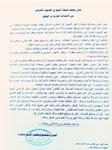
Click to enlargeSource: Social media
2. Communiqué by the National Salvation Government in Tripoli on 21 September 2015 concerning the events in Kufra. It condemns the involvement of "mercenaries and foreign fighters" that "confirms the strong involvement of foreign and regional countries in Libyan affairs".
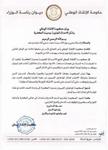
Click to enlargeSource: Social media
3. A communiqué par the Municipality of Kufra on 21 September 2015, considered as pro-Zway camp, praises the role of the "sons of Kufra in deterring invading gangs".
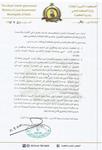
Click to enlargeSource: Social media
4. Communiqué by the Libyan interim government in Al Bayda, which warns against "foreign plans to take down Kufra that are being fomented by criminal gangs from neighbouring countries". Overall, it seems more reserved than authorities in Tripoli on the role of foreign armed groups.
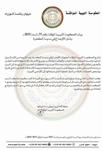
Click to enlargeSource: Social media
5. An order given by the LNA Chief of Staff to the Military Governor of Kufra on 21 September to use all means at his disposal, including aerial bombing, to stop the advance of "Tebu-affiliated forces to Kufra from the northern gate where they clashed with local tribes". Unlike preceding communiques by official Libyan parties, the LNA does not refer explicitly to the presence of foreign armed groups in Kufra region.
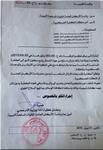
Click to enlargeSource: Confidential
6. Membership cards found in Kufra and published on Social Media following the bombing of the SLA/MM convoy on 21 September 2015.
Source: Social media
Source: Confidential source
Source: Confidential source
7. Photos of the bombing of the SLA/MM convoy north of Kufra. Interviews conducted by the Panel with Libyan officials from Kufra, Darfurian movements commanders and political activists in Chad corroborate the fact that the convoy belonged to SLA/MM, where a field commander Adam Orja was killed.
Source: Social media
Annex 8 GNC and HoR obstruction
The GNC and HoR leadership's obstruction of the restoration of Libya's political transition
The GNC leadership
1. After having boycotted two rounds of talks in Geneva in January 2015, GNC representatives only joined the political dialogue in Ghadames on 11 February.
2. Following the creation of the Sumud Front in Tripoli in June 2015, there were continuing reports of strong ties |2| between its uncompromising military leadership and the GNC political leadership, effectively continuing the hi-jacking of the capital and thereby preventing Libya's stabilization.
3. In July 2015, 18 out of 22 political dialogue participants signed the preliminary framework agreement. The four GNC representatives were the only ones boycotting the signing ceremony in Skhirat. It is not clear whether the text would have received the support of the majority of the GNC, as a motion to vote on the issue was consistently blocked by GNC President Abu Sahmain. |3| Significantly, the agreement received the support of certain representatives from the city of Misrata and the Justice and Construction Party, which had rejected a previous draft on 28 April. Previously, some of Misrata's most important military brigades had issued conciliatory statements in favour of the political dialogue.
4. The GNC's leadership intransigence and unwillingness to re-join the process reportedly also led to the resignation of two members of its negotiation team, including the head of the delegation and deputy GNC President Saleh Makhzoum on 26 August 2015. |4| The GNC's reappearance at the talks in September was short-lived, as it failed to propose any names for the GNA.
5. Since the passing of a 20 October 2015 deadline to approve the LPA, and the replacement of SRSG Leon, the GNC leadership has disengaged from the political dialogue and subsequently boycotted the LPA signing ceremony on 17 December. Mr. Sahmain's speech during SRSG Kobler's first visit to Tripoli on 1 January 2016 made it very clear that the GNC would not re-join the process but pursue its own parallel dialogue initiative. |5| Although Mr. Sahmain met with HoR President Agila Saleh Essa Gwaider on two occasions in Malta and Oman in December, the talks appeared to have yielded few results apart from showing opposition to the LPA.
The HoR leadership
6. Opposition of the HoR leadership to the political dialogue became an important obstacle to Libya's political transition when President Saleh failed to organise a vote on the final text of the LPA and the proposed names of the Presidency Council. HoR members accused Saleh of intentionally blocking the vote through his intensive travel schedule, and by mismanaging the plenary sessions, including a potentially decisive vote on 25 November 2015. |6|
7. President Saleh's recalcitrance and direct negative impact on the issue became especially apparent on 24 November 2015 when 92 out of 200 HoR members expressed their support for a proposal in a written declaration that largely approved the LPA draft. |7| The existence of a large group of HoR members in favour of the LPA was further confirmed when reportedly 88 of them attended the 17 December signing ceremony in Skhirat. |8|
8. Throughout December, President Saleh continued his opposition to the LPA and formed an unlikely alliance with GNC President Sahmain by attending several meetings of their parallel dialogue initiative. Given their previous overt animosity, their talks were mostly interpreted as an attempt to stop the implementation of the LPA.
Annex 9 Vessel bombings
Threats and bombings of commercial vessels and tankers
1. On two occasions, the LNA air force attacked tankers, damaging the vessels and killing and wounding crew members. The first vessel was the MT Araevo (IMO 90009009) in Derna on 4 January 2015, |9| while the second was the MT Anwaar Afriqya (IMO 9275268), which was attacked off the coast of Sirte on 24 May 2015. |10| The latter was accused by the Chief of Staff of the Libyan air force, Saqr Jerushi, |11| of carrying weapons and fighters. LNA officers stated that the vessel Araevo was suspected of transporting Islamist militants to Derna; |12| however, the Panel has no evidence of this, and has information which indicates that these attacks were carried out in order to strengthen the siege against those locations, preventing fuel from being unloaded to supply the power plants there. As a consequence of the attack on the MT Araevo, two crew members were killed. Regarding the Anwaar Afriqya, one crew member and a port worker were wounded.
2. On 2 July 2015, the western NOC decided to lift the force majeure on Ras Lanuf terminal that had been in force since December 2014. |13| Two tankers were dispatched to Ras Lanuf to load crude oil, MT Minerva Alexandra and MT Trident Hope. The latter was to load 700,000 barrels that were to be shipped to the refinery in Zawia. This refinery is barely operational due to the lack of crude oil. It is important to note that this refinery supplies power plants in Tripoli and other western Libyan cities.
3. The ships were expected to call at Ras Lanuf on 7 or 9 July 2015. Both ships were told not to enter port under the threat of being impounded by the PFG. Bayda authorities issued a warning on 10 July 2015 stating that the lifting of the force majeure status is the responsibility of the eastern NOC, therefore force majeure status on Ras Lanuf was still ongoing, |14| preventing any tanker from calling at that port until further notice.
4. Another attack took place on 9 May 2015 in the vicinity of Derna. The ship involved was the general cargo vessel Tuna 1 (IMO 9148491), owned by a Turkish company. |15| A Turkish crew member died as a result of the attack. Saqr Jerushi, the Chief of Staff of the Libyan air force, claimed that the air force had credible information about fighters being transported on board, however, the Panel was not provided with any evidence. The vessel's last port of call was in Spain; it was heading to Tobruk but approached Derna, close to which it was attacked within Libyan waters, as AIS data shows:
Source: Lloyd's AIS data, Google Earth
5. The following reports from the General National Maritime Transport Company (GNMTC), which is the Libyan State-owned shipping company, describe the attack carried out on the Anwaar Afriqya in Sirte. These reports do not support the allegation that fighters had been on board.
Translated from Arabic
Statement No. 1
At approximately 12 p.m. today, 24 May 2015, the Anwar Afriqiyya tanker was shelled while its cargo of diesel fuel was being unloaded at the Marsa power plant in Sirte, causing a fire to break out in the galley area behind the bridge and lightly wounding two individuals who were taken off the vessel and given appropriate first aid. Efforts are still underway to extinguish the fire. The Sirte port authorities and other maritime ports have been asked to help put out the blaze.
All relevant national authorities have been briefed with a view to furthering these efforts. We will provide updates on developments in a timely manner. The General National Maritime Transport Company Emergency Unit is coordinating with other units to provide the necessary rapid assistance.
Company Emergency Unit
Date: 24 May 2015
Time: 1500 hoursStatement No. 2
Anwar Afriqiyya tanker incident
Further to the Statement No. 1, released on the afternoon of 24 May 2015, concerning the shelling of the Libyan tanker Anwar Afriqiyya, which caused a fire to break out on board around the bridge and galley, please be advised that, as of 1900 hours on 24 May 2015, the tanker crew is still fighting the fire and requires essential fire-extinguishing and breathing equipment in order to contain the blaze.
As the equipment needed is unavailable in the port of Sirte or adjacent areas, the General National Maritime Transport Company has requested all national and foreign authorities to provide urgent assistance to help extinguish the blaze on board the vessel.
The General National Maritime Transport Company condemns this act, which violates all national and international norms. The Company is not responsible for the targeting of the civilian oil tanker fully loaded with diesel fuel at the Sirte power plant or the consequences thereof, for which the party that perpetrated the attack shall bear full legal and financial responsibility.
Company Emergency Committee
Date: 24 May 2015
Time: 1945 hoursStatement No. 3
Anwar Afriqiyya tanker incident
Further to the Statement No. 2, released yesterday, 24 May 2015, concerning the shelling of the Libyan tanker Anwar Afriqiyya, which caused a fire to break out on board near the bridge and galley, the Emergency Committee wishes to communicate to you that, as a result of its tremendous and continuous efforts over some 11 hours, from approximately 1200 to 2300 hours, the crew of the Libyan tanker Anwar Afriqiyya, despite its modest capabilities, has finally succeeded in containing the fire and preventing it from spreading.
A Libyan tugboat equipped with modern firefighting equipment has just arrived at the Sirte power plant, where the Anwar Afriqiyya tanker is docked, to help contain and extinguish the blaze. This is one of several Libyan tugboats summoned from nearby ports to support the firefighting operations.
We hope to provide timely updates on developments. The General National Maritime Transport Company Emergency Unit is meeting in permanent session around the clock and coordinating with other units to provide the necessary rapid assistance.
Company Emergency Committee
Date: 25 May 2015
Time: 0100 hoursStatement No. 4
Anwar Afriqiyya tanker incident
Further to the Statement No. 3, we are pleased to report that, as a result of their strenuous efforts, the crews of the tanker and the tugboats providing assistance have completely extinguished the fire.
Preliminary assessments of the damage are as follows:
1. The command room behind the bridge sustained a direct hit. The shell penetrated as far the lowest deck (Deck 1: skipper and chief engineer's quarters), causing a major conflagration on the bridge and the aforementioned deck. The shell exited from the fore of the skipper's quarters.
The crew of the tanker fought the blaze and took all measures to prevent it from spreading to the other parts of the tanker. The lowest deck as far as the skipper's quarters sustained moderate damage and uneven damage was caused to the next floor. The bridge, including all navigation and communications equipment, was completely destroyed and skipper's quarters deck was burned.
2. The crew of the tanker is afraid that it will be targeted again.
3. The tanker cannot neither unload its cargo with its own equipment nor set sail using its main or supplementary engines.
We hope to provide timely updates on developments. The General National Maritime Transport Company Emergency Unit is meeting in permanent session around the clock and coordinating with other units to provide the necessary rapid assistance.
Company Emergency Committee
Date: 25 May 2015
Time: 0900 hoursStatement No. 5
Anwar Afriqiyya tanker incident
Statement No. 4, released on the morning of Monday, 25 May 2015, referred to the aerial bombardment of the Libyan tanker Anwar Afriqiyya, which damaged the vessel and caused a fire on board near the bridge and galley. The blaze was successfully extinguished. However, the Company Emergency Committee now wishes to communicate that inclement weather, strong winds of up to 60 kilometres an hour and rough seas reaching Beaufort Force 7 have untethered the vessel from its mooring buoy and destroyed its cargo hoses. To prevent the vessel from running aground, the tugboats positioned nearby were obliged to push it into deeper water. The left anchor was then lowered to moor the vessel and prevent it from drifting.
Certain procedures and technical equipment are being employed to help restart the vessel's stalled generators so that they can fulfil their vital function.
The competent authorities have been contacted to coordinate efforts to tow the vessel to a safe harbour where the tanker can unload its cargo.
We hope to provide timely updates on developments. The General National Maritime Transport Company Emergency Unit is meeting in permanent session around the clock and coordinating with other units to provide the necessary rapid assistance.
Company Emergency Committee
Date: 25 May 2015
Time: 2300 hoursStatement No. 6
Anwar Afriqiyya tanker incident
Statement No. 5, released early in the morning on Tuesday, 26 May 2015, referred to the aerial bombardment of the Libyan tanker Anwar Afriqiyya, which damaged the vessel and caused a fire to break out in the bridge and galley. It described how the bad weather conditions yesterday had forced the crew of the tanker to lower the left anchor to prevent the vessel from drifting, and how the vessel had successfully been moored with the assistance of tugboats positioned nearby. The Company Emergency Committee is now pleased to communicate the following:
The operation to tow the Anwar Afriqiyya from the Marsa power plant in Sirte to the port of Misrata began at 1945 hours on 26 May 2015, following the great efforts made by the crews of the tanker, the participating tugboats and workers in the ports of Sirte and Misrata.
A Libyan tugboat is towing the vessel, and another tug is providing back-up support throughout the voyage. The tugboats are manned by a Libyan technical crew that specializes in towing operations. The tugs are rigged with all the equipment needed to carry out the operation.
Assisted by a team of supervisors from the Management of the Company who have reached the tanker, the crew of the tanker has been able to restore electricity on board. Attempts are still underway to restart the main engine.
All that remains is to pray for the success of the operation and the safety of all the crews involved, particularly in the light of ongoing challenges, unstable weather conditions and limited capacities.
We hope to provide timely updates on developments. The General National Maritime Transport Company Emergency Unit is meeting in permanent session around the clock and coordinating with other units to provide the necessary rapid assistance.
Company Emergency Committee
Date: 26 May 2015
Time: 2215 hoursStatement No. 7
Anwar Afriqiyya tanker incident
Statement No. 6, released in the evening on Tuesday, 26 May 2015, referred to the aerial bombardment of the Libyan tanker Anwar Afriqiyya, which had damaged the vessel and caused a fire to break out in the bridge and galley. The inclement weather conditions on the day following the shelling had forced the crew of the tanker to lower the left anchor to prevent the vessel from drifting. With the assistance of tugboats positioned nearby, the vessel had successfully been moored, and the towing operation began last night. The Company Emergency Committee now wishes to communicate the following:
The towing of the Libyan tanker Anwar Afriqiyya is proceeding well and safely. The vessel is travelling at a speed of some 3 knots owing to the inclement weather and current sea conditions, which are forecast to improve in the next few hours.
We pray for the safety of all those involved. The tanker is expected to reach the port of Misrata early tomorrow morning, 28 May 2015.
We hope to provide timely updates on developments. The General National Maritime Transport Company Emergency Unit is meeting in permanent session around the clock and coordinating with other units and relevant stakeholders to provide the necessary rapid assistance.
Emergency Committee
General National Maritime Transport Company
Date: 27 May 2015
Time: 1830 hoursStatement No. 8
Anwar Afriqiyya tanker incident
Further to Statement No. 7, released in the evening of Wednesday, 27 May 2015, concerning the aerial bombardment of the Libyan tanker Anwar Afriqiyya, which damaged the vessel and caused a fire to break out on board in the bridge and galley, and the ongoing operation to tow the vessel to the port of Misrata, the Company Emergency Committee wishes to communicate the following:
The towing of the Anwar Afriqiyya has been completed safely and successfully. The vessel entered and moored in the port of Misrata at 1030 hours this morning, 28 May 2015. The tanker was met in the port by a number of specialists from the General National Maritime Transportation Company, headed by the acting Director-General of the Company and several officials from national institutions and offices.
In coordination with all relevant parties, work is under way to unload the vessel's cargo and assess the damage it has sustained. Preliminary reports received from the tanker indicate that the vessel is unable to unload its cargo using its own equipment and cannot start its engines.
We hope to provide timely updates on developments as necessary. The Management of the General National Maritime Transport Company is monitoring the tanker around the clock and is coordinating with all other relevant stakeholders to assess damage. It is arranging for permanent repairs to be carried out at an approved dock. It is also providing all necessary assistance and support.
Emergency Committee
General National Maritime Transport Company
Date: 28 May 2015
Time: 1815 hours
Annex 10 Use of IEDs by ISIL
Images taken from IS related social media sources showing IED attacks claimed by IS in Benghazi
Source: Social media, 23 February 2015
Source: Social media, 23 February 2015
Source: Social media, 24 March 2015
Annex 11 GNC's statement in support of Zway in Kufra
The GNC-affiliated Chief of Staff Jaddallah Al-Obeidi praises the actions of revolutionaries in Kufra, and mourns "field commander martyr Tawfic Chouachine".
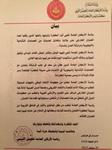
Click to enlargeSource: Social media, 20 September 2015
Annex 12 Casualties and destruction in Kufra
Civilian casualties, including children, in the Tebu neighbourhoods of Godrfei and Al -Shura, between July and October 2015
Source: Confidential
Material damage due to intense shelling and intense use of mortar bombs and tanks in Tebu neighbourhoods in Kufra
Source: Confidential
Tanks shelling Tebu neighbourhoods in Kufra, from the Material Supply Camp on the outskirts of the city
1. The camp is run by Adel Chouachine, affiliated with GNC-linked Libyan military. Adel is the brother of Tawfic Chouachine, killed during fighting in August 2015. This photo was shared by several pro-Zway Facebook pages. According to Tebu sources, this is the first time tanks were used in Kufra since the revolution in 2011, following the arrival of spare parts provided by the Sudanese military.
Source: Social media, 13 September 2015
Tawfic Chouachine, field commander during fighting in Kufra, killed in 2015
Source: Social media, 25 September 2015
Annex 13 Connections between national and local politics
Khalifa Haftar and Ali Shida, commander of Ahmad Al Sharif brigade, standing side by side in Benghazi in December 2014
Source: Social media, December 2015
Military order signed by Ali Themn, the late Commander of Operations in Benghazi, to recruit volunteers to join the LNA in Um Al Araneb, a Tebu-dominated area in Fezzan
Source: Social media, no date (believed to be late 2014 or early 2015)
A communiqué by Unit 320, Southern PFG, on 2 September 2015, declaring a split from Mehdi Lashi, and swearing allegiance to the GNC and the NSG
2. Interestingly, it praises the role of the NSG's Libyan General Intelligence Apparatus, under the command of Mustapha Nuh, who plays a prominent role in Tripoli. This document shows how polarization at the national level is not only deepening inter-tribal divisions, but also intra-tribal ones. The letter openly criticizes Lashi's "alliance with Khalifa Haftar".
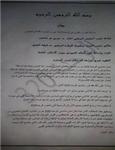
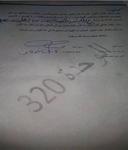
Click to enlargeSource: Social media, 2 September 2015
Annex 14 Attacks on foreign missions
Reported attacks against foreign missions
1. On 17 January 2015, three people were reportedly wounded after an IED attack on the Algerian embassy. The Panel asked Algeria for confirmation of the incident and additional information on the perpetrators. Algeria explained that two individuals approached the embassy and hid a package behind a guard house. An explosion ensued, resulting in light injuries of two members of the Libyan diplomatic police. The attack was claimed by ISIL on social networks.
2. A double IED attack was reported against the Iranian embassy on 22 February 2015. The Panel has asked Iran for confirmation of the incident and additional information on the perpetrators, and awaits a response.
3. The Moroccan embassy in Tripoli was targeted by a remotely controlled IED attack in the early morning of 12 April 2015. Morocco told the Panel that despite extensive damage to the building, there were no casualties. Morocco suspects the perpetrators were supporters of the former regime from the Fashloum district, but has received no further information from the authorities in Tripoli.
4. The embassy of the Republic of Korea was reportedly attacked by gunmen on 12 April 2015, resulting in the death of two security guards. The Panel has asked the Republic of Korea for confirmation of the incident and additional information on the perpetrators, and awaits a response.
5. On 20 April 2015, an IED attack caused EUR 16,000 of damage to the Spanish embassy in Tripoli's Chancellery. Spain told the Panel that it had not received any official information on the incident from the authorities in Tripoli, whom it does not recognise. The Spanish authorities have not been able to confirm alleged claims by ISIL of organising the attack.
6. On 22 May 2015, the Ukrainian ambassador was carjacked, resulting in the theft of a vehicle, documents and personal belongings. Ukraine told the Panel that after alerting both the local police and the diplomatic police in Tripoli, the perpetrators were arrested within the next 24 hours, and the car and some belongings were returned. Furthermore, that the Military Police who made the arrest explained that the perpetrators were ordinary criminals with a criminal history.
7. A similar incident involving the ambassador of Mali was reported on 25 June 2015. The Panel has asked Mali for confirmation of the incident and additional information on the perpetrators, and awaits a response.
8. On 12 June 2015, ten employees of the Tunisian embassy were reportedly abducted after the Consulate compound was attacked. The Tunisian embassy was one of the few diplomatic missions in Tripoli remaining open. There were widespread allegations that the attack was a reaction to the arrest of Fajr Libya commander Walid Ghleb earlier in Tunis. The Panel has asked Tunisia for confirmation of the incident and additional information on the perpetrators, and awaits a response.
9. On 28 September 2015, a grenade attack was reported against the Turkish consulate in Misrata. Although no damage was reported, the consulate closed down following the events.
10. On 8 November 2015, two employees from the Serbian embassy in Tripoli were abducted from a motorcade on its way to the Tunisian border. Following the dispatch of a note verbale to all Member States by the Committee, in follow-up to a recommendation contained in the Panel's interim report, on 24 November 2015 the Serbian Mission informed the Committee of the incident, explaining that the attackers opened fire on another vehicle used by its ambassador, resulting in the wounding of his driver. The Serbian authorities further informed the Panel that they had no additional information regarding the identity or affiliation of the attackers, other than that they drove off in the direction of Sabratha.
Annex 15 ISIL and BRSC in Benghazi
ISIL and the BRSC media showing their activities in the Sabri area
1. The Panel believes that the area of Sabri is physically too small for two armed groups to operate without coordination.
2. The two maps below show that Sabri is one of Benghazi's smaller northern districts and relatively isolated from the main area under BRSC control in southern Benghazi. The Panel cannot guarantee the total accuracy of these maps but assesses them to be sufficiently representative for the argument made above. It does not necessarily agree with any other information they contain.
Source: Libya Security Monitor, LNA advance near coast seeks to cut off rebel strongholds, 29 July 2015, https://medium.com/libya-security-monitor/lna-advance-near-coast-seeks-to-cut-off-rebel-strongholds-9c99a256f1e0#.yiskrapvm.
Source: Benghazi conflict map, @mutaz20042000, 4 April 2014, https://wakeupbenghazi.files.wordpress.com/2015/04/apr-4ht-scale.jpg.
3. Nevertheless, both the BRSC and ISIL have published images on social media showing activities and operations in Sabri in roughly the same period. This indicates that, at the very least, they respected each other's deployments and exchanged warnings of planned operations.
4. The following photographs show that ISIL has established basic defensive structures in Sabri, indicating that their positions are at least semi-fixed.
Source: Sabri, Caliphate soldiers penetrating in tunnels to conduct special operations in Al-Sabri, ISIL, 6 May 2015, http://justpaste.it/anfaq.
Source: Sabri, Caliphate soldiers resisting in Al Sabri area in Benghazi, ISIL, 31 May 2015, source: http://justpaste.it/lgdg.
Screenshot of a BRSC video publication, published on 3 April 2015, showing the armed group's military operations in Sabri
Source: https://www.youtube.com/watch?v=qhAG4E-w2Js.
Annex 16 BRSC communiqué
1. This communique by BRSC published on 27 December 2015 questions why they were excommunicated by ISIL and explicitly states that they sought reconciliation with ISIL. The latter replied two days later, publishing a communique accusing the BRSC of not taking a clear stance "against the GNC and Fajr".
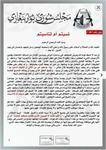
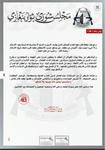
Click to enlargeSource: Social media, 27 December 2015
2. The Panel could not obtain a copy of the ISIL communique. However, the propaganda below shows how (some within) ISIL consider(s) AAS and the BRSC as infidels and even places them in the same category as the US. |80|
Source: ISIL propaganda on social media
Annex 17 AAS in DMSC-controlled areas
Ansar al Charia Derna continued to publish photos of promotional activities after the DMSC had ousted ISIL
Source: Derna, Mujahedeen distributing food on checkpoints in Derna during Ramadan, AASB, 27 June, https://dump.to/cwG.
Annex 18 Support by Tripoli to BRSC and DMSC
Official statements of support for the DMSC from the National Salvation Government Ministry of Defence and the Dar al Iftaa
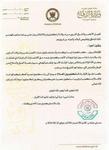
Click to enlargeSource: Social media, 15 June 2015
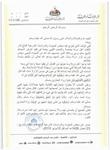
Click to enlargeSource: Social media. 10 June 2015
Official statement on 23 March 2015 from the National Salvation Government mourning the "martyrdom" of Mohammad Al Oreibi, a prominent commander of the BRSC
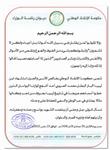
Click to enlargeSource: Social media, 23 March 2015
Annex 19 Dar al Iftaa links to Extremists
A communique issued by Dar Al Iftaa, concerning the arrest by SDF of the Director of Awqaf in Tripoli, where it denounces "arbitrary actions being undertaken by this armed group"
1. SDF has arrested the Director in order to interrogate him about the recruitment of young men by ISIL in Tripoli. More specifically, it interrogated him about the role of an Egyptian preacher arrested by the SDF at Mitiga airport, following his return from Ghana.
2. Several reports have indicated that many ISIL fighters have been recruited in mosques in Tripoli, which could hold the Awqaf responsible for its role in nominating mosques' preachers.
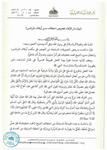
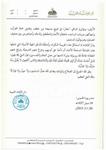
Click to enlargeSource: Social media, 26 November 2015
3. On 30 December 2015, Jalal Mohammad Omar, a preacher and TV presenter on the Dar Al Iftaa-affiliated TV channel Al Tanasuh, threatened Libyans that an Iraqi scenario of bombings and explosions would come if the GNA was appointed, comparing the GNA to what he described as "the Iraqi government put in place by Bremer". Paul Bremer was the Governor of Iraq in 2003-2004.
Source: https://www.youtube.com/watch?v=QNKawOp9TAA.
A screenshot from a video footage of Abd Al-Bassit Ghweila, known to be very close to the Mufti, who is mobilizing local supporters in order to wage 'Jihad in Libya', instead of Syria or Iraq. The video was made in Zliten in August 2014.
Source: https://www.youtube.com/watch?v=De5-LN8MXV8.
Annex 20 Appointment letter Faraj Mohammad Mansour
Decree from the interim Minister of Interior confirming the nomination of Faraj Mohammad Mansour as the head of the Special Missions Force, pursuant to the decision 81 of 2015 of former Interior Minister Omar Al-Sinki
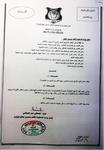
Click to enlargeSource: Social media, 12 June 2015
Annex 21 Gharghour massacre
Extract from video surveillance in the area of Gharghour very clearly indicating the involvement of major Misratan brigades in the events that took place
Source: Confidential
Annex 22 Blockages of humanitarian aid
Agreement signed between the Tebu and the Zway in Kufra on 11 October 2015 stipulating the removal of road blockades between Kufra and Ajdabiya, hand over the control of checkpoints to neutral forces, and grant the access of humanitarian delivery convoys to Kufra and its outskirts
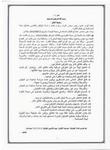
Click to enlargeSource: Social media, 11 October 2015
A communiqué by AMMAN NGO on 30 September 2015 denouncing the siege against Tebu neighbourhoods in Kufra
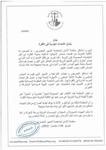
Click to enlargeSource: Confidential Tebu source
Social media source reporting on the blockage of a humanitarian convoy on the main road next to Al-Sarir oil field
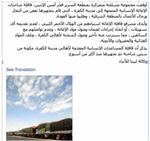
Click to enlargeSource: Social media, 3 October 2015
Annex 23 Turi Defense Group
1. Following a request for information, the United States provided the Panel with the publicly available United States of America vs. Marc Turi and Turi Defense Group indictment. |81| The case is based on allegations that Mr. Turi and the Turi Defense Group violated several articles of the United States' Arms Export Control Act including providing false documentation to a government agency related to a scheme to transfer military materiel to Libya through Qatar or the UAE in 2011.
2. The initial application by Mr. Turi to export military materiel, valued at USD 195 million, to the National Transitional Council (NTC) listed Dolarian Capital as an additional party. The application was denied on 22 March 2011 (indictment, paragraph 24). Subsequently Mr. Turi submitted two additional applications on 29 March 2011, one to transfer material to the value of USD 267 million to Qatar and another to transfer material of the same value and content to the UAE in June 2011. The indictment states that these requests were attempts to facilitate the transhipment of materiel to Libya via Qatar or the UAE (paragraph 24).
3. The Panel noted that the transaction was for a large quantity of material. However, the materiel on the list is an older generation of weapons, not the type of weapons in general use by modern defence services such as the UAE and Qatar. Therefore the question arose who the intended end user might have been.
4. Turi Defense Group had already conducted arms transactions in other countries, with United States permission, and the defence argues that Mr. Turi was working at the behest of the United States in this instance. |82| Court records show that Mr. Turi was in email contact with the United States Ambassador to Libya during April 2011. Ambassador Stevens replied that he would keep the information provided by Mr. Turi 'in mind' and share it with his colleagues in Washington. |83|
5. The public statement of a United States Senator, and the testimony of a former government official before a federal grand jury, in support of the defendant's motion, |84| indicate that the United States may have transferred weapons to Libya directly or indirectly in 2011. While the United States notified the Secretary-General under paragraph 4 of resolution 1973 (2011) of the provision of non-lethal equipment to the NTC in 2011 (S/2011/172), there was no notification made regarding transfers of lethal materiel.
6. According to the initial motion to dismiss the indictment, no weapons transfer took place pursuant to the requests. The Panel wrote to the United States to confirm the information and establish whether the United States authorities were involved in or aware of Mr. Turi's transactions with Libyan parties. A response is pending and the Panel continues its investigations.
Annex 24 Dolarian Capital Inc.
1. After the Revolution in 2011 and the fall of the Qadhafi regime, armed groups and other local actors ended up in control of the tremendous military stockpiles of the Jamahiriya. Some international brokers who had facilitated transfers to Libya during the revolution tried to organize transactions moving Libyan weapons out of the country.
2. The president of Dolarian Capital Inc., Ara Dolarian, was involved in trying to broker materiel to and from Libya during 2011. The Panel contacted the United States in 2012 and 2013 to obtain information about Mr. Dolarian's activities. The United States informed the Panel that an investigation was ongoing; subsequently the Panel received no further responses to its queries about the case.
3. According to information published by the Washington Post in 2015, |85| Dolarian Capital Inc. obtained approval from the United States authorities to export military materiel to Kuwait in 2011, for onward transfer to Libya. The Panel contacted the United States to request information about the activities of Mr. Dolarian and Dolarian Capital Inc. in relation to Libya in 2011 and enquired whether the company had obtained approval from the United States authorities to broker defence materiel to Libya, Kuwait, Qatar, or the UAE in 2011. A response is still pending.
4. In September 2011, a very large stockpile of bounding mines, referred to as 'Bouncing Betty' anti-personnel mines (APM), was documented near the Khamis Brigade headquarter in Tripoli by Human Rights Watch (HRW). The same week, Mr. Dolarian contacted United Nations representatives with a proposal to sell "Bouncing Betty" to the UN for disposal. According to Mr. Dolarian, 130,000 Bouncing Betty APMs were available in Libya for a total of USD 38 million (see email chain below).
5. A few days later, HRW witnessed the loading of the APMs into trucks and asked the individuals loading them where they were heading. The person they spoke to, a Libyan-American, explained that they were moving the mines to the Nafusa mountains with the agreement of the NTC. The Libyan-American was in contact with Mr. Dolarian who complained about the 'interference' a couple of days later. The United Nations did not buy the mines and the Panel has not heard anything about this materiel since it was moved from its original location; its whereabouts and status remains unknown. In his communications, Mr. Dolarian mentioned that: "The United Nations is the preferred buyer yet it is not the only buyer for these land mines and materials."
6. In his communications to the United Nations representatives Mr. Dolarian implied that he had already requested approval for exports of materiel to Libya from the United States authorities: "Dolarian Capital has begun making arrangements with its carrier to fly loads out of Libya, the first plane loads will be Bouncing Betty's. All plane loads out of Libya will be Dangerous Goods owned by Dolarian Capital, Dangerous Goods that it has purchased in Libya. Tomorrow Dolarian Capital will be making supplementary filing to its existing Libyan papers with the U.S. Department of State and the supplementary filling will be for the acquisition of Dangerous Goods in Libya".
Emails sent by Dolarian to UN representatives in 2011
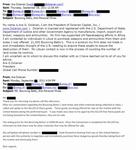
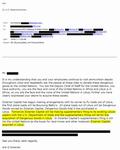

Click to enlargeCopy of Dolarian's request for prior approval to broker materiel from Libya dated 16 September 2011
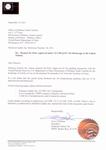
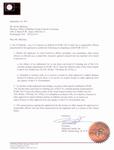
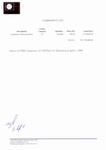
Click to enlarge
Annex 25 Updates on delivery of notified military materiel
1. The Panel contacted several Member States who had notified the Committee under paragraph 13 (a) of resolution 2009 (2011).
Bulgaria
2. Bulgaria responded that between 1 January 2012 and August 2015, no export of military materiel to Libya occurred.
Serbia
3. Serbia provided a detailed list of the status of the various exports licences they issued as well as the transfers they notified to the Committee. The details were provided separately to the Committee.
Turkey
4. Turkey communicated that out of the 20,000 handguns notified for export in August 2012, only 7,500 have been delivered to Libya. Turkey also mentioned that while the materiel notified in May 2013 (three automatic rifles and three sub-machine guns) had not been delivered, the four pistols notified in August 2013 had been.
5. Responses from the Belarus and the United States are still pending.
Annex 26 Illicit transfer of Armoured Personnel Carriers to Libya in 2012
1. In August 2012, Armoured Personnel Carriers (APCs) were transferred from the UAE to the 'Libyan Ministry of Interior' without prior notification. The vehicles, including Cougar, Spartan and Cobra types, were produced by Streit Group.
2. The Panel met representatives of Streit Group and received full cooperation. The documents provided by the company include authorisations for the transfers from various UAE administrative offices including the UAE Committee for Goods and Materials Subjected to Import and Export Control Executive Office, and the customs declaration, which mentions Streit Group as the consignee and Libya as the destination of the goods (see below). The Panel sent a letter to the UAE requesting additional information including details of the precise end-user. No response was received.
3. The Panel also provided Streit Group with an opportunity of rebuttal. In its response, the company 'strenuously reject any suggestion that Streit Group could knowingly or otherwise break national or international law'. They further mention that 'Streit Group's export actions were and continue to in complete accord with the governing UAE laws/regulations. In this instance, legal UAE export approval and EUC were obtained'.
4. Despite the fact that the UAE authorities authorised the transfer, the transfer occurred in violation of the arms embargo as it was not notified in advance to the Sanctions Committee.
Document: Clearance from the UAE Committee for Goods and Materials subjected to import and export control
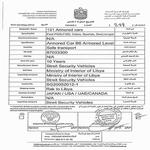
Click to enlargeDocument: Customs Declaration
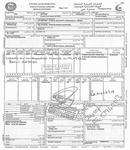
Click to enlarge
Annex 27 Transfers and potential transfers of materiel from the UAE
1. In 2013, the Sawaeq brigade procured new materiel including APCs, uniforms and rifles.
2. Nimr APCs are produced in the UAE by Nimr Automotive (State-owned Tawazun group). The Panel requested information about these transfers, however, the UAE did not respond.
3. AR-M9F rifles, produced by JSCo Arsenal in Bulgaria, have not been documented in Libya before 2013. While Bulgaria notified the Committee in March 2014 of the transfer of 5,000 AR-M9F to the Libyan Ministry of Defence, Bulgaria informed the Panel that the materiel was never delivered to Libya.
4. In 2014, Libyan individuals offered AR-M9F rifles for sale on Facebook (see below photographs). Armament Research Services (ARES), |86| a specialist technical intelligence firm, monitors some restricted Facebook Libyan market pages, and provided the Panel with complete details about one AR-M9F (serial number AB 46 7222), which the Panel asked Bulgaria to trace. The Bulgarian authorities informed the Panel that the International Golden Group originally imported the weapon and that the end user was the UAE Armed Forces. The International Golden Group is a company based in Abu Dhabi, and was previously involved in a violation of the Libyan arms embargo (see S/2013/99, paragraph 81). The Panel asked the UAE to provide information about this transfer but the authorities did not respond.
Photographs: Example of ARM-9F rifles on sale on restricted Libyan market Facebook pages
Source: ARES, 2015
Annex 28 Posts from Egyptian Air Force (EAF) Facebook page
Posted on 14 March 2015 |87|
Translation: Picture of 10 March of MiG-21 - previously Egyptian- in the service of the Libyan air force. Armed with unguided Nasr bombs produced by Egypt, weight 250 kg General purpose bomb
Posted on 14 March 2015
Translation: Egyptian Nasr-250 bomb in his first official appearance on its Libyan MiG-21 fighter jet (formerly Egyptian).
Annex 29 Investigations related to the transfers of Armoured Personnel Carriers (APCs)
1. Since the adoption of resolution 2095 (2013), transfers of non-lethal military materiel to the Libyan government are no longer subject to the arms embargo. In recent months, it has become clear that the Committee considers non-armed military armoured vehicles as non-lethal materiel. However, the Panel believes that all transfers of APCs should be under embargo as they significantly increase the military capability of armed groups. In addition, most types of APCs identified by the Panel can easily be mounted with weapons after delivery. The Panel is also concerned about diversions of this materiel to militias.
Seizure of armoured vehicles in Greece
2. In February 2015, the Greek authorities seized 8 APCs produced by Streit Group on board a vessel bound to Libya. Documentation indicated that the vehicles were supposed to be delivered to Tripoli. The seizure was reported in the media in July 2015 |88|.
3. Since the adoption of Resolution 2095 (March 2011), transfers of non-lethal military materiel to the Libyan government is not under embargo anymore. However, the destination of the vehicles being Tripoli, the end-user could not be the Libyan interim government which is based in Bayda since 2014.
4. Greece wrote to the Committee to seek guidance and the Panel investigated the case. The deal has been signed at the beginning of 2014 when the Libyan government was still in Tripoli. Details of the case were provided separately to the Committee.
MSPV
5. In May 2015, Facebook pages related to the LNA published photographs showing the delivery of armoured vehicles in eastern Libya. The vehicles appeared to be consistent with those manufactured by Minerva Special Purpose Vehicles (MSPV) based in the UAE (see photographs below).
Photographs: Panthera T6 delivered in Eastern Libya in 2015
Source: LNA Facebook page, photographs posted on 1 May 2015
6. The Panel contacted the company to obtain information about the specific end-user of the materiel. MSPV provided the document below, which indicates that the vehicles were destined to the Ministry of Interior.
Letter from the former Interior Minister dated 18 December 2014 asking the Libyan ambassador to the UAE to intervene in the blockage of the transfer of 100 armoured vehicles
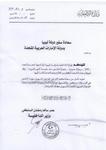
Click to enlargeSource: MSPV
Annex 30 Leaked UAE emails
Email Chain apparently leaked from the UAE Ministry of Foreign Affairs
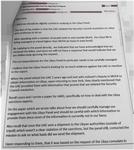
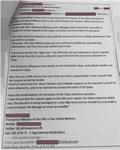
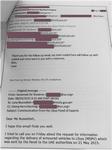
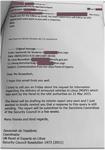
Click to enlargeSource: Confidential; redacted by the Panel
Annex 31 Investigation on potential transfers from Montenegro
1. In March 2015, the Panel was provided with an EUC signed by Khaled Alsherif on 15 December 2014 (see below). The document looks similar to previous EUC documents: the signature of Mr. Alsherif is consistent and the list of materiel is also consistent with the needs of armed groups in Libya. The EUC indicates that the Serbian registered brokering company, Tehnoremont, would purchase the materiel from the supplier, Montenegro Defence Industry.
2. The Panel contacted both Serbia and Montenegro to obtain further information and establish whether any contract had been signed and if any materiel had been transferred.
3. Serbia responded that Tehnoremont had never been in contact with Mr. Alsherif or been in possession of the EUC, nor had the company ever submitted a request to ship military equipment to Libya. The Serbian authorities also explained that there is no evidence in the records of the Ministry of Trade for the approval of the export of military materiel to Libya. Serbia also told the Panel that due to the sensitive situation in Libya, in June 2014, the authorities had recommended that arms and ammunition manufacturers desist from submitting licence request for exports to Libya and freeze ongoing transactions until further notice.
4. Montenegro said that no contract had been signed 'related to submitted copy of the EUC' and that no transfer had taken place. They did not deny the existence of the EUC.
EUC issued by the NSG Ministry of Defense
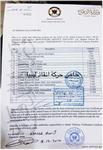
Click to enlargeSource: Confidential
Annex 32 Investigations about alleged transfers from Turkey
Information provided by Turkey in relation to alleged transfers reported in the Panel's previous report (S/2015/128)
1. In its last final report, the Panel reported two alleged transfers of military materiel by air from Turkey to Tripoli and Misrata.
2. In paragraph 184 of S/2015/128, the Panel reported that it had received first-hand information regarding the transfer of military materiel on a regular commercial passenger flight operated by Afriqiyah on 17 September 2014. The Panel interviewed a passenger of the flight who confirmed that while only 15 passengers had received their luggage, a significant number of wooden boxes of military materiel had been unloaded from the aircraft. After the submission of the last final report (S/2015/128), the Turkish authorities provided the Panel with the flight documentation, including the airway bill, which indicates that the cargo on board was a coffin and aircraft components for Afriqiyah.
3. In paragraph 185 of the same report, the Panel reported that it had received information about the transfer of military materiel on a flight operated by a Libyan air carrier, from Istanbul to Misrata on 13 November 2014. The Turkish authorities informed the Panel that following a check with their customs authorities, the flight only carried passengers' baggage and no cargo.
Annex 33 EUC from the NSG Ministry of Defense

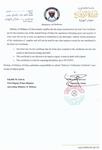
Click to enlarge
Annex 34 Haddad 1
Cargo manifest of Haddad 1 found on board the vessel
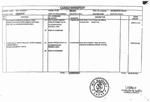
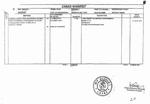
Click to enlargeCargo manifest provided by Turkey
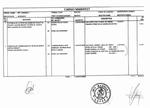
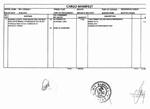
Click to enlarge
Annex 35 Transfers of shotguns, hunting rifles and related ammunition
1. Transfers of shotguns, hunting rifles and related ammunition have been occurring on a regular basis since the revolution, in violation of the arms embargo. The Panel visited shops and stalls selling these types of materiel in 2013. In 2015, eyewitnesses confirmed that this type of shop is still operating in Misrata and Tripoli. Materiel is regularly transferred to Libya by boat, mainly from Turkey but also from Greece, Italy and Malta.
Updates on previously reported cases
Malta
2. The Panel visited Malta in July 2015, and requested updates on previously reported cases of transfers. The Maltese authorities said that the prosecution of the various Libyan and Maltese nationals involved was ongoing, and that the authorities would update the Panel in due course. They also mentioned another potential case of transfer to Libya involving Mr. Azzopardi, who has already been involved in two violations of the arms embargo. The Panel hopes to receive additional information as soon as possible.
Turkey
3. Turkey said it would provide updates on cases previously reported, once information became available (see S/2015/128, paragraphs 15 and 16 of Annex 21).
New investigations
Italy
4. In November 2015, media articles reported the seizure of 170 carbines and 200,000 rounds of ammunition concealed in containers in Genoa port and destined to Misrata. |89| Following a request for information, the Italian authorities informed the Panel that the Public Prosecution Office of Genoa had launched a criminal investigation and provided a detailed report of the seizure. The report indicated that the Italian Guarda di Finanza had discovered 'the illegal entry of materiel into Italian territory without the necessary authorization from the Genoa Police and the attempt to violate the arms embargo on Libya' in May 2015. The materiel was concealed at the bottom of a container which was declared as transporting 'toys'. The Panel travelled to Genoa to inspect the materiel in January 2016.
Pictures: Air gun rifles seized by the Italian authorities
Source: Panel of Experts
5. Documentation provided to the Panel indicates that UAE-based companies originally purchased the materiel from three German firms.
6. Examination of the cargo manifest indicates that the shipper was North Africa Shipping, a company based in the UAE, which was previously involved in a violation of the arms embargo in 2012 (see Annex 26). According to their website, North Africa Shipping was founded in 1995 in Dubai with the aim of securing container shipments to Libya.
7. The Panel is of the opinion that these weapons were not intended as toys. Both the types of weapons discovered have muzzle velocities exceeding 200 metres/second, and the joule energy is 23 joule and 30 joule for the HW 80 and the 350 Magnum respectively, clearly establishing these weapons as firearms.
Turkey
8. Since January 2015, according to Turkey, its customs authorities have seized blank firing pistols and hunting rifles in two separate incidents in Ambarli Port in Istanbul. Legal action was commenced against two companies by the customs authorities. Turkey said it would provide the Panel with additional information on any developments related to the cases, as it became available. The Turkish authorities had already prevented an export from Ambarli Port in 2014 (see S/2015/128, Annex 21).
9. The Panel is currently investigating a potentially illicit transfer from Turkey to Libya, which was seized in Greece in September 2015 on board the Haddad 1 and included 5,000 shotguns produced by Torun in 2015, and ammunition produced by Yavascalar, two Turkish companies (see paragraph 154). The Panel has previously documented transfers of Torun materiel from Libya. In addition, Turkey provided detailed information about the case and informed the Panel that, in 2012, Yavascalar exported 325,000 "shotshells", and, in 2013, Torun transferred 5,000 shotguns to Libya in breach of the arms embargo. Turkey recently provided documentation about these transfers which the Panel is currently analysing.
10. Turkey reiterated to the Panel that materiel including "hunting rifles/cartridges, blank pistols and rubber bullets", are not subjected to exporting licences in Turkey. In 2013, Turkey contacted the Committee to request guidance about this issue. The Committee confirmed that this type of materiel is subject to the embargo. The Turkish authorities explained that, subsequently, they created a working group and circulated guidelines to all producers, exporters and relevant actors explaining that the transfer of this materiel required the approval of the Committee through the relevant Turkish authorities.
11. However, despite these efforts, since 2013 violations of the arms embargo involving transfers of this type of materiel from Turkey have continued.
12. For instance, in December 2015, the Panel examined 12 and 16 gauge shotguns that had been seized by the Tunisian military in 2015 on their way from Libya. These shotguns were produced by Torun in 2013 and 2014 (see Annex 36). The Panel is also investigating other cases.
13. Finally, some Turkish producers have also recently been posting advertisements onto Libyan Facebook groups focusing on arms sales highlighting the fact that they are considering Libya as a potential market. |90|
Annex 36 Additional information on arms transfers out of Libya
Transfers through Eastern borders
Egypt
1. During the mandate, the Panel has noted regular reports on seizures of weapons in the media and on the official Facebook page of the Egyptian armed forces, including from terrorist entities in the Sinai Peninsula. |91| Some of the photographs feature weapons that are typical of systems documented in Libyan arsenals.
Photograph of a member of Ansar Beit al Maqdis killed in the Sinai featuring an AK-103-2
Source: Facebook page of the Egyptian armed forces, 15 March 2015
2. The Panel met the Egyptian authorities in January 2016, and requested detailed information about transfers of arms from Libya to Egypt, including to groups in the Sinai and Gaza. They acknowledged that the security situation in Libya has a detrimental impact on Egypt, including the trafficking of arms. The authorities provided the Panel with quantitative data about seizures of arms operated in Egypt in 2015 (see Table below). However, the authorities did not provide details of the locations of these seizures, those involved, or the end-users, which would allow the Panel to investigate further. Despite repeated requests, the Panel has never been granted access to arms seized by the Egyptian authorities.
Table: Weapons and ammunition seized by the Egyptian authorities in 2015
Source: Egyptian authorities
3. During its visit to Israel, the Panel also obtained data indicating that some of the arms trafficking routes to Egypt and Gaza are still in operation. Weapons, mainly including small arms, light weapons and related ammunition, are smuggled overland and via the Mediterranean Sea. Maritime smuggling routes originate in Benghazi and Tobruk through Marsa-Matruh and El Salloum in Egypt. Overland trafficking routes originate in Benghazi and flow consecutively from there through Tobruk, El Salloum, Marsa-Matruh, Alexandria, Cairo, and Suez to Gaza.
Transfers through western borders
Tunisia
4. During the Panel's last visit to Tunisia, prosecutors and investigators in charge of the Bardo |92| and the Sousse |93| attack investigations told the Panel that the perpetrators, all Tunisians, had travelled to Libya to training camps in Sabratha at the end of 2014. According to them, the military materiel used during the attacks came from Libya.
5. Several seizures of arms from Libya were reported by the Ministry of Interior. For instance, a seizure made at the end of November was related to the same terrorist network that organized the Sousse attack (see below photograph). Some of the rifles, including an AK 103-2, are typical of those found in Libya.
Photograph of arms seized in a cache in Sousse in November 2015
Source: Ministry of Interior, Tunisia, December 2015
6. During the inspection of arms and ammunition originating from Libya, seized by the military on the border or in the southern militarised zone of the country, the Panel documented new shotguns produced by Torun (Turkey) (see below photograph). The Panel also documented ammunition of various calibres, including 7.62x51mm ammunition produced in Pakistan. The Panel had already documented this ammunition in Libya, and asked Pakistan to trace it in 2013. The ammunition was transferred from Pakistan to Qatar, which re-transferred it to Libya in 2011 in violation of the arms embargo (see S/2013/99, paragraphs 67 ff).
7. Following the inspection, the military also seized assault rifles including two FN FALs and 4 AK-type rifles.
Photograph: Torun 12 and 16 gauge shotguns seized when entering Tunisia from Libya
Source: Panel of Experts, Tunis, December 2015
8. The Panel also received the results of tracing requests regarding an FN FAL assault rifle seized by the Tunisian authorities in 2014. This was part of an order from 1981 and delivered to Qatar. This rifle was probably transferred by Qatar during the revolution (see S/2014/106, paragraph 57). This shows again how arms and ammunition transferred to Libya can proliferate outside the country.
Algeria
9. Statements from the Algerian authorities and media reports indicate that smuggling of arms from Libya to Algeria continues, and that a number of arms caches have been discovered in the south of the country. |94| In July, a network of arms traffickers smuggling materiel from Libya was reportedly dismantled in the Wilaya of Ghardaia. |95| In January 2016, the army announced that they had intercepted a convoy near the Libyan border, which included seven Libyan terrorists, arms and ammunition. |96|
10. The Panel wrote to Algeria several times requesting a visit, but received no response. The Panel hopes that Algeria will agree to share information on this issue with the Panel or the Committee as soon as possible.
Transfers through southern borders
Niger
11. Following are examples of convoys transporting members of Sahelian armed groups, arms and other illicit goods intercepted in northern Niger between September 2014 and May 2015, based on information from several confidential official sources.
17 September 2014
12. Arrest of Abu Asseem, in charge of communications for Al Mourabitoun (QDe.141), on the Salvador Pass, on his way to Libya. Sudanese national; joined AQIM (QDe.014) in Tombouctou in 2012. The aim of his mission was to go and meet Mokhtar Belmokhtar (QDi.136) in Ajdabiya to make a video about the In Amenas attack.
10 October 2014
13. Six pick-up vehicles were intercepted transporting three tons of armaments for Mali. According to the statements of the occupants, the arms had been provided by an Algerian national living in Ubari, Libya, from the Tareq Ibn Ziyad branch of AQIM (QDe.014). He retrieved them from a cache in the desert. The arms were destined for Iyad Ag Ghali (QDi.316), leader of Ansar Eddine (QDe.135), to be distributed between Ansar Eddine and another group linked to AQIM in northern Mali.
4 February 2015
14. The French and Nigerien authorities intercepted a convoy of six vehicles, which included eight members of the MNLA transporting a large quantity of arms and ammunition, and EUR 539,000 in cash. They claimed it was collected from people supporting the MNLA in Libya, however sources believe that the money was from a ransom payment. The vehicles were prepared in Ubari, from where the convoy departed, the destination was Kidal.
2 May 2015
15. In the far north of the country, the Nigerien army discovered an abandoned vehicle containing 1,700 rounds for assault rifles, one 82mm mortar launcher, 27 60mm mortar rounds, eleven 107mm rockets, one PKM and 60 radios, which they told the Panel were from Libya. The owner of the vehicle was not identified.
Arrest of armed drug traffickers
16. In January 2015, Libyan nationals from Qatrun were intercepted in possession of cannabis they loaded in Chad. They were equipped with a PKM and 258 rounds of ammunition coming from Libya.
17. In February 2015, a convoy of two cars was intercepted in northern Niger transporting drugs from Niger to Libya. The occupants were Tebus of Libyan and Chadian nationalities living in Murzuq. They were arrested with a significant quantity of arms (see sect. V.E). The Panel received results of its tracing request regarding the four FN FALs, three of which were sold to Libya by Belgium in the 1970s (serial number 49328 ordered in 1972; 82455 in 1974 and 188990 in 1977), one was sold to the DRC in 1970.
18. Finally, the Nigerien army and gendarmerie have also conducted regular small seizures of arms and ammunition in the north of the country, originating from Libya, from gold prospectors around Djado Plateau, armed robbers and traffickers of various goods.
Table: Seizures operated in northern Niger by the Nigerien military Jan-Sept 2015
Date Location Individual Materiel 12 January 2015 Chirfa Tchadian national 1 handgun, 1 AK type rifle and 20 rounds of ammo 27 January 2015 FEN - 1 RPG launcher, 2 PKM, 2 FAL assault rifles, 2 grenades and ammunition 27 January 2015 FEN 4 AK type rifles, 2 rockets, ammunition for AK and PKM, grenades and military uniforms 17 February 2015 Djado Nigerien national 1 handgun VZOKNR and 6 rounds of ammunition 2 May 2015 24 bia 1 PKM, 1 82mm mortar launcher, 1700 rounds of ammunition, 27 60 mm mortar rounds, 11 107mm rockets, 60 radios 10 May 2015 Djado Chadian nationals 160 rounds of 7.62x39mm ammunition 29 May 2015 Djado Nigerien national, gold digger 1 handgun Falcon Sport 17 June 2015 Djado Armed robbers, Nigerien nationals 3 AKs, 1 FAL and 75 rounds of ammunition 17 June 2015 24 bia Chadian National 1 AK and 30 rounds of ammunition 2 July 2015 - - 1 AK 10 July 2015 PMR DAO 1 PKM, 1 handgun, 1 RPG, 230 rounds of ammunition, 5 40mm rockets 17 July 2015 - - 1 AK 19 July 2015 Djado Chadian gold digger 1 AK and 4 rounds of ammunition 23 August 2015 Emi Fezzan, coming from Libya 1 AK 24 August 2015 Salvador Chadian national 1 AK, 78 rounds of 7.62x39mm ammunition, 2 handguns and 71 rounds 7mm ammunition 25 August 2015 Emi Bouli Malian nationals 2 PKM, 2 AK, 700 rounds of ammunition, 250 kg of cannabis, 27 August 2015 Emi Bouli Libyan national 1 Ak and 28 rounds of ammunition Source: Forces Armees du Niger, Oct 2015
Mali
19. Libyan military materiel is used by non-state actors in Mali, and has been documented in caches of terrorist groups in particular. |97| Information provided to the Panel by France in February and December 2015 indicates that, while the majority of arsenals maintained by terrorist groups in Mali come from Malian stockpiles, Libya is still a major source of materiel from them. According to the French authorities, 50 per cent of the materiel used by terrorist groups comes from Malian stockpiles, 40 per cent from Libya, and 10 per cent from other sources. With the clear diminution of seizures from Malian national stockpiles, Libya has become the main source of procurement for these groups.
20. Various types of materiel originating from Libya have been seized from a range of armed groups, mainly north of the Gao-Tombouctou line (see Table 2). While most of this materiel arrived in Mali after the imposition of the arms embargo on Libya, it is very difficult to provide accurate dates for their transfer to Mali. procurement chains.
21. Finally, the recent increase in violent clashes in Northern Mali between Malian armed groups suggests that these groups are likely to seek additional materiel.
Table: Types of materiel originating from Libya and used by terrorist groups in Mali
Type of Materiel Comments Weapons systems Assault rifles Anti-tank rockets launchers Machine guns of various calibres Recoilless guns Several SPG-9 types and 106 mm coming from Libya Multiple rockets launchers Between 4 and 6 BM 21 arrived from Sabha in early 2012 Vehicles Several armoured BRDM-2 and dozens of technicals (pickup trucks mounted with weapons systems) Ammunition Small and medium calibres Numerous boxes indicate Tripoli and Benghazi as original location of delivery Mortar rounds Rockets Several 107 mm rockets coming from Libya discovered in 2013 Anti-tank grenades Several crates of PG rockets which markings indicate Benghazi, Tobruk and Tripoli as original location of delivery Rifle grenades NR 434 originate from Libyan stockpiles Source: French authorities, February 2015
Annex 37 Libyan/Syrian trafficking network
1. The Panel confirmed the existence of a Libya-based network providing logistical support, including large quantities of arms, to Syrian rebels in the wake of the Libyan revolution. The Libyans involved with the network were all employed by either the Ministry of Interior or the Ministry of Defence. A part of its initial budget was provided by the NTC and it operated with the approval of at least a part of the NTC hierarchy. Syrian 'revolutionaries' in Tripoli participated in the daily operations.
2. Initially, supplies were gathered from existing stocks and a post-revolutionary surplus of arms. However, the quantity and quality of those weapons was considered insufficient by the end-users and facilitators. Subsequently, the Libyan network approached several arms brokers to import better quality materiel. Although the Panel has documented cases where EUCs signed by Libyan ministry officials were provided to suppliers, most of the materiel was never intended to remain in Libya.
3. The Tripoli-based Syrian Revolution Monitoring Office in Tripoli operated with the knowledge of high-ranking officers from within both civilian and military intelligence services, including Mustafa Nuh. The management of the office's activities, in terms of both finance and logistics, was in the hands of Ala' Abu Hafs and Fawzi al-Mu'ammari. A third Libyan security officer, Abdulhamed Elaleem, was used as a brokering agent traveling to meet with both the arms suppliers and the end-users from Syria. The Panel is still confirming additional names of those involved.
4. In Benghazi and the east, the collection of surplus arms destined for Syria was organized by the Rafallah al-Sahati Brigade, which was at the time under the command of Ismail Sallabi. |98| The Panel received reports that Rafallah al-Sahati received new and specific orders of materiel for transhipment to Syria and is still confirming such events.
5. Individual members of the network made personal profits from the smuggling operation through widespread corruption. They skimmed money from the operational costs, or kept certain quantities of the materiel.
6. Witness accounts, supported by corroborative data, indicate that finance and logistics were provided from several Gulf States including Qatar. They further confirm the Panel's previously reported information (see S/2014/106, paragraphs 191 -194). The Panel has contacted Saudi Arabia to clarify two reports of the involvement of Saudi nationals.
7. The same sources indicate that the arms were flown or shipped to Syria's neighbouring countries, notably Turkey and Lebanon, confirming the Panel's earlier findings. The Panel previously reported on transfers to Syria via Lebanon (see S/2014/106 paragraphs 195 -196) and Turkey (see S/2014/106 paragraphs 183 -190). Two sources also mentioned transfers to Syria via Jordan.
8. Following requests from the Panel, Turkey responded that since March 2011 no military materiel was transferred from Libya to Turkey and Jordan replied that it had not detected any entry of Libyan weapons, not allowing the use of its territory for such purposes.
9. So far, the Panel has identified the involvement of this network in three transfers to Syria and it expects that more will follow.
10. Firstly, information from confidential sources indicates that the network was responsible for loading three containers of arms on board the Letfallah II in April 2012 (see paragraphs 171-182 of S/2013/99). Secondly, the Panel also found that the January 2013 delivery of Caracal pistols to Mitiga (see paragraphs 125-131 of S/2015/128) was in part destined to be transferred onwards to Syria. The Panel is not yet in a position to report on the third case.
11. It should be highlighted that although attempts were made to create a single coordination mechanism for all transfers to Syria, parallel channels continued. Sponsoring States worked through preferred agents; other supply lines were more directly under the control of the Syrian opposition; and a third factor was the geographical distance between operations from eastern and western Libya.
12. The Panel has also contacted Syria to obtain additional information on the individuals involved and awaits its response.
Annex 38 Investigation about Nour M
1. The Panel reported the seizure of 1,100 tons of ammunition for assault rifles and machine guns in its previous report (see S/2015/128, paragraphs 142 ff). Information collected at this time indicated that the shipment was heading to Libya and had been signed by Khaled Al-Sherif. The Panel obtained additional evidence proving that the shipment was bound for Turkey. Information obtained by the Panel indicates that the shipment was intended to be transferred through Turkey to Syria.
2. The Panel analysed maritime traffic data, which indicates that the Nour M was not headed towards Libya, but to the eastern Mediterranean (see below for a snapshot of the last leg of the trip). In addition, the Panel was provided with transcripts of the interviews with the crew members arrested on board in Greece, which confirmed that the vessel was heading for Iskenderun.
3. From the various interviews, it appears that the captain, of Turkish nationality, and his first mate were aware of the nature of the materiel being transported on board and of the real destination of the vessel but kept this information from the rest of the crew, telling them that they were transporting chemical or plastic material and heading to Libya.
4. One crew member saw a document on the bridge indicating that the cargo was ammunition. In addition, during his initial interview by the Greek security forces, he declared to the authorities: "I have to add that at a certain point the Captain changed our initial route and when I asked him why he did that he answered that we would go to Iskenderun, Turkey, we would unload there some containers and we would continue with the remaining 6 containers to Libya. I asked the Turkish crew whether they knew about our route to Iskenderun and they said that they knew from the start".
5. The Panel requested information from Turkey about the brokering and transport companies registered in Turkey: the deal was brokered by TSS Silah ve Savunma Sanayi Dis Ticaret Limited Sirketi and the vessel belonged to TSS Group Tutun ve Sigara Sanayi ve Dis Ticaret Limited Sirketi. |99|
6. These companies have reportedly been involved in illicit activities in the past. |100| The Panel also requested that Turkey provide information regarding the financial transaction. It responded to the Panel that "brokering activities have not been regulated in Turkey yet and therefore brokers do not have to apply to permission for transaction which do not involve Turkish producers/buyers if the cargo does not touch Turkish soil". Turkish authorities were not able to provide records of financial transactions, as they are protected under Turkish legislation and may not be revealed without a court order. Finally, despite the Turkish companies violating the arms embargo against Libya, to the Panel's knowledge there are no prosecutions of these companies.
7. The Panel has also recently written to Ukraine, from where the shipment departed, to obtain additional information.
8. Finally, the Panel is concerned about the status of the materiel seized in Greece, which includes 1,100 tons of ammunition for assault rifles and machine guns (32 million rounds). The Panel understands the language used in paragraph 20 of resolution 2213 (2014) - 'dispose' - to mean the eventual destruction of the seized materiel. The Greek authorities informed the Panel that in the framework of the international efforts to counter ISIL, a multilateral program was underway for the 'disposal' of part of the seized ammunition as a contribution of Greece in this regard.
Map: Last leg of the trip of the Nour M
Source: Lloyd's List
Annex 39 Tracing of arms seized in Syria
Tracing of arms seized by the Syrian authorities from the opposition which are likely to have come from Libya
1. During its visit to Syria in December 2014, the Panel was provided with a 60-page list of weapons systems which the authorities consider may have originated from Libya, and which were seized by the Syrian army. However, owing to the inaccurate identification of the systems, and in many cases only partial marking information, the Panel was only able to request Belgium to trace 20 FAL assault rifles.
2. Belgium responded that it was unable to trace five of the items because of insufficient details. Belgium explained that eight of the weapons had likely been sold to Libya; two had definitely been sold to Libya; four to the United Arab Emirates; and one to Kuwait (see Table 1).
Table 1: Results of tracing requests of FN FALs seized in Syria
Markings Results of tracing request 1. 41751 Client number. The rifle is likely to be part of an order made by Libya in 1972. 2. 163858 Client number. The rifle is likely to be part of an order made by Libya in 1975. 3. 188187;190113; 201019; 203520; 208604; 203854 Client numbers. The 6 rifles are likely to be part of an order made by Libya in 1977. 4. 1013641 Serial Number. The rifle is part of an order made by Libya in 1973. 5. 1243240 Serial Number. The rifle is part of an order made by Libya in 1975. 6. 1297391 Serial Number. The rifle is part of an order made by Abu Dhabi in 1976. 7. 1436040; 1437404; 1473503 Serial Numbers. The 3 rifles are part of an order made by Abu Dhabi in 1978. 15. 1666463 Serial Number. The rifle is part of an order made by Kuwait in 1985. 3. While this further confirms that the Syrian opposition is using materiel that was transferred from Libya, it is proving very difficult to obtain information about the chain of transfer of this specific materiel.
4. The Panel contacted Syria in December 2015 to obtain additional information about potential transfers from Libya which the authorities may have detected. A response is still pending.
Annex 40 CBL cheques to BRSC
Copies of alleged Central Bank cheques made out to the BRSC, and translations thereof
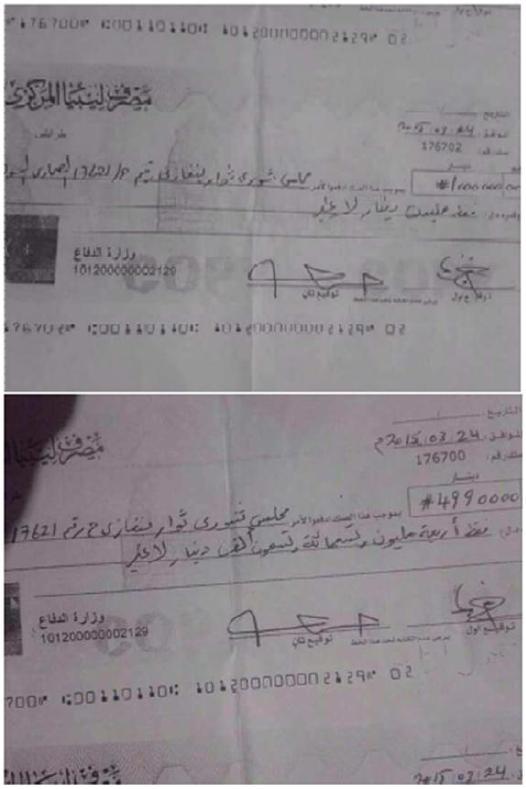
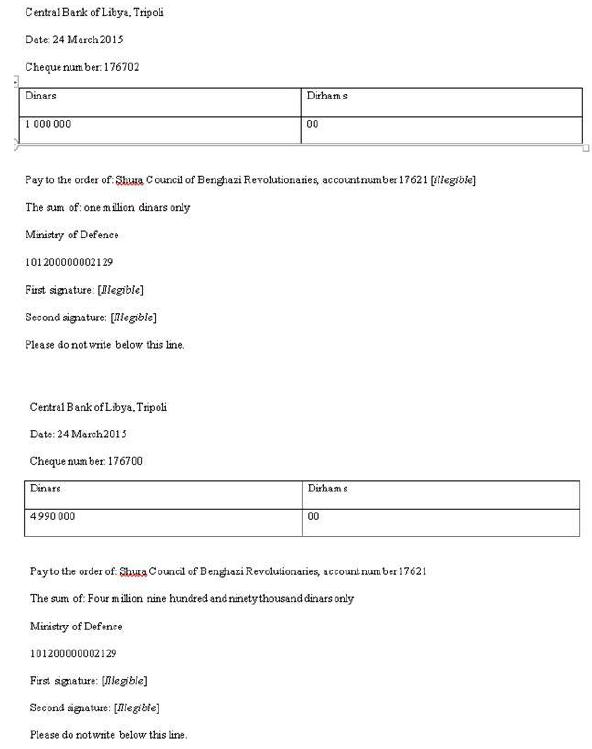
Click to enlarge
Annex 41 NOC statement
NOC statement on its responsibilities regarding the distribution of fuel
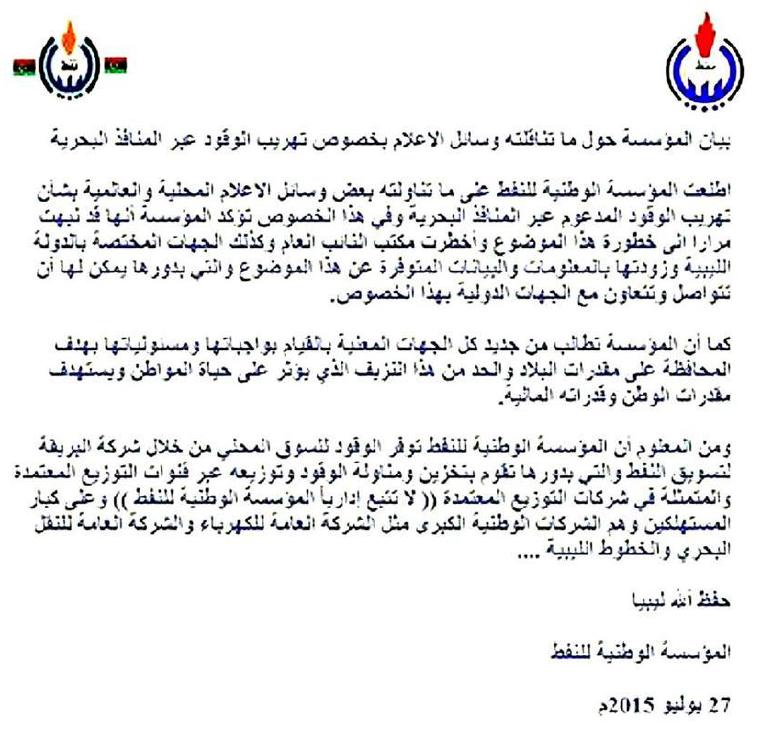
Click to enlarge
Annex 42 INTERPOL Red Notice on Mr. D'Aloja
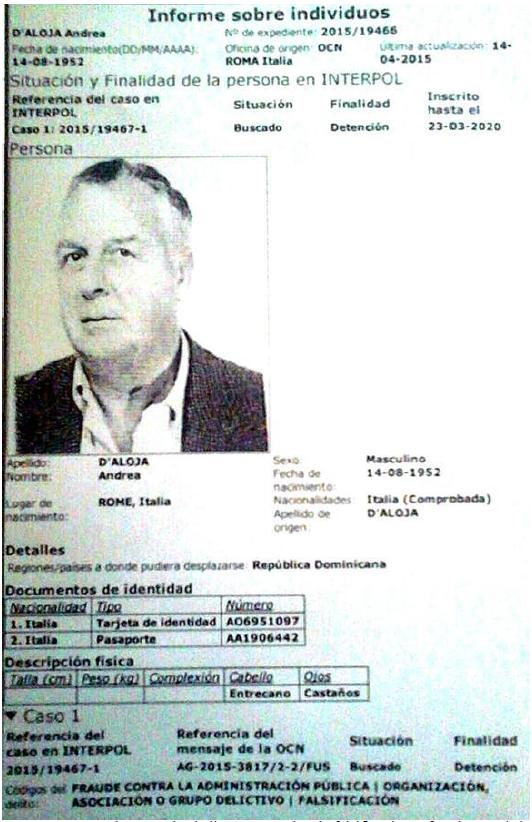
Click to enlargeSource: Interpol apresa dos italianos acusados de falsificación y fraude, Noticias Sin, 22 July 2015, http://www.noticiassin.com/2015/07/interpol-apresa-dos-italianos-acusados-de-falsificacion-y-fraude.
Annex 43 Fahmi Slim's smuggling network
1. One individual stands out in the fuel smuggling business from Zwara. All the sources indicate his name and activities: Fahmi Ben Khalifa, a.k.a. Fahmi Slim. He has a long record of smuggling. During the Qadhafi regime he was imprisoned for a period for drug smuggling.
2. Maltese authorities and sources on the ground have linked him with two vessels that are involved in fuel smuggling: Basbosa Star (IMO 8846838) and Amazigh F (IMO 7332488).
Basbosa Star
The vessel flies the Republic of Palau flag and is owned and managed by:

Click to enlargeSource: equasis.org
Source: marinetraffic.com
3. Further research on the companies involved (which share the same address in Malta) shows that ADJ Swordfish Ltd. changed its name to ADJ Trading Ltd. on 26 February 2014, the shareholders of which are as follows:
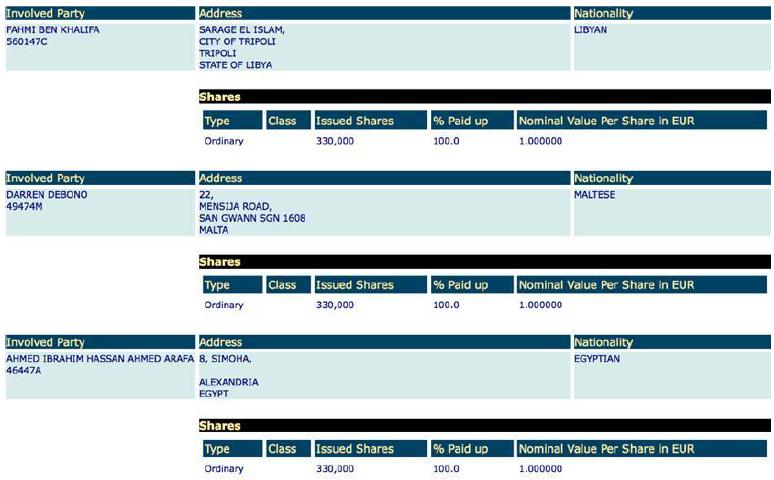
Click to enlargeSource: Maltese Registry of Companies
4. The company's operational address (ADJ Swordfish Limited) is PO Box 105, 1045, Majuro, Marshall Islands. This address is shared by the company Basbosa Shipping Company Limited, which is the registered owner of the Amazigh F.

Click to enlargeSource: Lloydsintelligence.com
5. The Amazigh F changed her name and registered owner in December 2015. The new name is Sea Master X and the new registered owner is Sea N 10 Company Limited, still located in the Marshall Islands, with the ship flying the Palau flag. |101|
6. Both vessels approached the Libyan coast during 2015, most of the times following the pattern of smugglers, that is to say, shutting down the AIS system when getting close to the Libyan coast.
7. The Basbosa Star approached Libya on 29 March 2015, 14 May 2015, 29 June 2015, 4 July 2015 and 17 July 2015. Within the same period the Amazigh F did so on 18 April 2015, 5 June 2015 and 5 July 2015.
8. Both vessels have been detected alongside each other on the following dates and coordinates between January and September 2015 |102|:
Date Lat Lon 12/02/2015 35,9175 14,83333 04/04/2015 35,90417 14,82639 01/07/2015 35,91889 14,82167 02/07/2015 35,91778 14,82083 12/07/2015 35,91361 14,8175 13/07/2015 35,91278 14,81778 16/09/2015 35,91639 14,81722 18/09/2015 35,91472 14,81778 19/09/2015 35,91444 14,81722 24/09/2015 35,90306 14,82306 Source: AIS data by Lloyd's
9. It should be noted that the positions in the table are on the limits of Maltese territorial waters.
10. Both vessels have also been alongside another vessel, Solia (IMO 6823131), on the following dates:
Date Vessels 03/09/2015 BASBOSA-SOLIA 04/09/2015 BASBOSA-SOLIA 11/09/2015 AMAZIGH F-SOLIA 12/09/2015 AMAZIGH F-SOLIA 26/09/2015 BASBOSA-SOLIA 26/10/2015 BASBOSA-SOLIA 31/10/2015 BASBOSA-SOLIA Source: AIS data by Lloyd's
11. Solia approached the vicinity of Zwara on 8 May 2015 (5 nautical miles off the coast) and on 15 June 2015. For the rest of 2015 the vessel remained around 12 miles off the Maltese coast.
12. One of the partners of Fahmi Slim in ADJ Trading Limited, Darren Debono, also owns the company Andrea Martina Limited (C41309, Maltese Registry of Companies), which also operates the vessel Bonu 5, |103| as can be seen in the following documents:
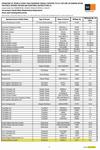
Click to enlargeSource: Malta Transport Centre
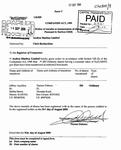
Click to enlargeSource: Maltese Registry of Companies
13. According to marine traffic data, the Bonu 5 approached the Amazigh F and the Basbosa Star on 24 September 2015, resulting in all three of them alongside each other.
14. The following image should help simplify the links depicted above:
VESSEL COMPANY ADDRESS INDIVIDUALS AMAZIGH F BASBOSA SHIPPING MARSHALL ISLANDS |104| UNKNOWN FAHMI SLIM BASBOSA STAR ADJ TRADING MARSHALL ISLANDS |105| AHMED ARAFA DARREN DEBONO BONU 5 ANDREA MARTINA MALTA DARREN DEBONO 15. Fahmi Slim runs another Libyan company, Tiuboda Oil and Gas Services. According to documentation dated 26 August 2014, issued by the Ministry of Economy of the Libyan Interim Government to the Maltese authorities, Tiuboda Oil and Gas Services LLC was a company registered and duly inscribed with the said Ministry on 23 March 2012 under commercial register No. 41992 and licence No. 4541992, and has the right and is entitled to carry out the activity set out in the company's Memorandum of Association. As this company is not registered in Malta, no further information is available thereon. This documentation was made available to Maltese authorities regarding a request to import oil from Libya via the said Tiuboda Oil and Gas Services LLC, which the Maltese authorities then refused.
Source: Confidential source, extract of document
16. Fahmi Slim has already been mentioned in the media as one of the main protagonists of smuggling networks in Zwara. |106| He has rebutted publicly those allegations. |107|
17. It should be noted that the fuel was subsidised until the CBL proposed abolishing subsidies for fuel and other products in October 2015, |108| and the NSG (which controls Zwara) approved this in November. |109|
18. This should reduce the income of smugglers, but it remains unclear how it will actually be implemented, as well as what real impact it will have on smuggling, primarily because prices of gasoline and diesel in Libya will remain far lower than in neighbouring countries. Prices in Libya are expected to rise up to USD 0.34 per litre of gasoline and USD 0.50 per litre of diesel, |110| while in Tunisia, gasoline is USD 0.77 per litre and in Chad, gasoline prices reach USD 0.74 and diesel USD 0.90 per litre. In Malta, gasoline is sold at USD 1.46 per litre. |111|
Annex 44 Fuel smuggling
Sun Oil I
1. This vessel was taken to Tripoli on 2 January 2015, allegedly after making a distress call because of mechanical problems. According to Romanian authorities, the ship was sold to the Maltese company BTZ Valetta Company Limited, on 20 September 2013. On 20 January 2014, the vessel was deleted from the registry of Constanta harbour (Romania). Therefore, the ship could not fly the Romanian flag, and adopted the flag of Moldova.
2. According to available AIS positions, after being sold to BTZ Valetta Company Limited, the vessel approached the Libyan coast on several occasions after June 2014. Her movements were confined to Malta, the Libyan coast and the Southern Italian coast. The ship approached Libya on 28 June 2014, 28 August 2014 and spent several days in the vicinity of Zwara between 8 and 16 September 2014. Finally, the Sun Oil I again approached Zwara on 7 December 2014. No positions are available for 26 days, until the vessel appeared again on 2 January 2015, heading to Tripoli, as shown in the following image.
Source: AIS data provided by Lloyd's
BTZ Valletta Company Limited (C59405, Maltese Registry of Companies) is owned by BTZ Holding International Limited, whose directors are:
Source: Maltese Registry of Companies
3. Andrea D'Aloja is the same individual arrested in the Dominican Republic and mentioned in Annex 42. The Italian authorities made a number of arrests in December 2014 related to this case. This investigation, known in Italy as 'Mafia Capitale', has many different strands, one of them concerning fraudulent sales of fuel to the Italian Navy, potentially from Libya. According to media reports the transactions involved Libyan vessels, Maltese companies and Italian citizens. Andrea D'Aloja uploaded one photograph of the Sun Oil I to the website www.marinetraffic.com:
Sovereign M
4. This vessel was impounded in the vicinity of Zwara on 27 August 2015 and taken to the port of Tripoli. Since March 2014 there are no official documents of the ownership of the vessel, but the following document found on board indicates that the Maltese company Patron Group Limited is the shipper. Sources in Libya confirm that crew members verified this information:
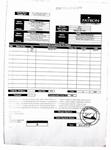
Click to enlargeThe Board of Directors of Patron Group Limited (C35360, Maltese Registry of Companies) consists of:
Source: Dun & Bradstreet
An invoice was found on board the Sovereign M, involving another Maltese company:
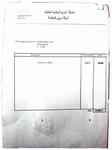
Click to enlarge5. The seal in the oil certificate above is the same as in the gasoil certificate of origin in paragraph 9 below where it is confirmed that the seal is related to the Zawiya refinery. The refinery is not being supplied by pipelines, as it used to receive crude oil from oil fields in El Sharara (NC 115 and NC 186), but the pipeline remains closed since El Sharara fell under the control of the Misratan Third Force in November 2014.
Mechanik Chebotarev
6. On 16 September 2015 this vessel was impounded in the vicinity of Zwara on suspicion of smuggling fuel from Zwara. She was taken to Tripoli, and on 17 September 2015 to Misrata, arriving on 18 September 2015.
7. According to information provided by the Russian Federation, the vessel set sail from the port of Kavkaz (Russia) to Izmir (Turkey) but diverted her route to the coast of Libya. The chartering company is a Maltese company, 360 Marine Trading Limited, and the contact person is Rodrick Grech, owner of the company Six Seven Eight Limited, also based in Malta.
8. Rodrick Grech has registered the following domain names, among others:
9. It is noteworthy that Petro Plus Limited is a company known to the Panel for being the charterer of the vessel Ruta (IMO 8711899), mentioned in the Panel's interim report in 2014, |112| a Ukrainian vessel that was allegedly carrying smuggled fuel from Zwara in July 2014, as shown in the cargo manifest below:
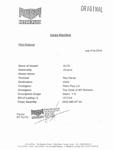
Click to enlarge10. And also on the certificate of origin of the fuel, found on board the Ruta:
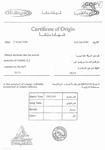
Click to enlarge11. The company owning the Ruta also owns the Inzhener Valchuk (IMO 8711825) which has also been identified as having been near Zwara, on 2 May 2015, 5 July 2015 and 28 July 2015. This vessel was also identified by several sources on the ground as being involved in smuggling operations. She follows the sailing pattern of a smuggling vessel. The related company is Manchester Shipping, |113| based in Odessa (Ukraine).
12. According to interviews conducted by the Panel in December, most crewmembers of the Mechanik Chebotarev have been released, and a judicial case has been opened by the prosecutor in Misrata. The charges against the crew are reportedly related to 'irregular sailing' within Libyan territorial waters. For this reason some members of the crew remain in Misrata to face trial. They cannot be prosecuted for fuel smuggling as at the time of the impounding, the vessel had not yet loaded the fuel.
13. The following image simplifies the relations established:
VESSEL COMPANY ADDRESS INDIVIDUALS MECHANIK CHEBOTAREV 360 MARINE TRADING MALTA RODRICK GRECH RUTA PETRO PLUS LIMITED MANCHESTER SHIPPING MALTA RODRICK GRECH INZHENER VALCHUK MANCHESTER SHIPPING ODESSA UNKNOWN
Annex 45 Armed group transport of illegal migrants
Photograph taken by migrants transported by an armed group in Libya, showing the logo of Sariyat Istanbul
Source: Confidential
Annex 46 Letters of credit
1. Lists of letter of credits that have benefited to Haytham Al-Tajuri and his business associates. The list also includes the list of fake companies and the amount for which they applied. The document also mentions threats that were made by Mr. Tajuri and his associates to the CB and commercial banks employees. In addition to Haytham Al-Tajuri, the table contains the names of his associates.



Click to enlargeSource: Confidential
Annex 47 Armed group protection of a construction company
Legal translation of a complaint against a construction company receiving protection from the SDF
The Panel received further documentation related to the case.
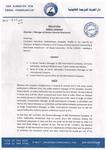
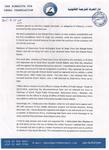
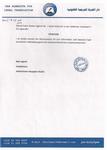
Click to enlarge
Annex 48 Oil ports in Libya
OIL PORTS REFINERY KNOWN EXPORTS REGION CONTROL ALLEGIANCE MARSA AL HARIGA TOBRUK YES EAST TOBRUK LNA ZUEITINA FORCE MAJEURE OIL CRESCENT TOBRUK JADHRAN MARSA AL BREGA MARSA AL BREGA OIL CRESCENT TOBRUK JADHRAN RAS LANUF RAS LANUF FORCE MAJEURE OIL CRESCENT TOBRUK JADHRAN SIDRA FORCE MAJEURE OIL CRESCENT TOBRUK JADHRAN ZAWIA ZAWIA WEST TRIPOLI LOCAL MILITIAS MELLITA H WEST TRIPOLI LOCAL MILITIAS BOURI YES WEST TRIPOLI LOCAL MILITIAS FARWA (AL JURF) YES WEST TRIPOLI LOCAL MILITIAS SARIR SOUTH EAST TOBRUK LNA Source: US Energy Information Administration
Annex 49 Letters from eastern NOC
Letters addressed to the Panel of Experts from the eastern authorities that never reached the addressee
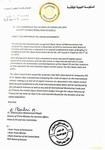
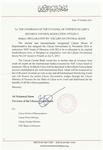
Click to enlarge
Annex 50 Eastern NOC letters to oil companies
Documents provided by the Chairman of the eastern NOC
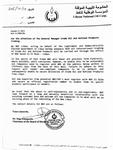
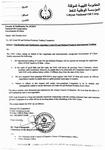
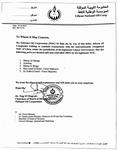
Click to enlargeSource: Confidential
Annex 51 Statement by Ibrahim Jadhran
Statement by Ibrahim Jadhran, leader of the Petroleum Facilities Guards-Central Region
Source: Social media, 1 November 2015
Annex 52 Eastern NOC threatening companies with consequences
Letter from the Chairman of eastern NOC
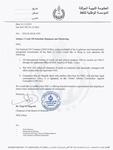
Click to enlargeSource: Confidential
Annex 53 Order of eastern NOC for delivery
Letter signed by Nagi Elmagrabi requesting 6,500,000 barrels to be delivered to Marsa Al Hariga
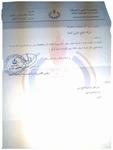
Click to enlargeSource: Confidential
Annex 54 Maltese court transcript

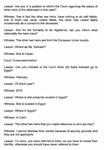
Click to enlarge
Notes:
*. The annexes are being circulated in the language of submission only and without formal editing. Owing to the word limits on reports of monitoring mechanisms, the Panel has provided further details relating to a number of investigations in the annexes. The table of abbreviations and acronyms can be found in annex 1. [Back]
1. See, for example, David D. Kirkpatrick, "Leaked Emirati emails could threaten peace talks", New York Times, 13 November 2015, available from www.nytimes.com/2015/11/13/world/middleeast/leaked-emirati-emails-could-threaten-peace-talks-in-libya.html?_r=0. [Back]
2. See his statement of 16 December 2015, available from https://unsmil.unmissions.org/Default.aspx?ctl=Details&tabid=3543&mid=6187&ItemID=2099393. [Back]
3. See "The Saudi Arabian Abu Hakim al-Jazrawi: from university to bombing the security directorate in Benghazi", Al-Wasat, 24 June 2015, available from www.alwasat.ly/ar/news/libya/77441. [Back]
4. See "Haftar threatens the tribes of eastern Libya that he will replace them with African fighters", Al-Arabi al-Jadid, 2 August 2015, available from www.alaraby.co.uk/politics/2015/8/1/[text in Arabic] [Back]
5. See "How was Khalifah Haftar received in Chad?", Arabi21, 12 October 2015, available from http://arabi21.com/story/865255/[text in Arabic]. [Back]
6. See www.youtube.com/watch?v=_4XZER0OKMg. [Back]
7. Armed groups also clashed on several occasions in Khums. [Back]
8. See "The full story of how the youth Abdulmun'im al-Duwaylah joined ISIL", 218 TV, 5 January 2016, available from http://218tv.net/content/[text in Arabic]. [Back]
9. See "Libya: ISIL claims responsibility for a bombing near Misratah", Sky News Arabia, 3 1 May 2015, available from www.skynewsarabia.com/web/article/[text in Arabic]. [Back]
10. See "23 deaths, including the commander of the western region, in a helicopter crash", Libya al-Mustaqbal, 27 October 2015, available from www.libya-al-mostakbal.org/news/clicked/82770. [Back]
11. See "Daesh bombs the intelligence headquarters in Sabrathah", Erem News, 19 December 2015, available from www.eremnews.com/news/arab/400426. [Back]
12. See "Death toll rises from indiscriminate shelling of protests in Kish Square in Benghazi", Al-Alam al-Yawm, 23 October 2015, available from www.worldakhbar.com/maghreb/libya/38785.html. [Back]
13. The Panel previously reported on potential collaboration between the two groups (see S/2015/128, para. 34). [Back]
14. See Jared Malsin and Chris Stephen, "Egyptian air strikes in Libya kill dozens of Isis militants", Guardian, 17 February 2015, available from www.theguardian.com/world/2015/feb/16/egypt-air-strikes-target -isis-weapons-stockpiles-libya. [Back]
15. See Sarah El Deeb and Lolita C. Baldor, "US targets Al-Qaida-linked leader in Libya; unclear if hit", Associated Press, 15 June 2015, available from http://abc30.com/news/us-targets-al-qaida-linked-leader-in-libya;-unclear-if-hit/785800/. [Back]
16. See Phil Stewart, "US confirms death of top Islamic State leader in Libya", Reuters, 7 December 2015, available from http://uk.reuters.com/article/us-mideast-crisis-airstrikes-usa-idUKKBN0TQ24G20151207. [Back]
17. See Saber Ayyub, "Mystery remains over Sirte airstrikes on IS", Libya Herald, 15 January 2016, available from www.libyaherald.com/2016/01/15/mystery-remains-over-sirte-airstrikes-on-is/. [Back]
18. See "In pictures: ISIL in Libya calls for the killing of Hisham al-Ashmawi, who is accused of assassinating the Public Prosecutor, and announces its presence in Darnah", Al-Bidayah, 19 August 2015, available from http://albedaiah.com/news/2015/08/19/95184. [Back]
19. See "The Tebu and Tuareg agreement in Doha: the one thousand mile road to peace", Al-Arabi al-Jadid, 24 November 2015, available from www.alaraby.co.uk/politics/2015/11/24/[text in Arabic]. The statement does not acknowledge Chadian involvement in the talks. [Back]
20. Ibid.; see also www.facebook.com/sabha17feb2/videos/1001598166564528/. [Back]
21. Interviews with Islamist figures in Benghazi, November 2015. [Back]
22. See "Interview with Abul-Mughirah al-Qahtani (the delegated leader for the Libyan wilayat", Dabiq, No. 11 (September 2015), available from www.clarionproject.org/docs/Issue%2011%20-%20From%20the%20battle%20of%20Al-Ahzab%20to%20the%20war%20of%20coalitions.pdf. [Back]
23. See S/2015/891, para. 18. Sources told the Panel that that faction included Commander Sofiane ben Goumo (QDi.355). [Back]
24. See S/2015/891, para. 18. Sources told the Panel that that faction included Commander Sofiane ben Goumo (QDi.355). [Back]
25. See the tenth report of the Prosecutor of ICC to the Security Council pursuant to resolution 1970 (2011), available from www.icc-cpi.int/iccdocs/otp/otp-rep-unsc-05-11-2016-Eng.pdf. [Back]
26. See Hanan Salah, The Endless Wait: Long-term Arbitrary Detentions and Torture in Western Libya (United States, Human Rights Watch, December 2015), available from www.hrw.org/sites/default/files/report_pdf/libya1215_4up_ 1.pdf. [Back]
27. Interviews with government officials and families of the victims, August-October 2015. [Back]
28. See https://clearnews.com/865/. [Back]
29. See Human Rights Watch, "Libya: widespread torture in detention", 17 June 2015, available from www.hrw.org/news/2015/06/17/libya-widespread-torture-detention. [Back]
30. Interview with military sources from Benghazi, October 2015. [Back]
31. See www.youtube.com/watch?v=iyO5DSh1nls. [Back]
32. Series of interviews with key political and military leaders from southern Libya, 2015. [Back]
33. Muhammad al-Uraybi was killed during fighting in Benghazi on 23 March 2015. [Back]
34. See www.youtube.com/watch?v=zqQ5KAMrCDI. [Back]
35. The requirement to notify transfers of non-lethal materiel to the Government was lifted by the Security Council in resolution 2095 (2013). [Back]
36. Available from www.un.org/sc/suborg/sites/www.un.org.sc.suborg/files/implementation_assistance_notice_2_1.pdf. [Back]
37. In December 2014, the interim Government informed the Committee that the Chief of Staff of LNA, General Nadhouri, was the only authorized person for requests for exemptions from the arms embargo and the signature of end-user certificates. [Back]
38. Available from www.facebook.com/wajaak/videos/1686249688285048/. [Back]
39. Original photographs of the aircraft were provided by confidential sources and the Panel was not authorized to publish them. The Panel has placed the evidence in secure United Nations archives. [Back]
40. Egypt applies Indian numerals to its military aircraft, while Libya uses arabic numerals. [Back]
41. See John Simpson, "Libyan in £19m arms deal posed as Welsh imam", Times, 27 October 2015, available from www.thetimes.co.uk/tto/news/uk/crime/article4597154.ece. [Back]
42. See "Ascoli, Giorgi e prigioniero in Libia - presto sara libero, ma non ha medicine", Corriere Adriatico, 29 May 2015, available from http://www.corriereadriatico.it/ASCOLIPICENO/ascoli_giorgi_libia/notizie/1381923.shtml. [Back]
43. See Umberto Bacchi, "Greece: seized cargo ship Haddad 1 concealed 5,000 shotguns for Libya Islamists", International Business Times, 3 September 2015, available from www.ibtimes.co.uk/greece-seized-tanker-haddad-1-concealed-5000-shotguns-libya-islamists-1518372. [Back]
44. See http://torunarms.com/ and www.yavascalar.com.tr/, respectively. [Back]
45. See www.conflictarm.com/. [Back]
46. See www.mic.sd/pages/ar/home. [Back]
47. See "Quand le Qatar et la Turquie payent des pilotent mercenaires pour bombarder en Libye", Menadefense.net, available from www.menadefense.net/2015/12/09/qui-est-le-contractor-blanc-qui-pilote-des-mirages-en-libye/. [Back]
48. See United States, House of Representatives, Permanent Select Committee on Intelligence, Investigative Report on the Terrorist Attacks on U.S. Facilities in Benghazi, Libya, September 11-12, 2012 (21 November 2014), available from http://intelligence.house.gov/sites/intelligence.house.gov/files/documents/Benghazi%20Report.pdf, and United States, Senate Select Committee on Intelligence, Review of the Terrorist Attacks on US Facilities in Benghazi, Libya, September 11 -12, 2012 together with Additional Views (15 January 2014), available from http://fas.org/irp/congress/2014_rpt/benghazi.pdf. [Back]
49. See "Al Zway: we will contest Ghwel's decisions", Ayn Libya, 7 December 2015, available from www.eanlibya.com/archives/45956. [Back]
50. The Panel interviewed migrants from six countries, Libyan smugglers and government officials from Italy, Libya, Malta and Tunisia. [Back]
51. ISIL-controlled territory is an important corridor used to bring migrants to the Libyan coast. While some convoys were attacked, the large majority went through. [Back]
52. See www.lia.com.mt/en/what-is-law-13/. [Back]
53. Listed as the Libyan Foreign Investment Company as an a.k.a. of the Libyan Investment Authority (LYe.001). [Back]
54. See "Libya's PM Al-Thinni says Government to run oil sales", Times of Malta, 6 April 2015, available from www.timesofmalta.com/articles/view/20150406/world/Libya-s-PM-Al-Thinni-says-government-to-run-oil-sales.562802. [Back]
55. In October 2015, two letters were addressed to the Panel but never reached it through the proper diplomatic channels, showing again that support within the interim Government was not unanimous (see annex 48). [Back]
56. See Hatem Mohareb and Maher Chmaytelli, "Libya's new oil chief considering ending force majeure at ports", Bloomberg Business, 4 August 2015, available from www.bloomberg.com/news/articles/2015-08-04/libya-s-new-oil-chief-considering-ending-force-majeure-at-ports. [Back]
57. The eastern National Oil Corporation gave international oil companies several deadlines during 2015 to register with them. The last was set for 11 November 2015 (see annex 49). [Back]
58. See http://aib.com.eg. [Back]
59. Jadhran issued a statement on 3 November 2015 to prohibit the use of oil terminals under his control, including Zuwaytinah (see annex 50). That day, the western National Oil Corporation declared force majeure on Zuwaytinah port (see http://noc.ly/index.php/en/new-4/1154-declaration-of-force-majeure-on-zueitina-port). [Back]
60. See Andy Hoffman and Angelina Rascouet, "Vitol joins Glencore backing Libya's Tripoli oil unit over rival", Bloomberg Business, 30 November 2015, available from www.bloomberg.com/news/articles/2015-11-30/vitol-joins-glencore-backing-libya-s-tripoli-oil-unit-over-rival. [Back]
61. See Nayla Razzouk, "Libya's national oil affirms role as country's sole supplier", Bloomberg Business, 20 December 2015, available from www.bloomberg.com/news/articles/2015-12-20/libya-s-national-oil-affirms-role-as-country-s-sole-supplier. [Back]
62. See Nayla Razzouk, "Libya's NOC says will take legal action on unapproved oil sales", Bloomberg Business, 21 December 2015, available from www.bloomberg.com/news/articles/2015-12-21/libya-s-noc-says-will-take-legal-action-on-unapproved-oil-sales. [Back]
63. See www.un.org/sc/suborg/en/sanctions/1970/exemptions/travel-exemptions. [Back]
64. Available from www.un.org/sc/suborg/sites/www.un.org.sc.suborg/files/implementation_assistance_notice_4.pdf. [Back]
Notes to the annexes:
1. Available under http://www.un.org/sc/committees/1970/notices.shtml. [Back]
2. Supporting Stabilization in Libya, SWP Berlin, July 2015, http://www.swp-berlin.org/fileadmin/contents/products/comments/2015C36_lac.pdf. [Back]
3. The Libyan Political Dialogue: An Incomplete Consensus, 16 Jul 2015, http://www.crisisgroup.org/en/publication-type/media-releases/2015/middle-east-north-africa/statement-the-libyan-political-dialogue-an-incomplete -consensus. aspx. [Back]
4. http://www.marsad.ly/en/gnc-changes-mind-and-agrees-to-attend-geneva-dialogue-talks-appoints-new-team-leader/, Makhzoum would eventually sign the LPA on 17 December. [Back]
5. http://en.gnc.gov.ly/news_det_page.aspx?news_id=27901. [Back]
6. http://en.libyaschannel.com/2015/12/04/lawmakers-explore-alternative-dialogue-track-amid-attempts-to-reinvigorate-un-led-peace-talks/. [Back]
7. http://libyaprospect.com/index.php/2015/11/25/to-our-elected-hor-why-isnt-fezzan-initiative-signed/; 150 votes are needed to approve the LPA. [Back]
8. http://libyaprospect.com/index.php/2015/12/17/details-of-signing-the-historic-agreement-in-skhirat/. [Back]
9. 'Greek owned tanker bombed in Libyan port', The Guardian, 5 January 2015, http://www.theguardian.com/world/2015/jan/05/greek-owned-tanker-bombed-libyan-port-araevo. [Back]
10. 'Libyan jets attack oil tanker off Sirte', The Guardian, 24 May 2015, http://www.theguardian.com/world/2015/may/24/libyan-jets-attack-oil-tanker-sirte. [Back]
11. 'Update 4 -Libyan warplanes attack oil tanker docked at Sirte', Reuters, 24 May 2015, http://www.reuters.com/article/2015/05/24/libya-security-idUSL5N0YF0GA20150524. [Back]
12. 'Libyan warplane bombs Greek operated oil tanker at port, two dead', Reuters, 5 January 2015, http://www.reuters.com/article/2015/01/05/us-libya-security-greece-idUSKBN0KE0L420150105. [Back]
13. 'NOC ends force majeure in major eastern oil port', The Libya observer, 8 January 2015, http://www.libyaobserver.ly/economy/noc-ends-force-majeure-major-eastern-oil-port. [Back]
14. 'Libya's recognised govt warns tankers away from Ras Lanuf', Reuters, 9 July 2015, http://www.reuters.com/article/2015/07/09/libya-security-tankers-idUSL8N0ZP3S420150709. [Back]
15. 'Libyan military shells Turkish cargo ship, crew member killed', Reuters, 11 May 2015, http://www.reuters.com/article/us-libya-security-turkey-idUSKBN0NW0K720150511. [Back]
16. See also http://www.libyaakhbar.com/libya-news/124206.html. [Back]
17. CR-14-00191-PHX -DGC (DKD), The United States of America v. Marc Turi and Turi Defense Group, Indictment, The United States District Court, District of Arizona, filed 11 February 2014. p. 17 -20. [Back]
18. CR-14-00191-PHX-DGC (DKD), Before: The Honourable David G. Campbell, Judge Reporter's Transcript of Proceedings Pre-trial Conference (Sealed), 3 September 2014, p. 22. [Back]
19. CR-14-00191-PHX-DGC (DKD), Before: The Honourable David G. Campbell, Judge Reporter's Transcript of Proceedings Pre-trial Conference (Sealed), 3 September 2014, p. 22. [Back]
20. Cause No. 14-CR-00191-DGC. Declaration of David J. Manners in support of defendants' motion to compel disclosure of Grand Jury Materials. United States District Court, District of Arizona, 5 May 2015. [Back]
21. 'Clinton State Department approved U.S weapons shipment to Libya despite ban', Washington Times, 20 October 2015, http://www.washingtontimes.com/news/2015/oct/20/hillary-clinton-state-department-approved-us-weapo/?page=all. [Back]
22. www.armamentresearch.com. [Back]
23. https://www.facebook.com/Egy.AF/photos/pb.115037968570990.-2207520000.1453415906./825292360878877/?type=3&theater. [Back]
24. 'Greece impounds military vehicles bound for Libya', IHS Jane's Defence Weekly, 23 July 2015. http://www.janes.com/article/53181/greece-impounds-military-vehicles-bound-for-libya [Back]
25. 'Armi dirette in Libia, maxi sequestro in Porto a Genova', La Republica, 6 November 2015, http://genova.repubblica.it/cronaca/2015/11/06/news/armi_dirette_in_libia_maxi_sequestro_in_porto-126765209/?refresh_ce. [Back]
26. Jenzen-Jones, N.R. & Michael Smallwood. 2016 (forthcoming). Web Traffick: Analysing the online trade of small arms & light weapons in Libya. Working Paper. Security Assessment in North Africa. Geneva: Small Arms Survey. [Back]
27. https://www.facebook.com/Egy.Army.Spox. [Back]
28. 'Le musee du Bardo attaque a Tunis', Reuters, 18 March 2015. http://fr.reuters.com/article/topNews/idFRKBN0ME1WZ20150318 [Back]
29. 'Un hotel attaque en Tunisie', Reuters, 26 June 2015. http://fr.reuters.com/article/topNews/idFRKBN0P61GC20150626 [Back]
30. See, for instance, Walid Ramzi, 'Algeria seizes weapons on Libya border', Magharebia, 14 January 2015, http://allafrica.com/stories/201501150902.html;'Discovery of weapons cache near Libya border highlights ongoing militant threat to southern Algerian energy assets', IHS, 14 April 2015, http://www.janes.com/article/50690/discovery-of-weapons-cache-near-libyan-border-highlights-ongoing-militant-threat-to-southern-algerian-energy-assets. [Back]
31. [text in Arabic], El Khabar, 11 July 2015, http://www.elkhabar.com/press/article/85184/%D8%AD%D8%AC%D8%B2-%D8%A3%D8%B3%D9%84%D8%AD%D8%A9-%D9%85%D9%87%D8%B1%D8%A8%D8%A9-%D9%85%D9%86-%D9%84%D9%8A%D8%A8%D9%8A%D8%A7-%D9%81%D9%8A-%D8%BA%D8%B1%D8%AF%D8%A7%D9%8A%D8%A9/#sthash.k6AGVbop.PYX8hlXx.dpbs. [Back]
32. 'Illizi: arrestation de sept terroristes et saisie d'un lot d'armement', Algerie Presse Service, 12 January 2016. http://www.aps.dz/algerie/34707-illizi-arrestation-de-sept-terroristes-et-saisie-d%E2%80%99un-lot-d%E2%80%99armements-4rm-ouargla-sept-7-terroristes-de-nationalit%C3%A9-libyenne-ont-%C3%A9t%C3%A9-arr%C3%AAt%C3%A9s-mardi-dans-la-zone-de-hassi-kiout-illizi-par-les-%C3%A9l%C3%A9ments-d%E2%80%99un-d%C3%A9tachement-de-l%E2%80%99arm%C3%A9e-nationale-p [Back]
33. Information confirmed by the Joint Mission Analysis Center of MINUSMA. [Back]
34. Reuters, 'Libya militia leader plays down shift to military command', 26 September 2012, http://www.reuters.com/article/us-libya-militia-idUSBRE88P1GD20120926 [Back]
35. According to the Turkish authorities, this company changed its name to 'Alrazi Group Insaat Otel Turizm Isletmeciligi Sanayi ve Dis Ticaret Limited Sirketi' on 5 November 2014 [Back]
36. See, for instance, https://reportingproject.net/troubles_with_big_tobacco/documents/OCCRP_tobacco-11.pdf, or Wikileaks cables 09ANKARA1799, 09STATE113007, 09STATE95661. [Back]
37. The change of the names of vessels, flags or addresses, is a standard practice within criminal groups in order to make it difficult to trace them. Links between companies, vessels and individuals have a limited validity over time. [Back]
38. It is not a regular maneuver for vessels to be alongside out of port. This is usually intended to facilitate ship-to-ship operations, such as exchange of goods or rescue operations. It is to be remarked that constraints imposed on the calculus reduce the number of ship-to-ship operations that both vessels may have had. [Back]
39. This reinforces the links between Fahmi Slim, Darren Debono, and their companies. [Back]
40. Both companies share the same operational address in the Marshall Islands. [Back]
41. Both companies share the same operational address in the Marshall Islands. [Back]
42. 'Why does EU tolerate Libya's smuggler kingpin as migrants drown?', Asia Times, 16 October 2015, http://atimes.com/2015/10/eu-turns-blind-eye-to-fuel-for-arms-smuggling-as-migrants-drown [Back]
43. 'Libyan businessman denies links with human traffickers', The Independent, 14 November 2015, http://www.independent.com.mt/articles/2015-11-14/local-news/Libyan-businessman-denies-links-with-human-traffickers-6736150055 [Back]
44. 'Central Bank acts on subsidies removal', Libya Herald, 12 October 2015, https://www.libyaherald.com/2015/10/12/central-bank-acts-on-subsidy-removal. [Back]
45. 'Salvation Government gives the go ahead for subsidy removal', The Libya Oberserver, 4 November 2015, http://www.libyaobserver.ly/economy/salvation-government-gives-go-ahead-susidy-removal. [Back]
46. 'Libya: Central Bank acts on subsidies removal', AICC Trading, 16 October 2015, https://aicc1234.wordpress.com/2015/10/16/libya-central-bank-acts-on-subsidy-removal. [Back]
47. Data have been retrieved from http://www.globalpetrolprices.com. [Back]
112. The Libyan focal point reported to the Panel on 6 August 2014 that an oil tanker, the Ruta, (IMO 8711899), sailing under a Ukrainian flag, was apprehended near Malta for smuggling crude oil from Libya. The vessel was not smuggling crude oil but carrying fuel. Maltese authorities denied that the vessel had been apprehended by them. [Back]
 | This document has been published on 20Apr16 by the Equipo Nizkor and Derechos Human Rights. In accordance with Title 17 U.S.C. Section 107, this material is distributed without profit to those who have expressed a prior interest in receiving the included information for research and educational purposes. |